Telangana Becomes First State to Implement SC Sub-Categorisation
Syllabus:Polity
- On April 14, 2025—coinciding with Dr. B.R. Ambedkar’s birth anniversary—the Government of Telangana issued a historic Government Order (GO) to implement the Telangana Scheduled Castes (Rationalization of Reservations) Act, 2025, making it the first state in India to operationalize sub-categorisation among Scheduled Castes (SCs).
- This move aims to equitably redistribute the existing 15% SC reservation by dividing 59 SC sub-castes into three groups based on relative backwardness, ensuring targeted affirmative action.
Key Legislative and Legal Timeline
- Act Passed by Assembly: March 18, 2025
- Governor’s Assent: April 8, 2025
- GO Issued: April 14, 2025 (Ambedkar Jayanti)
- SC Judgment Enabling Sub-Categorisation: August 1, 2024
- Commission Appointed: October 2024
- Commission Head: Justice Shamim Akhtar (Retd.)
Basis for Grouping
- Population size
- Literacy and education access
- Employment rates
- Financial assistance received
- Political participation
- Representations: Over 8,600 received by the commission
Government Justifications
Health Minister Damodar Raja Narasimha:
- “Not a final solution, but a corrective tool for equitable upliftment. Education, skill training, and financial aid are key.”
Civil Supplies Minister N. Uttam Kumar Reddy:
- “No dilution of existing benefits. No creamy layer within SCs. Reservation may rise post-2026 Census (SC population: 17.5%).”
Judicial and Commission Backing
- SC Judgment (Aug 2024): Legally permitted sub-categorisation within SCs
- Justice Shamim Akhtar Commission: Conducted wide consultations and data-driven analysis
Historical Committees Referenced:
- Lokur Committee (1965)
- Justice Ramachandra Raju Commission (1996)
- Usha Mehra Commission (2007)
Political and Social Reactions
- CPI MLA K. Sambasiva Reddy: Criticized the Rella community’s classification into Group 3
- AIMIM MLA Majid Hussain: Suggested increasing SC reservation to 18% and creating 4 sub-categories
- Govt Stand: 3-group system strikes balance—2 groups would underrepresent the most backward; 4 would complicate policy
Consider the following statements about the Supreme Court judgment dated August 1, 2024, regarding SC sub-categorisation:
- It declared sub-categorisation within SCs unconstitutional.
- It laid the legal foundation for Telangana’s move to classify SCs into three groups.
- It emphasized that sub-categorisation cannot be implemented without Parliament’s approval.
Which of the statements is/are correct?
A. 1 only
B. 2 only
C. 1 and 3 only
D. 2 and 3 only
Answer: B
Explanation:
- The SC upheld the validity of sub-categorisation within SCs by states under Article 15(4) and 16(4), enabling Telangana’s Act.
- The Supreme Court, in its August 1, 2024 judgment, did not declare sub-categorisation unconstitutional.
- In fact, it upheld the validity of sub-categorisation of Scheduled Castes by individual states under Articles 15(4) and 16(4), provided it is done rationally and based on empirical data.
Concerns Raised over the Amendment into the RTI Act
Syllabus: GS2/Governance
New Data Protection Rules and Impact on the RTI Act
Recent Development
- The Union Minister for Information and Technology clarified that personal information required to be disclosed under existing laws will continue to be available under the RTI Act even after the Digital Personal Data Protection (DPDP) Rules are implemented.
Key Changes to the RTI Act
- Amendment Trigger: The RTI Act will be amended following the notification of DPDP rules.
- Section 8(1)(j) Update: Now includes a blanket restriction on disclosing personal information, even if public interest is involved.
- Government’s Stand: Disclosure is still allowed where it is legally mandated. The amendment is justified in light of the 2017 Supreme Court ruling that affirmed the right to privacy as a part of Article 21.
Concerns Raised
- Reduced Transparency: May hinder access to critical information needed for social audits and exposing corruption or fund misuse.
- Civil Society View: The amendment undermines the balance between privacy and transparency established in the original Act.
- Pending Status: The amendment is not yet in effect; civil society groups are urging the government to revise the draft DPDP rules.
Related Reforms and Rules
RTI Amendment Act, 2019
- Tenure: Reduced tenure of CICs and ICs to 3 years (from 5).
- Service Conditions: Salaries and terms now set by the Central Government, no longer linked to Election Commissioners.
- RTI Rules, 2022
- Encourages online filing of RTI applications.
- Streamlined appeal and complaint
RTI Act, 2005 – Overview
Purpose
- To promote transparency and hold public authorities accountable by giving citizens the right to access information.
Scope
- Covers government bodies and any organization substantially funded by the government.
Key Features
- 30-day response period (extendable to 45 days in some cases).
- Penalties for non-compliance or false information.
- Exemptions include matters affecting national security, confidentiality, or ongoing investigations.
Significance of RTI
- Empowers citizens and encourages democratic participation.
- Critical in exposing corruption, e.g., in NREGS and PDS.
- Facilitates social audits by NGOs and activists.
- Improves transparency in government contracts and projects.
Challenges
- Burden on authorities due to high volume of requests.
- Misuse by individuals for personal vendettas.
- Delays in processing applications.
- Inadequate training and infrastructure in public offices.
- Ambiguous exemptions sometimes used to deny legitimate information.
Way Forward
- RTI remains a cornerstone for good governance and democratic accountability.
- The upcoming DPDP Rules must ensure that transparency is not compromised.
- A careful balance is needed between the right to privacy and the citizen’s right to information.
- Civil society’s input should be incorporated before finalizing the rules to safeguard the RTI Act’s original intent.
Consider the following statements regarding the RTI (Amendment) Act, 2019:
- It fixed the tenure of CIC and ICs at both central and state levels to three years.
- Salaries of CICs and ICs are now equated with the Chief Election Commissioner.
- The amendment grants the Central Government power to determine service conditions of Information Commissioners.
Which of the statements given above is/are correct?
A. 1 and 2 only
B. 2 and 3 only
C. 1 and 3 only
D. 1, 2 and 3
Answer:C
Explanation: Statement 2 is incorrect — the amendment removed equivalence with Election Commissioners. Now, the Centre decides their salary and terms. Statement 1 and 3 are correct.
UP’s Zero Poverty Scheme to be Named After Dr. B.R. Ambedkar
Syllabus: Scheme
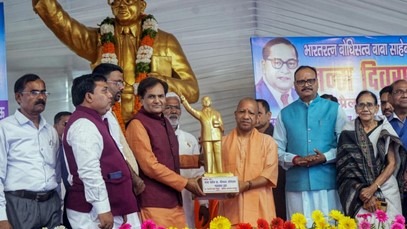
- On the occasion of Bharat Ratna Dr. B. R. Ambedkar’s 135th birth anniversary, Uttar Pradesh Chief Minister Yogi Adityanath announced that the state’s ambitious ‘Zero Poverty’ Mission will be named in honor of Baba Saheb.
- The declaration was made at a commemorative event held at the Ambedkar Mahasabha campus in Lucknow on April 14, 2025.
Honoring a Visionary
- Paying tribute to Dr. Ambedkar, the architect of the Indian Constitution, CM Yogi emphasized the BJP government’s commitment to upholding his ideals.
- He also criticized opposition parties for failing to respect and preserve Ambedkar’s legacy, asserting that the current government is actively working to realize his vision of social justice and equality.
Mission Objectives
- The newly named Zero Poverty Scheme aims to eradicate poverty across Uttar Pradesh—the most populous state in India—by uplifting every underprivileged and deprived individual above the poverty line.
- The initiative will follow a saturation-based approach, ensuring that every eligible family receives the full range of government welfare benefits.
Target Communities
- The scheme will prioritize assistance to marginalized and tribal groups, including:
- Musahar
- Vantangia
- Tharu
- Sahariya
- Gond
- Kol
Comprehensive Benefits
- Under the initiative, beneficiaries will receive a host of essential amenities, including:
- Land allotment
- Housing
- Toilets under the Swachh Bharat Mission
- Pensions
- Ration cards
- Ayushman Bharat health cards
Implementation Strategy
- The state government plans to cover 14 to 15 lakh families in a single phase. Gram Panchayats will play a key role in implementation by identifying 20–25 families in each village who are still excluded from existing welfare schemes.
Support from Central Initiatives
- CM Yogi highlighted the synergy between the new scheme and ongoing central government programs launched under Prime Minister Narendra Modi’s leadership:
- Free ration for 80 crore citizens
- Health insurance for 50 crore people under Ayushman Bharat
- Construction of 12 crore toilets
- Clean cooking fuel for 10 crore households under Ujjwala Yojana
- 45 crore Jan Dhan bank accounts
- 4 crore houses provided under various housing schemes
Political Reactions
- On the same day, BSP chief Mayawati and SP president Akhilesh Yadav also paid homage to Dr. Ambedkar, presenting alternative perspectives on Dalit welfare and his vision for an egalitarian society. Their statements underscored the ongoing political significance of Ambedkar’s legacy in contemporary Indian politics.
Which of the following statements is/are correct regarding the ‘Zero Poverty’ Mission announced in Uttar Pradesh?
- The scheme is named after Bharat Ratna Dr. B. R. Ambedkar.
- It aims to ensure benefits reach only Scheduled Castes.
- The implementation is based on a saturation approach.
- The scheme will cover 80 crore beneficiaries across India.
Select the correct answer using the code below:
A) 1 and 3 only
B) 2 and 4 only
C) 1, 3, and 4 only
D) 1, 2, and 3 only
Answer: A) 1 and 3 only
Explanation: Statement 2 is incorrect because the scheme targets multiple marginalized and tribal communities, not just Scheduled Castes. Statement 4 refers to a central scheme, not the UP-specific mission.
SC Laid Down 3 Month Deadline For President To Assent Bill Reserved By Governor
- In a constitutional milestone, the Supreme Court of India, through its 2023 judgment in State of Tamil Nadu vs. Governor of Tamil Nadu, addressed long-standing ambiguities surrounding Article 201 of the Constitution—pertaining to Presidential assent on State Bills.
- For the first time, the Court introduced a time-bound framework and clarified the scope of constitutional propriety in such matters, thereby reinforcing the values of cooperative federalism and curbing executive arbitrariness.
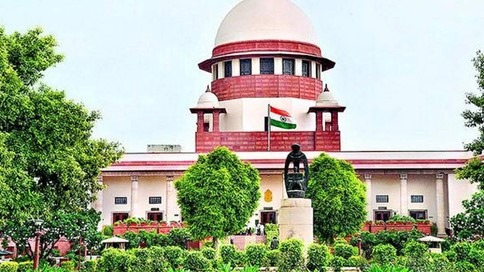
Key Constitutional Provisions Involved
Article 201: Empowers the President to grant or withhold assent to State Bills reserved by the Governor.
Article 143: Allows the President to seek the advisory opinion of the Supreme Court on legal or constitutional questions.
Major Judicial Pronouncements
- Mandating a Time Frame for Presidential Action
- The Court ruled that the President must decide within three months of receiving a State Bill under Article 201.
- Previously, no deadline existed, often resulting in legislative deadlock.
- The Court emphasized that indefinite inaction is arbitrary and violates the Constitution’s spirit.
- Prohibition of an “Absolute Veto”
- The President cannot withhold assent indefinitely, as this would effectively amount to an unconstitutional absolute veto.
- Presidential decisions must be communicated to the State and be legally justified, not based on political grounds.
Judicial Remedies for States
- States are entitled to file writ petitions (e.g., mandamus) in case of prolonged executive inaction on reserved Bills.
- This offers a constitutional check on executive delays, ensuring legislative sovereignty of State Assemblies.
Use of Article 143: Seeking SC’s Advisory Opinion
- In instances where a Governor reserves a Bill citing constitutional invalidity, the Court advised that the President should invoke Article 143 to consult the Supreme Court.
- Though advisory, such opinions are of high persuasive value.
- This mechanism would prevent the enactment of unconstitutional laws, thereby conserving judicial and legislative resources.
Governor vs. President: A Critical Distinction
- If a Governor returns a Bill and it is re-passed by the State Legislature, he is constitutionally bound to assent.
- The President, however, is not similarly bound under Article 201, reinforcing the need for judicial oversight in cases of delay.
- Policy vs. Constitutionality
- The Supreme Court will intervene only when legal or constitutional issues are involved—not when the matter pertains to policy or socio-economic discretion.
- This delineation prevents judicial overreach into legislative or executive domains.
Supporting Recommendations
Sarkaria Commission (1988) and Punchhi Commission (2010):
- Recommended fixed timelines for Presidential decisions under Article 201.
- Advocated invoking Article 143 in cases of constitutional doubts.
MHA Office Memorandums (2016) also prescribed a 3-month timeline, which the Court reinforced through this judgment.
Conclusion
- This judgment marks a transformative moment in Indian federalism by injecting clarity, accountability, and constitutional discipline into the often opaque process of Presidential assent.
- It restores balance between the Union and the States and strengthens the federal fabric envisioned by the Constitution.
Which of the following statements regarding the Supreme Court’s interpretation of Article 201 in State of Tamil Nadu vs. Governor of Tamil Nadu (2023) is/are correct?
- The President must act on a reserved State Bill within a constitutionally mandated time frame of three months.
- The Supreme Court held that the President has absolute discretion to withhold assent without providing reasons.
- The judgment enables States to seek judicial remedy if there is prolonged inaction by the President.
- The Governor is not constitutionally bound to assent even if a Bill is re-passed by the State Legislature.
Select the correct answer using the code below:
A) 1 and 3 only
B) 2 and 4 only
C) 1, 3, and 4 only
D) 1, 2, and 3 only
Answer: A) 1 and 3 only
Explanation:
- Statement 1 is correct: The Court mandated a 3-month deadline for Presidential action.
- Statement 2 is incorrect: The Court explicitly rejected the idea of an “absolute veto”.
- Statement 3 is correct: The judgment allows States to approach courts via writs in case of prolonged inaction.
- Statement 4 is incorrect: It is the Governor who must assent if the Bill is re-passed.
Telangana Becomes First State to Implement SC Sub-Categorisation
Syllabus:Polity
- On April 14, 2025—coinciding with Dr. B.R. Ambedkar’s birth anniversary—the Government of Telangana issued a historic Government Order (GO) to implement the Telangana Scheduled Castes (Rationalization of Reservations) Act, 2025, making it the first state in India to operationalize sub-categorisation among Scheduled Castes (SCs).
- This move aims to equitably redistribute the existing 15% SC reservation by dividing 59 SC sub-castes into three groups based on relative backwardness, ensuring targeted affirmative action.
Key Legislative and Legal Timeline
- Act Passed by Assembly: March 18, 2025
- Governor’s Assent: April 8, 2025
- GO Issued: April 14, 2025 (Ambedkar Jayanti)
- SC Judgment Enabling Sub-Categorisation: August 1, 2024
- Commission Appointed: October 2024
- Commission Head: Justice Shamim Akhtar (Retd.)
Basis for Grouping
- Population size
- Literacy and education access
- Employment rates
- Financial assistance received
- Political participation
- Representations: Over 8,600 received by the commission
Government Justifications
Health Minister Damodar Raja Narasimha:
- “Not a final solution, but a corrective tool for equitable upliftment. Education, skill training, and financial aid are key.”
Civil Supplies Minister N. Uttam Kumar Reddy:
- “No dilution of existing benefits. No creamy layer within SCs. Reservation may rise post-2026 Census (SC population: 17.5%).”
Judicial and Commission Backing
- SC Judgment (Aug 2024): Legally permitted sub-categorisation within SCs
- Justice Shamim Akhtar Commission: Conducted wide consultations and data-driven analysis
Historical Committees Referenced:
- Lokur Committee (1965)
- Justice Ramachandra Raju Commission (1996)
- Usha Mehra Commission (2007)
Political and Social Reactions
- CPI MLA K. Sambasiva Reddy: Criticized the Rella community’s classification into Group 3
- AIMIM MLA Majid Hussain: Suggested increasing SC reservation to 18% and creating 4 sub-categories
- Govt Stand: 3-group system strikes balance—2 groups would underrepresent the most backward; 4 would complicate policy
Consider the following statements about the Supreme Court judgment dated August 1, 2024, regarding SC sub-categorisation:
- It declared sub-categorisation within SCs unconstitutional.
- It laid the legal foundation for Telangana’s move to classify SCs into three groups.
- It emphasized that sub-categorisation cannot be implemented without Parliament’s approval.
Which of the statements is/are correct?
A. 1 only
B. 2 only
C. 1 and 3 only
D. 2 and 3 only
Answer: B
Explanation:
- The SC upheld the validity of sub-categorisation within SCs by states under Article 15(4) and 16(4), enabling Telangana’s Act.
- The Supreme Court, in its August 1, 2024 judgment, did not declare sub-categorisation unconstitutional.
- In fact, it upheld the validity of sub-categorisation of Scheduled Castes by individual states under Articles 15(4) and 16(4), provided it is done rationally and based on empirical data.
Thangjing Hills
Syllabus: Geography
Context:
- The annual pilgrimage by Meitei devotees to the sacred Thangjing Hills in Manipur was recently halted due to objections from the Kuki-Zo community, highlighting the underlying ethnic tensions in the region.
About Thangjing Hills:
- Location:
Situated in the Churachandpur district of western Manipur, forming part of the Thangjing Hill Range.
Topography:
- Elevation: Approximately 2,100 meters (6,900 feet) above sea level.
- Characterized by dense forests, high ridges, and steep terrains.
- Acts as a natural boundary between the Meitei-dominated Imphal Valley and the Kuki-Zo-inhabited hill districts.
Hydrology: The region is watered by rivers such as Leimatak, Tuila, Lanva, and Khuga, with tributaries supporting both hill and valley settlements.
Geopolitical Sensitivity:Lies within a buffer zone that has historically witnessed ethnic contestation and competing claims over land, identity, and religious rights.
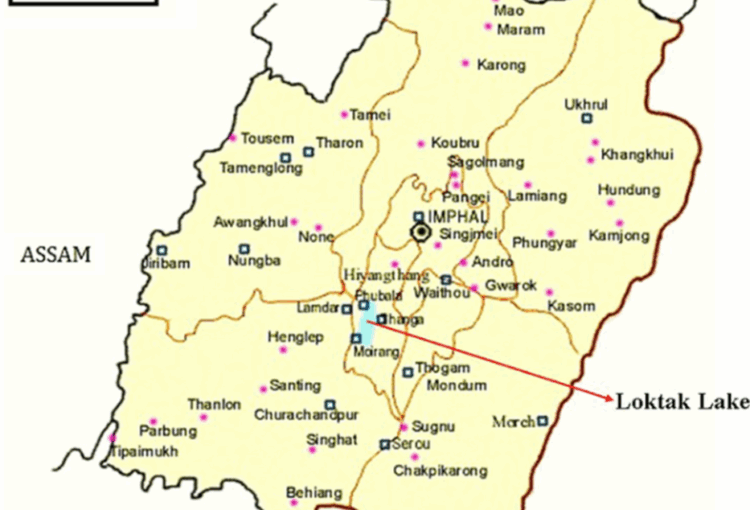
Religious and Cultural Significance:
- Sacred Geography:Revered by the Meitei community as the divine abode of Eputhou Thangjing, a principal deity and protector of southern Manipur.
- Annual Pilgrimage:Conducted during the Meitei lunar month of Sajibu (typically April), especially around the full moon day.
- Mythological Connection:The site is deeply embedded in Meitei cosmology, featuring in cultural epics such as the legendary love story of Khamba and Thoibi.
Which of the following is the primary religious significance of Thangjing Hills in Manipur?
- It is considered the sacred abode of the Meitei deity Eputhou Thangjing.
- The hills are considered a symbol of unity between the Meitei and Kuki-Zo communities.
- The pilgrimage to Thangjing Hills is a part of the Kuki-Zo religious tradition.
- The site is linked to the Khamba-Thoibi legend, central to Meitei mythology.
Select the correct answer using the code below:
A) 1 and 4 only
B) 2 and 3 only
C) 1, 3, and 4 only
D) 1, 2, and 4 only
Answer: A) 1 and 4 only
Explanation:
- Thangjing Hills is regarded as the sacred abode of Eputhou Thangjing, a central Meitei deity.
- It is also linked to the Khamba-Thoibi myth, which is integral to Meitei folklore.
- The opposition from the Kuki-Zo community is rooted in ethnic tensions rather than religious unity, hence the other options are incorrect.
Tamil Nadu Forms High-Level Committee To Strengthening State Autonomy
Syllabus:Polity
- In a significant assertion of federal principles, Tamil Nadu Chief Minister K. Stalin announced the formation of a three-member high-powered committee on April 15, 2025, tasked with a comprehensive review of Centre–State relations, constitutional allocations of power, and intergovernmental fiscal dynamics.
- The move underscores persistent concerns over centralisation and erosion of State autonomy in India’s federal architecture.
Committee Overview
- Constituted by: Tamil Nadu Government
- Chaired by: Justice Kurian Joseph (Retired Supreme Court Judge)
- Other Members:
- Ashok Vardhan Shetty, Retd. IAS & former Vice-Chancellor, Indian Maritime University
- Naganathan, Former Vice-Chairman, Tamil Nadu State Planning Commission
- Interim Report: Due by January 2026
- Final Recommendations: Within two years
Mandate and Scope
- The committee will:
- Scrutinize constitutional provisions, statutes, and policies governing Centre–State relations.
- Recommend the re-transfer of subjects from the Concurrent List to the State List.
- Suggest reforms to enhance administrative and fiscal autonomy of States while maintaining national integrity.
- Examine the Rajamannar Committee (1969), Sarkaria Commission (1983), and Punchhi Commission (2007) reports for precedent and relevance.
Historical Context
- Rajamannar Committee (1969), appointed by DMK founder M. Karunanidhi, had flagged excessive centralisation.
- In 1974, the Tamil Nadu Legislative Assembly formally adopted its recommendations—many of which remain unimplemented.
Key Federal Grievances Raised
- NEET Controversy
- Seen as infringing on State’s education policy autonomy.
- Allegedly disadvantages students from marginalized backgrounds in Tamil Nadu.
- State legislation exempting NEET was withheld Presidential assent, sparking constitutional friction.
- National Education Policy (NEP) 2020
- The three-language formula is perceived as Hindi imposition.
- Funds worth ₹2,500 crore under Samagra Shiksha Abhiyan reportedly withheld.
- Renewed demand to move Education back to the State List.
- Fiscal Centralisation via GST
- Tamil Nadu, a net contributor, receives only ₹0.29 for every rupee it contributes.
- The GST regime has allegedly eroded States’ revenue-raising powers.
- Tamil Nadu’s objections during GST Council deliberations were reportedly disregarded.
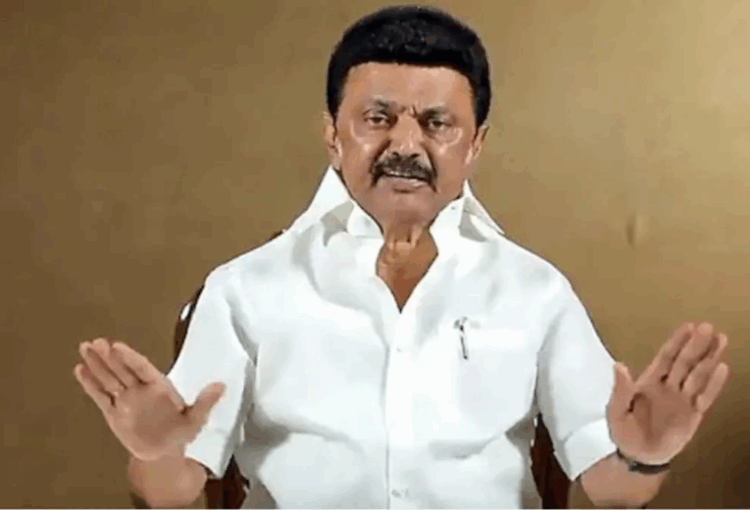
Delimitation 2026
- Based on population, it may reduce Tamil Nadu’s parliamentary seats.
- Seen as punishing states with successful population control policies, violating cooperative federalism norms.
- This institutional move marks a serious federal challenge to the existing Centre-State dynamic. It could serve as a reference point for other states concerned with over-centralisation and the rebalancing of India’s quasi-federal structure.
With reference to the Tamil Nadu High-Level Committee on Centre–State Relations (2025), consider the following statements:
- The committee includes members from both the judiciary and civil services.
- One of its mandates is to recommend restoration of subjects from the Union List to the State List.
- The move revives themes earlier discussed by the Rajamannar and Punchhi Commissions.
- The committee is mandated to submit its final report before the 2026 delimitation process begins.
Which of the above statements is/are correct?
A. 1 and 3 only
B. 1, 2 and 4 only
C. 1 and 2 only
D. 1, 3 and 4 only
Correct Answer: A. 1 and 3 only
Explanation:
- Statement 1: Correct – The committee is chaired by a retired Supreme Court judge and includes a retired IAS officer.
- Statement 2: Incorrect – The recommendation concerns Concurrent List to State List, not Union List.
- Statement 3: Correct – The mandate explicitly refers to past federal commissions, including Rajamannar and Punchhi.
- Statement 4: Incorrect – The committee will submit its interim report by Jan 2026, while final report is due within two years, i.e., after the 2026 delimitation exercise.
Justice BR Gavai Next CJI of India as Successor to Chief Justice Sanjiv Khanna
Syllabus:Polity
- On April 16, 2025, Chief Justice of India (CJI) Sanjiv Khanna formally recommended Justice Bhushan Ramkrishna Gavai, the senior-most puisne judge of the Supreme Court, as his successor.
- The recommendation was sent to the Union Ministry of Law and Justice in accordance with established constitutional convention.
- Upon receiving presidential assent, Justice Gavai will assume office as the 52nd Chief Justice of India following the retirement of CJI Khanna on May 13, 2025.
- Judicial Profile: Justice B.R. Gavai
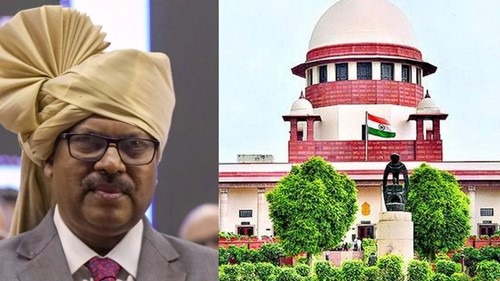
Early Life and Legal Career
- Birthplace: Amravati, Maharashtra.
- Commencement of Practice: Enrolled with the Bar in 1985.
- Worked under Raja S. Bhonsale, former Advocate General of Maharashtra and later a Bombay High Court judge.
- Practised primarily before the Nagpur Bench of the Bombay High Court, specialising in constitutional and administrative law.
Government Appointments
- Appointed as Assistant Government Pleader and Additional Public Prosecutor in 1992–93.
- Promoted to Government Pleader and Public Prosecutor in 2000.
- Judicial Appointments
- Appointed as an Additional Judge of the Bombay High Court in November 2003.
- Made Permanent Judge of the Bombay High Court in November 2005.
- Elevated to the Supreme Court of India in May 2019.
Key Judicial Contributions
- Demonetization Verdict (January 2023)
- Justice Gavai was part of the majority in a 4:1 Supreme Court verdict upholding the constitutionality of the Central Government’s 2016 decision to demonetize ₹500 and ₹1,000 notes. The judgment emphasized Parliament’s legislative competence and the Reserve Bank of India Act framework.
Sub-Categorization within SCs and STs (August 2024)
- In a significant case involving affirmative action, Justice Gavai supported the application of the “creamy layer” principle to Scheduled Castes and Scheduled Tribes. His opinion aimed to ensure targeted benefits for the most disadvantaged within these groups.
Abrogation of Article 370 (December 2019)
- As a member of the Constitution Bench, Justice Gavai upheld the Centre’s decision to abrogate Article 370, thereby revoking the special status granted to the erstwhile state of Jammu & Kashmir. The bench reaffirmed Parliament’s power under Article 356 and Article 370(3).
Critique of Bulldozer Demolitions (November 2024)
- Justice Gavai, in a two-judge bench, condemned the practice of extra-legal demolitions of properties linked to alleged criminals. He emphasized that due process of law must prevail, and state action must adhere to constitutional principles.
Significance of the Appointment
- Justice Gavai’s elevation is not only significant due to his legal acumen but also because he is set to become the second Dalit Chief Justice of India, following Justice K.G. Balakrishnan. His appointment reaffirms the inclusive and meritocratic foundations of India’s higher judiciary.
Consider the following statements regarding Justice B.R. Gavai and his contributions to Indian constitutional jurisprudence:
- Justice Gavai, in his verdict on the abrogation of Article 370, relied primarily on the doctrine of basic structure to uphold the revocation.
- He has been a strong proponent of sub-categorization within Scheduled Castes and Scheduled Tribes, arguing for the application of the creamy layer doctrine to improve intra-group equity.
- As part of the Demonetization verdict, Justice Gavai held that the government had exceeded its authority under Section 26(2) of the RBI Act, thereby dissenting from the majority.
- In 2024, Justice Gavai raised constitutional concerns over the use of bulldozers for punitive demolitions, highlighting violations of the principles of natural justice and rule of law.
Which of the statements given above is/are correct?
A. 2 and 4 only
B. 1, 3 and 4 only
C. 1 and 3 only
D. 2, 3 and 4 only
Answer: A. 2 and 4 only
Explanation:
- Statement 1 – Incorrect: Justice Gavai upheld the abrogation of Article 370 but did not rely on the basic structure doctrine to support the decision. Instead, the judgment was rooted in a textual and procedural interpretation of Article 370(3) and the constitutional provisions relating to Presidential powers during President’s Rule (Article 356).
- Statement 2 – Correct: In the August 2024 case, Justice Gavai supported sub-categorization within SC/STs and proposed the application of the creamy layer principle, a significant judicial position aimed at equitable distribution of affirmative action benefits.
- Statement 3 – Incorrect: Justice Gavai was part of the majority (not dissent) in the 2023 Demonetization verdict. He ruled that the government’s action under Section 26(2) of the RBI Act was constitutionally valid and within the framework of delegated legislation.
- Statement 4 – Correct: Justice Gavai indeed raised concerns in a 2024 judgment against bulldozer-driven demolitions that bypassed due legal process, terming such actions unconstitutional and in violation of Article 14 (equality before the law) and Article 21 (right to life and personal liberty).
Justice Kurian Joseph Committee
- Syllabus:Polity
- In a significant political and constitutional development, Tamil Nadu Chief Minister M.K. Stalin has constituted a high-level committee chaired by former Supreme Court judge Justice Kurian Joseph to reassess Centre–State relations.
- This initiative is aimed at safeguarding the constitutional rights and autonomy of states within the Indian Union, reflecting a long-standing concern over the erosion of federal principles.
Historical Precedent: The Rajamannar Committee (1969)
- This move echoes the path laid down by former Tamil Nadu Chief Minister C.N. Annadurai, whose government established the Centre–State Relations Inquiry Committee under the chairmanship of Dr. P.V. Rajamannar in 1969. This was the first comprehensive state-level review of federal dynamics in India.
- The Rajamannar Committee concluded that while the Constitution embodies a federal framework, its operational reality reflects excessive centralisation. It identified Articles 256, 257, and 365—which empower the Centre to issue directions to states—as central to this imbalance.
Key Recommendations:
- Repeal of Article 356: The Committee called for the abolition of the provision enabling the imposition of President’s Rule in states, viewing it as a tool of political misuse.
- Creation of a Permanent Inter-State Council: To institutionalize Centre–State dialogue and reduce unilateralism.
- Limiting Central Institutions’ Overreach: It criticized the discretionary powers of bodies like the Planning Commission (now defunct), which undermined the constitutionally mandated Finance Commission and increased state dependency.
- The Committee rejected the notion that centralisation equates to national strength, warning that such overreach erodes the Union’s integrity. It instead advocated for cooperative federalism, anchored in constitutional restraint and respect for state sovereignty.
Contemporary Context and Political Undercurrents
- The formation of the new committee comes amid intensifying disputes between Tamil Nadu and the Union Government, especially on contentious issues such as:
- NEET (medical entrance policy),
- GST compensation delays, and
- Language imposition
- These tensions signal growing concerns over asymmetrical federalism, particularly in opposition-led states.
The Road Ahead: Restoring the Federal Balance?
- The new committee is expected to study constitutional provisions, institutional mechanisms, and recent central policies to recommend steps that restore the federal balance. However, implementation remains uncertain, given the historical neglect of earlier commission reports, including the Rajamannar Committee and the Sarkaria Commission (1983) and Punchhi Commission (2007).
- Nonetheless, the formation of this committee underscores a renewed call for federal revitalisation—placing autonomy, fiscal empowerment, and cooperative governance at the centre of India’s democratic discourse.
With reference to the Rajamannar Committee’s recommendations on Centre–State relations, consider the following statements:
- The committee argued that the Finance Commission’s role had been constitutionally diluted due to the discretionary powers exercised by the Planning Commission.
- It endorsed the use of Article 356 as a necessary constitutional safeguard against political instability in the states.
- The committee proposed the establishment of an Inter-State Council to institutionalize federal dialogue beyond mere administrative coordination.
Which of the statements given above is/are correct?
A. 1 and 2 only
B. 1 and 3 only
C. 2 and 3 only
D. 1, 2 and 3
Answer: B. 1 and 3 only
Explanation:
- Statement 1 is correct: The Rajamannar Committee highlighted how the Planning Commission’s discretionary grant-giving powers diminished the relevance of the constitutionally mandated Finance Commission.
- Statement 2 is incorrect: The committee opposed Article 356 and recommended its repeal, arguing that it undermined federalism.
- Statement 3 is correct: The committee advocated for a permanent and empowered Inter-State Council to facilitate structured Centre–State dialogue.
Fisheries Development Initiatives Under PM Matsya Sampada Yojana
Syllabus:Scheme
- Launched in 2020, the Pradhan Mantri Matsya Sampada Yojana (PMMSY) is a flagship initiative aimed at transforming India’s fisheries sector through modernization, sustainability, and socio-economic empowerment of stakeholders.
- With a total outlay of ₹20,050 crore, the scheme is set to operate until 2025, representing one of the most comprehensive government efforts to harness the potential of the blue economy.
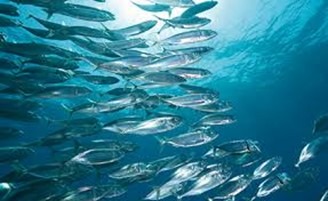
Structural Components of PMMSY
The scheme is bifurcated into two implementation models:
- Central Sector Scheme (CS): Entirely financed by the Union Government, this component undertakes national-level activities like policy reforms, deep-sea fishing, and technology adoption.
- Centrally Sponsored Scheme (CSS): Jointly funded by the Centre and States/UTs, this component covers diverse projects such as infrastructure development, post-harvest management, and fisher welfare.
Recent Developments and Innovative Interventions
In Karaikal, the Union Minister George Kurian recently launched several PMMSY initiatives, including:
- Establishment of artificial reefs to enhance marine biodiversity and coastal livelihoods.
- Financial support for mechanized boats, life-saving equipment, and climate-resilient housing.
- Collaboration with institutions such as IIT-Madras to advance R&D in sustainable fisheries practices.
- These steps align with the scheme’s thrust on resilience, technology adoption, and community empowerment.
Broad-Based Beneficiary Coverage
- PMMSY targets a wide stakeholder base, including:
- Traditional and inland fishers, aquaculture farmers, and processing workers.
- Cooperatives, self-help groups, and entrepreneurial entities involved in the fisheries value chain.
- Special attention is given to marginalized coastal and inland communities, ensuring inclusive development.
Macroeconomic Relevance
- The fisheries sector contributes significantly to India’s Gross Value Added (GVA) and exports.
- In FY 2022–23, India achieved 175.45 lakh tonnes in fish production, making it the third-largest producer globally.
- The sector supports around 30 million people, offering both livelihood security and nutritional support.
Vision and Future Roadmap
- PMMSY is aligned with the government’s long-term goal of “Viksit Bharat @2047” and envisions:
- Doubling fish production and boosting exports to ₹1 lakh crore.
- Enhancing income of fishers and reducing post-harvest losses.
- Creating a climate-smart, resilient, and technology-enabled fisheries ecosystem.
Technology as a Force Multiplier
- Deployment of drone technology for inland fish seed transportation.
- Utilization of ISRO’s satellite data to help fishermen identify Potential Fishing Zones (PFZs).
- Emphasis on digital traceability, eco-labelling, and smart cold-chain logistics.
In the context of PMMSY, which of the following technological interventions serve both ecological and livelihood objectives?
- Establishment of artificial reefs
- Use of ISRO’s satellite-based Potential Fishing Zone data
- Drone deployment for inland seed transportation
- Climate-resilient housing for fishers
Select the correct answer using the code below:
A. 1, 2 and 3 only
B. 2, 3 and 4 only
C. 1 and 2 only
D. 1, 2, 3 and 4
Answer: D. 1, 2, 3 and 4
Explanation: All four interventions mentioned contribute to both ecological and socio-economic goals. Artificial reefs improve marine biodiversity and fish stock, benefiting coastal livelihoods. ISRO’s satellite data enhances fish catch efficiency. Drone tech supports inland aquaculture logistics. Climate-resilient housing reduces disaster vulnerability for fishers. Together, they integrate environmental sustainability with economic resilience.
PEN-Plus Strategy Enhances NCD Care in Africa
Syllabus:Schemes
- In recent years, non-communicable diseases (NCDs) have emerged as a significant public health challenge across the WHO African Region.
- A recent report by the World Health Organization (WHO) has highlighted the effectiveness of the PEN-Plus strategy—an integrated, decentralised approach to managing severe NCDs at the primary and secondary healthcare levels.
- Since its adoption, 20 African nations have strengthened their healthcare systems, enhancing access to life-saving services for populations historically underserved.

Understanding Non-Communicable Diseases (NCDs):
- NCDs are long-term chronic conditions not caused by infectious agents.
- Their progression is often slow and influenced by genetic predisposition, environmental exposures, and behavioural risk factors.
- Major NCDs include cardiovascular diseases, diabetes, chronic respiratory illnesses, and cancers.
- While NCDs account for 71% of global mortality, their contribution to overall deaths in African countries ranges widely—from 27% to 88%, underscoring deep disparities in healthcare access and disease burden.
The PEN-Plus Framework:
- The PEN-Plus initiative builds upon the WHO’s broader Package of Essential Non-communicable Disease Interventions (PEN), extending its scope to cover severe and chronic NCDs.
- Originating in Rwanda, the model focuses on bringing essential diagnostics, treatment, and psychosocial care closer to communities—particularly those living in extreme poverty.
- It empowers mid-level healthcare providers at district hospitals and health centres through structured training programmes, ensuring that severe conditions are not excluded from primary care systems.
Implementation and Tangible Outcomes:
- The strategy has gained traction in countries such as Liberia, Malawi, and Rwanda, with encouraging results.
- As of January 2025, over 15,000 patients have received care under the PEN-Plus model.
- In Malawi, national roll-out has seen the training of over 440 clinicians, with six district-level facilities currently managing more than 300 patients with complex NCDs.
- This marks a significant shift toward health equity in the region.
Persistent Challenges and Strategic Priorities:
- Despite measurable progress, substantial gaps remain.
- Many children and young adults continue to succumb to preventable and treatable NCDs, primarily due to delayed diagnosis and lack of local treatment options.
- The WHO report calls for sustained investment, inter-governmental coordination, and prioritisation of NCDs in national and international policy agendas.
- Strengthening political will and mobilising global partnerships are imperative to ensure long-term success.
Building Resilient Health Systems:
- At the core of PEN-Plus lies a vision for sustainable, decentralised health systems.
- The approach emphasises the need for standardised clinical protocols, reliable access to essential medicines and technologies, and scalable infrastructure at district-level hospitals.
- By bridging the treatment gap for severe NCDs, the model contributes significantly to universal health coverage (UHC) and the broader goals of health justice in sub-Saharan Africa.
With reference to the PEN-Plus strategy endorsed by the WHO for managing non-communicable diseases (NCDs) in Africa, consider the following statements:
- The PEN-Plus model focuses exclusively on communicable diseases with chronic manifestations such as tuberculosis.
- The strategy is designed to deliver care for severe NCDs at secondary and tertiary hospitals only.
- A core feature of PEN-Plus is the empowerment of mid-level healthcare providers at district-level facilities through structured training.
Which of the statements given above is/are correct?
A. 1 and 2 only
B. 3 only
C. 2 and 3 only
D. 1, 2 and 3
Answer: B. 3 only
Explanation:
- Statement 1 is incorrect because PEN-Plus is specifically targeted at severe non-communicable diseases, not communicable diseases like tuberculosis.
- Statement 2 is incorrect as the model decentralises care by focusing on primary and secondary health facilities, not tertiary hospitals alone.
- Statement 3 is correct. The strategy emphasises training mid-level providers at district hospitals to ensure equitable delivery of care to underserved populations.
India and Russia Approved Strategic Projects
Syllabus: GS 2/IR
India–Russia Strategic Cooperation: Key Highlights
In the News
- India and Russia have agreed to initiate six new strategic investment projects during the 8th Session of the India-Russia Working Group on Priority Investment Projects (IRWG-PIP), held in New Delhi.
Background: Evolution of the Partnership
- The foundation of modern India-Russia relations was laid with the “Declaration on Strategic Partnership” signed in October 2000, during President Vladimir Putin’s visit to India.
- In 2010, the partnership was further elevated to a “Special and Privileged Strategic Partnership,” reflecting deepening engagement across various sectors—defense, economic cooperation, science & technology, and cultural exchange.
8th IRWG-PIP Session: Key Outcomes
Six new strategic projects were approved, focusing on:
- Trade and commerce
- Technological innovation
- Economic development and investment
- The IRWG-PIP functions under the India-Russia Intergovernmental Commission on Trade, Economic, Scientific, Technological, and Cultural Cooperation (IRIGC-TEC).
Strategic Significance
- Enhancing Economic Resilience: Promotes diversification of trade and investment, reducing dependence on traditional partners.
- Strategic Autonomy: Aligns with India’s foreign policy of balancing major powers in a multipolar world.
- Boost to Domestic Initiatives: Supports ‘Make in India’ and Atmanirbhar Bharat through technology transfer and local manufacturing.
- Geopolitical Advantage: Expands India’s engagement with Eurasia, enhancing its strategic footprint.
India–Russia Economic Relations
- Historical Ties: Bilateral trade has grown from USD 1.4 billion in 1995 to approximately USD 65.7 billion in FY 2023–24.
Trade Composition:
- India’s exports: Pharmaceuticals, agricultural products, chemicals, and machinery.
- Russia’s exports: Crude oil, fertilizers, mineral fuels, and metals.
- Target: Both nations aim to achieve USD 100 billion in bilateral trade by 2030.
Institutional Mechanisms Supporting Ties
- IRIGC-TEC: Comprises 15 Working Groups and 6 Sub-Groups, covering diverse sectors.
- India-Russia Strategic Economic Dialogue (IRSED): Facilitates high-level economic coordination.
Multilateral Cooperation
- India and Russia maintain close coordination at major international forums:
- United Nations (UN)
- BRICS
- Shanghai Cooperation Organisation (SCO)
- G20
India’s presidency of the G20 and SCO in 2023 facilitated numerous bilateral meetings on the sidelines.
Defence and Strategic Cooperation
- India and Russia have a robust defense partnership characterized by both supply and co-development projects:
- S-400 Triumf missile systems
- Licensed production of T-90 tanks and Su-30 MKI aircraft
- Supply of MiG-29s, Kamov helicopters
- INS Vikramaditya (formerly Admiral Gorshkov)
- AK-203 assault rifles (joint production in India)
- BrahMos missiles (jointly developed and exported)
With reference to the India-Russia Intergovernmental Commission on Trade, Economic, Scientific, Technological and Cultural Cooperation (IRIGC-TEC), consider the following statements:
- It includes more than ten Working Groups and multiple Sub-Groups to facilitate sectoral cooperation.
- The IRIGC-TEC is a ministerial-level mechanism that reports directly to the UN Security Council.
- One of its objectives is to coordinate economic cooperation aligned with the BRICS development agenda.
Which of the statements given above is/are correct?
A. 1 only
B. 1 and 3 only
C. 2 and 3 only
D. 1, 2 and 3
Answer: A. 1 only
Explanation:
- Statement 1 is correct – The IRIGC-TEC includes 15 Working Groups and 6 Sub-Groups.
- Statement 2 is incorrect – It is a bilateral mechanism between India and Russia, not linked to the UN Security Council.
- Statement 3 is incorrect – While India and Russia coordinate within BRICS, the IRIGC-TEC is not designed explicitly to align with the BRICS development agenda.
India Ends Transshipment for Bangladesh Exports
Syllabus: GS2/IR
Context
- India has officially withdrawn the transshipment facility that previously allowed Bangladesh to export goods to third countries via Indian land customs stations, ports, and airports, marking a significant development in regional trade logistics.
About the Transshipment Agreement
- Introduced in 2020 by India’s Central Board of Indirect Taxes and Customs (CBIC).
- Aimed at enhancing regional trade cooperation and logistics efficiency for Bangladesh by enabling its cargo to transit through Indian infrastructure.
- Facilitated seamless Bangladeshi exports to Europe, West Asia, and other global destinations via India’s multimodal transport network.
Why Was It Revoked?
- Primary Concern: Rising logistical congestion at Indian airports and ports.
Resulted in:
- Delays in India’s own export consignments.
- Backlogs in cargo handling.
- Escalation in operational costs for Indian exporters.
- Decision aligns with India’s need to prioritize domestic trade efficiency amidst increasing global trade competitiveness.
Implications for Bangladesh
- Expected to increase logistics costs and transit time for Bangladeshi exports, especially to Western markets.
- Could potentially divert Bangladesh’s trade alignment toward alternate regional corridors, possibly involving Chinese infrastructure partnerships.
India-Bangladesh Relations: A Comprehensive Overview
Historical Foundations
- 1971 Liberation War: India’s support for the Bengali nationalist movement laid the groundwork for robust bilateral ties.
- Land Boundary Agreement (2015): Resolved a 70-year-old dispute by exchanging enclaves and streamlining borders.
- Connectivity Milestones
Rail Connectivity:
- Revival of five pre-1965 rail links.
- Operational trains: Maitri Express, Bandhan Express, Mitali Express.
Cross-Border Infrastructure:
- Inauguration of Akhaura–Agartala rail link improves access to Northeast India.
- Economic Interdependence
Trade Volume (FY 2023–24):
- Total Bilateral Trade: US$ 12.90 billion
- Indian Exports to Bangladesh: US$ 11.06 billion
- Bangladesh is India’s largest trading partner in South Asia; India is Bangladesh’s second largest partner in Asia.
- Trade Frameworks
Multilateral Trade Agreements:
- Asia-Pacific Trade Agreement (APTA)
- SAARC Preferential Trade Agreement (SAPTA)
- South Asian Free Trade Area (SAFTA)
- Regional and Strategic Cooperation
- Active participation in SAARC and BIMSTEC.
Joint Military Exercises:
- Sampriti (Army)
- Milan (Navy)
Energy Security:
- Bangladesh imports ~2,000 MW of electricity from India.
Challenges in Bilateral Engagement
Border Security Issues:
- Despite LBA, illegal crossings, smuggling, and occasional border skirmishes
Teesta Water Dispute:
- Long-pending issue causing political tension and water stress.
Trade Imbalance:
- Heavy tilt in favor of India triggers economic anxieties in Bangladesh.
Cross-border Migration:
- Sensitive issue in Indian domestic politics, especially in Assam and West Bengal.
Security Threats:
- Extremist groups and cross-border smuggling require continuous vigilance.
China’s Expanding Footprint:
- Strategic investments in Bangladesh’s infrastructure and defense seen as a challenge to India’s traditional sphere of influence.
Way Forward
- India must balance national logistics interests with its commitment to regional cooperation.
- Bangladesh remains a critical strategic ally in South Asia:
- Shares the longest land boundary with India.
- Acts as a gateway to the Northeast.
Strategic roadmap should include:
- Revitalizing dialogue on water sharing and trade.
- Collaborating on green logistics and port infrastructure.
- Enhancing people-to-people ties and cultural diplomacy.
Conclusion
- India-Bangladesh relations are a blend of shared history, economic interdependence, and strategic cooperation.
- While the revocation of the transshipment facility signals logistical recalibration, sustained diplomatic engagement and policy innovation are essential to ensure that the bilateral relationship continues to evolve on the pillars of mutual respect, economic pragmatism, and regional integration.
Consider the following statements regarding the transshipment facility extended by India to Bangladesh:
- It allowed Bangladeshi goods to transit through Indian ports and airports for export to third countries.
- It was introduced by India’s Ministry of External Affairs in 2020.
- The facility was revoked primarily due to strategic concerns over China’s growing influence in Bangladesh.
Which of the statements is/are correct?
A) 1 only
B) 1 and 2 only
C) 1 and 3 only
D) 1, 2 and 3
Answer: A) 1 only
- Explanation:
Statement 1 is correct – the facility allowed Bangladeshi cargo to transit through Indian infrastructure to reach global markets. - Statement 2 is incorrect – the scheme was introduced by the Central Board of Indirect Taxes and Customs (CBIC), not the Ministry of External Affairs.
- Statement 3 is incorrect – the facility was revoked due to logistical congestion, not directly because of geopolitical concerns.
The Magic of Indian Silk
Syllabus: GS3/ Economy
India’s Silk Sector: An Introduction
- India’s raw silk production has witnessed a consistent upward trajectory, increasing from 31,906 metric tonnes (MT) in 2017–18 to 38,913 MT in 2023–24, reflecting strategic interventions and government support.
What is Sericulture?
- Sericulture refers to the cultivation of silkworms for silk production. The process involves:
- Rearing silkworms primarily on mulberry, oak, castor, and arjun
- Within a month, the worms spin cocoons.
- The cocoons are harvested, boiled to loosen the threads, and silk fibers are reeled, twisted into yarn, and woven into fabrics.
Lifecycle of the Silkworm Moth:
- Egg →
- Larva (caterpillar/silkworm) →
- Pupa (inside cocoon) →
- Moth (adult stage)
India’s Position in the Global Silk Industry
- India is the second-largest producer and consumer of silk
- Despite this, silk comprises only 2% of total global textile production.
- India produces four varieties of natural silk:
- Mulberry (dominant)
- Eri
- Tasar
- Muga
- Major Silk-Producing States
- Karnataka (largest producer)
- Followed by: Andhra Pradesh, West Bengal, Tamil Nadu, Uttar Pradesh
Silk Production & Export Trends
- Exports of silk and silk goods increased from ₹1,649.48 crore in 2017–18 to ₹2,027.56 crore in 2023–24.
- In 2023–24, India exported 3,348 MT of silk waste, which includes leftover or imperfect silk such as broken fibers and cocoon fragments.
Key Government Initiatives
- Silk Samagra Scheme
- Launched to enhance silk production and quality, while empowering underprivileged and rural families through sericulture.
It includes four key components:
- Research & Development, Training, Technology Transfer, and IT Initiatives
- Seed Production and Supply Chains
- Market Coordination and Infrastructure Development
- Quality Certification, Export Branding, and Technology Upgradation
- North East Region Textile Promotion Scheme (NERTPS)
- Specifically targets sericulture development in North-Eastern States.
- Focus on promoting Eri and Muga silk, which are indigenous to the region.
- Aims to revive, diversify, and expand silk-based livelihoods in the region.
- Indian Silk Export Promotion Council (ISEPC)
- Sponsored by the Ministry of Textiles.
- Apex body for exporters, manufacturers, and traders of silk.
Functions:
- Explore international markets
- Organize trade fairs, buyer-seller meets
- Resolve trade disputes
- Strengthen export competitiveness
Conclusion
- Sericulture in India is more than an industry—it’s a source of sustainable rural livelihood, cultural heritage, and economic growth. Through dedicated schemes like Silk Samagra and institutional support via ISEPC, India continues to boost its silk production, quality, and global outreach, with a strong focus on inclusive development and traditional skills.
Consider the following statements regarding the varieties of silk produced in India:
- Eri and Muga silks are exclusively reared on mulberry leaves.
- Mulberry silk accounts for the majority share in India’s overall silk output.
- Muga silk is traditionally associated with Assam and is known for its golden sheen.
Which of the statements given above is/are correct?
A) 2 and 3 only
B) 1 and 3 only
C) 3 only
D) 1, 2 and 3
Answer: A) 2 and 3 only
Explanation:
- Statement 1 is incorrect: Eri and Muga silkworms are non-mulberry varieties. Mulberry leaves are specific to Mulberry silk.
- Statement 2 is correct: Mulberry is the dominant variety produced in India.
- Statement 3 is correct: Muga silk, native to Assam, is noted for its natural golden luster and is culturally significant in the region.
Naxalmukt Bharat Abhiyan: From Red Zones to Growth Corridors
Syllabus: GS3/ Internal Security
Genesis of the Naxalite Movement
- The Naxalite movement traces its roots to Naxalbari village in West Bengal (1967), where a radical leftist uprising emerged advocating land redistribution and tribal rights.
- Drawing ideological inspiration from Maoist doctrines, it rapidly transformed into an armed insurgency targeting the Indian state.
Geographical Spread: The Red Corridor
- The insurgency expanded across the “Red Corridor”, encompassing parts of:
- Chhattisgarh, Jharkhand, Odisha, Maharashtra
- West Bengal, Andhra Pradesh, Telangana
- Madhya Pradesh, Kerala
This region has historically been marked by socio-economic backwardness, poor governance, and tribal marginalization—fertile ground for extremist ideologies.
Nature and Modus Operandi
Naxalite groups engage in:
- Guerrilla warfare and ambushes targeting state forces and infrastructure
- Extortion and taxation of local populations
- Child recruitment and radicalization
- Sabotage of developmental initiatives to maintain control
While projecting themselves as protectors of the oppressed, their methods often perpetuate fear and lawlessness.
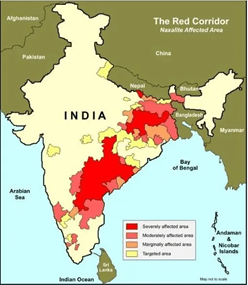
Consequences of Naxalism
- Political Impacts
- Erodes state authority and weakens democratic institutions
- Creates governance vacuums, making administration ineffective
- Economic Impacts
- Disrupts agriculture, mining, and infrastructure projects
- Escalates public expenditure on security, crowding out development
- Deters private investment in high-risk regions
- Social Impacts
- Fuels alienation and mistrust among tribal and rural communities
- Hampers access to healthcare, education, and public services
- Undermines human development indices in affected zones
India’s Progress Against LWE
Significant Improvements (2010–2024):
- Reduction in LWE-affected districts: From 126 in 2010 to 38 in 2024
- Violence down by 81%: From 1,936 incidents in 2010 to 374 in 2024
- Over 8,000 cadre surrenders in the last decade
Enhanced developmental outreach, with visible improvements in:
- Connectivity
- Healthcare and education
- Governance and administrative presence
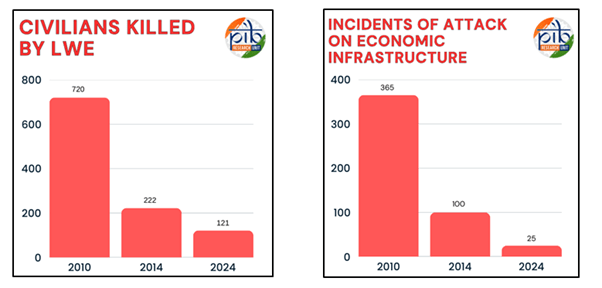
Key Government Initiatives
- Security Related Expenditure (SRE) Scheme
- Sub-scheme under the Modernization of Police Forces (MPF)
- Reimbursement of security-related costs for LWE-affected districts
- SAMADHAN Strategy
- A multi-pronged approach:
- Smart Leadership
- Aggressive Strategy
- Motivation and Training
- Actionable Intelligence
- Dashboard-based Monitoring (KPIs/KRAs)
- Harnessing Technology
- Localized Action Plans
- Financial Deprivation of Extremist Networks
- Fortified Police Stations
- 612 stations built in high-risk zones to enhance security and outreach
- Aspirational Districts Programme
- The Ministry of Home Affairs oversees 35 LWE-affected districts
- Focus on health, education, infrastructure, and livelihood generation
- Special Central Assistance (SCA)
- ₹30 crore/year to most-affected districts
- ₹10 crore/year to “Districts of Concern”
- Aimed at bridging infrastructure gaps and accelerating development
Way Forward
- Community Engagement
- Empower tribal institutions and promote participatory governance
- Initiate confidence-building measures with local populations
- Education and Employment
- Provide skill development, education, and employment avenues
- Target youth populations to prevent radicalization and recruitment
- Technological Integration
- Deploy advanced surveillance, communication systems, and intelligence tools
- Promote e-governance and digital inclusion
Conclusion: Towards a Naxal-Free India
- The Government of India aims to eliminate Left-Wing Extremism by March 31, 2026, recognizing it as a key barrier to inclusive growth in tribal and remote regions.
- The success of the “Naxalmukt Bharat Abhiyan” rests on a balanced strategy that combines:
- Robust security operations
- Sustainable development
- Empowered local governance
- With sustained political will, administrative coordination, and local participation, the vision of a LWE-free India is well within reach.
Which of the following elements of the Government’s SAMADHAN Strategy directly aim at dismantling the financial and operational capacity of Naxalite groups?
- Actionable Intelligence
- Harnessing Technology
- No Access to Financing
- Action Plans for Each Theatre
A) 1 and 2 only
B) 2 and 4 only
C) 3 and 4 only
D) 1, 2, and 3 only
Answer: D) 1, 2, and 3 only
Explanation: Actionable intelligence helps in intercepting extortion networks, while harnessing technology enables tracking of financial channels and movements. “No Access to Financing” explicitly targets the economic backbone of LWE. “Action Plans for Each Theatre” is operational, not financial.
India-Middle East-Europe Economic Corridor (IMEEC)
Syllabus:Summits
Why in News?
- India and Italy have reaffirmed their commitment to enhancing strategic cooperation across critical sectors, following a high-level meeting in April 2025 between External Affairs Minister Dr. S. Jaishankar and Italian Deputy Prime Minister Antonio Tajani.
- The dialogue centered around the Joint Strategic Action Plan (JSAP) 2025–2029, a comprehensive roadmap unveiled during the bilateral meeting between Prime Minister Narendra Modi and Italian Prime Minister Giorgia Meloni in November 2024, on the sidelines of the G20 Summit in Rio de Janeiro.
Key Pillars of India–Italy Cooperation under JSAP (2025–2029)
The strategic agenda aims to diversify and deepen collaboration in the following domains:
- Trade and Investment
- Defence and Security
- Clean Energy Transition
- High-Technology and Digital Infrastructure
- Space and Scientific Research
- People-to-People and Educational Exchanges
- Emerging sectors for enhanced synergy include:
- Artificial Intelligence (AI)
- Cybersecurity and Telecommunications
- Renewable Energy and Biofuels
- Higher Education and Youth Mobility
India–Middle East–Europe Economic Corridor (IMEEC)
- The India–Middle East–Europe Economic Corridor (IMEEC) is a landmark multimodal connectivity initiative aimed at enhancing trade and transport infrastructure between India, the Middle East, and Europe.
Launch and Strategic Significance
- Officially launched during the G20 Summit in New Delhi (2023) through a Memorandum of Understanding (MoU) involving:
India, UAE, Saudi Arabia, France, Germany, Italy, the European Union, and the United States. - IMEEC is embedded within the broader Partnership for Global Infrastructure and Investment (PGII), an initiative introduced at the G7 Summit 2021 (UK).
- It is widely perceived as a strategic alternative to China’s Belt and Road Initiative (BRI), offering a transparent and rules-based infrastructure framework.
Structure of IMEEC
- The Corridor is divided into two major components:
- Eastern Corridor – Linking India with the Gulf region via maritime and railway routes.
- Northern Corridor – Connecting Gulf countries to Europe, primarily through land and port infrastructure.
Conclusion
- The deepening of India–Italy relations and the operationalization of IMEEC underscore India’s proactive approach to multilateral connectivity, strategic autonomy, and global trade realignment.
- Together, these developments reflect India’s evolving role in shaping a multipolar, rules-based international order anchored in inclusive growth and sustainable infrastructure.
With reference to the India–Middle East–Europe Economic Corridor (IMEEC), consider the following statements:
- It is a transcontinental connectivity initiative announced at the G20 Summit in New Delhi.
- The United States is a signatory and full infrastructure partner in the IMEEC.
- The corridor aims to link India to Europe via Central Asia and Afghanistan.
Which of the above statements is/are correct?
A) 1 only
B) 1 and 2 only
C) 1 and 3 only
D) 1, 2 and 3
Answer: A) 1 only
Explanation:
- Statement 1 is correct – IMEEC was announced during the G20 Summit in New Delhi in 2023.
- Statement 2 is incorrect – The US is a strategic partner in the initiative, not a full infrastructure partner.
- Statement 3 is incorrect – IMEEC connects India to Europe via the Middle East (UAE, Saudi Arabia), not through Central Asia or Afghanistan.
India–Norway Marine Pollution Initiative
Syllabus:IR
- The India–Norway Marine Pollution Initiative (INMPI) has played a pivotal role in reducing plastic waste and enhancing waste circularity in Agra, significantly minimizing plastic leakage into the Yamuna River.
- Notably, the initiative has achieved successes in managing petha and footwear waste, contributing to improved local environmental practices.
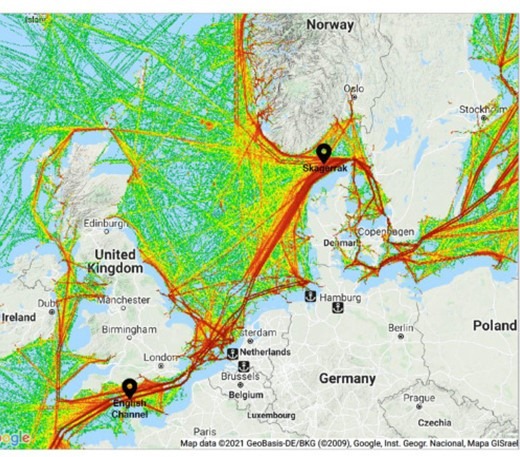
About the India–Norway Marine Pollution Initiative (INMPI)
- The INMPI is a bilateral collaboration between the Government of India and the Government of Norway.
- The initiative primarily aims to address marine litter, with a focus on microplastics (MPs) and macroplastics that originate from land-based sources.
- Launched: 2019, under the framework of the India–Norway Ocean Dialogue.
Objectives:
- Reduce plastic and microplastic pollution in aquatic ecosystems, especially in rivers and oceans.
- Support the circular economy through efficient waste management practices.
- Promote policy reform, local action, and scientific research to combat plastic pollution.
- Assist municipalities with evidence-based strategies to reduce plastic leakage.
Key Features of the INMPI
- Technical Support: The initiative provides technical assistance to Indian cities through leading environmental organisations, including the Centre for Science and Environment (CSE).
- Pilot Projects: The initiative has conducted pilot projects in riverine cities like Agra, focusing on waste management and plastic pollution reduction.
Research Focus: It includes studies on:
- Pre-consumer industrial waste.
- Plastic drainage leakage.
- Microplastic contamination in water bodies.
- Policy Influence: The initiative uses tools such as brand audits, polymer categorisation, and scientific sampling to inform policy decisions and foster sustainable solutions.
With reference to the India–Norway Marine Pollution Initiative (INMPI), consider the following statements:
- It aims exclusively at reducing marine litter from ocean-based sources such as fishing vessels and oil rigs.
- The initiative operates under the broader umbrella of the India–Norway Ocean Dialogue and promotes circular economy principles.
- It provides direct financial aid to Indian municipal corporations for implementing plastic waste management reforms.
- One of its key components includes conducting scientific assessments such as brand audits and polymer categorisation to inform policy action.
Which of the statements given above is/are correct?
A) 2 and 4 only
B) 1, 3, and 4 only
C) 2 only
D) 1, 2, and 3 only
Answer: A) 2 and 4 only
- Statement 1: “It aims exclusively at reducing marine litter from ocean-based sources such as fishing vessels and oil rigs.”
- Statement 2: “The initiative operates under the broader umbrella of the India–Norway Ocean Dialogue and promotes circular economy principles.”
- Statement 3: “It provides direct financial aid to Indian municipal corporations for implementing plastic waste management reforms.”
- Statement 4: “One of its key components includes conducting scientific assessments such as brand audits and polymer categorisation to inform policy action.”
Japan’s High-Speed Train Collaboration with India
Syllabus:IR
- India is poised to advance its high-speed rail infrastructure with strategic support from Japan, which has agreed to provide two Shinkansen trains—models E5 and E3—free of cost. These trains will serve as test platforms for the Mumbai–Ahmedabad High-Speed Rail (MAHSR) corridor, India’s inaugural bullet train project.
Shinkansen: Hallmark of Technological Precision
- The Shinkansen, Japan’s pioneering high-speed rail network, commenced operations in 1964, aligning with the Tokyo Olympics. Known globally for their operational excellence, these trains combine high velocity (up to 320 km/h for E5) with unparalleled safety standards. The E3 model, while an older generation, continues to demonstrate reliable engineering and robust safety features.
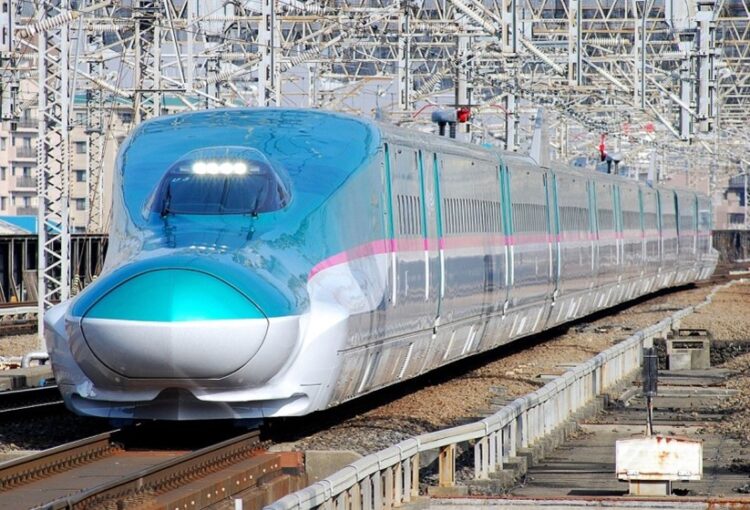
Strategic Deployment and Data-Driven Development
- The E5 and E3 units, scheduled for delivery to India in early 2026, will be outfitted with advanced inspection and data acquisition systems. These systems will monitor diverse environmental and operational conditions in Indian terrain. Insights from this testing phase will inform the design of the next-generation E10 trains, projected to enter service in the early 2030s.
Financial Architecture of the MAHSR Project
- The Mumbai–Ahmedabad corridor is predominantly financed through a concessional loan provided by the Japan International Cooperation Agency (JICA), covering nearly 80% of the project’s initial estimated cost of 1.8 trillion yen. With cost escalations over time, both nations are negotiating a revised funding framework to sustain project momentum.
Historical Legacy of Shinkansen
- The Tokyo–Osaka Shinkansen line, the world’s first of its kind, dramatically reduced intercity travel time and set the global benchmark for high-speed rail systems. Since then, Japan’s network has expanded extensively, integrating major urban centres through a system renowned for punctuality, safety, and technological resilience.
Engineering Challenges and Innovations
- Japan’s seismic vulnerability has necessitated state-of-the-art rail engineering, with Shinkansen trains incorporating seismic detection and automatic braking systems. Notably, no fatal derailments have occurred due to earthquakes since the system’s inception, underscoring its rigorous safety protocols.
Global Technological Diffusion
- The Shinkansen model has had a transformative influence on global rail systems. Countries such as France, China, and Spain have adopted or adapted similar technologies. China, in particular, has developed the world’s most extensive high-speed rail network, often building on foundational research from nations like Japan.
Future Trajectories: From ALFA-X to Maglev
- Japan continues to push the boundaries of rail innovation. The ALFA-X prototype, currently under testing, aims to reach operational speeds of 400 km/h. Furthermore, Japan’s maglev (magnetic levitation) project—the Chuo Shinkansen—is set to revolutionise intercity travel, significantly reducing journey times through ultra-high-speed, contactless rail systems.
With reference to India’s collaboration with Japan on high-speed rail technology, consider the following statements:
- The Shinkansen E5 and E3 models provided to India will be used exclusively for passenger operations on the Mumbai–Ahmedabad corridor after 2026.
- The concessional loan from the Japan International Cooperation Agency (JICA) initially financed over three-fourths of the Mumbai–Ahmedabad bullet train project’s total cost.
- Japan’s ALFA-X and maglev train projects represent the next phase in high-speed rail, but both are already operational on select domestic routes.
- India’s adoption of Shinkansen technology is intended not only to reduce travel time but also to test resilience under seismic and environmental stress, based on local terrain.
Which of the statements given above is/are correct?
A. 1 and 3 only
B. 2 and 4 only
C. 2 only
D. 1, 2 and 4 only
Answer: B. 2 and 4 only
Explanation:
- Statement 1 is incorrect. The E5 and E3 Shinkansen units being provided to India are not intended for direct passenger use but for testing purposes, particularly for environmental data collection and system calibration for the Mumbai–Ahmedabad bullet train corridor.
- Statement 2 is correct. The project is majorly funded by a low-interest loan from JICA, covering approximately 80 percent (or over three-fourths) of the original estimated cost of the bullet train corridor, making this a correct assessment of the financial architecture.
- Statement 3 is incorrect. Although Japan is developing advanced systems like ALFA-X and maglev trains, neither is yet operational for commercial service. They remain in testing or construction phases, especially the Chuo Shinkansen maglev project.
- Statement 4 is correct. One of the key objectives behind adopting and modifying Shinkansen technology for India is to evaluate how it performs in the Indian environmental and seismic context, especially given the subcontinent’s diverse topography and climatic conditions.
India’s Trade Deficit with China Widened
Syllabus: GS2/IR
- India’s trade deficit with China reached an all-time high of $99.2 billion in the fiscal year 2024–25, raising economic, strategic, and policy concerns.
Overview of Trade Dynamics
- Bilateral trade between India and China totaled $127.7 billion in 2024–25, making China India’s second-largest trading partner after the United States.
- Imports from China: Rose to $113.5 billion, driven by demand for electronics, solar components, and batteries.
- Exports to China: Fell sharply to $14.3 billion, deepening the trade imbalance.
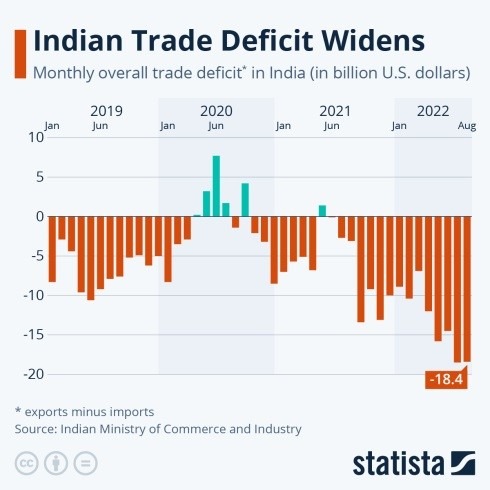
Causes of India’s Rising Trade Deficit with China
- High Dependence on Chinese Imports:
- Key sectors such as electronics, pharmaceuticals (APIs), chemicals, and textiles rely heavily on intermediate goods and raw materials from China.
- Dominance in Capital and Consumer Goods:
- China is a primary source for electrical machinery, telecom equipment, and mobile phones, owing to its cost competitiveness and manufacturing scale.
- Narrow and Low-Value Export Basket:
- India’s exports are largely primary commodities like iron ore, cotton, and copper, with minimal value addition and limited diversification.
Market Access Barriers:
- Indian products face regulatory restrictions, non-tariff barriers, and weak consumer demand in the Chinese domestic market.
Global Supply Chain Positioning:
- Chinese firms have deep integration in global value chains, supplying diverse and competitively priced goods worldwide.
India’s Evolving Industrial Base:
- Despite initiatives like ‘Make in India’, domestic manufacturing—especially in high-tech and industrial machinery—is still not at par with China’s capabilities.
Concerns Arising from the Trade Imbalance
- Rising Imports Forecast: Chinese imports are projected to increase by 20% as exporters seek alternative markets amid rising tariffs in the U.S.
- MSME Vulnerability: Influx of low-cost Chinese goods adversely impacts India’s MSME sector, leading to job losses, reduced competitiveness, and industrial stagnation.
- Strategic and Cyber security Risks: Heavy imports of telecom and surveillance equipment raise alarms about data security and national cybersecurity.
- Macro-Economic Pressure: The trade deficit exacerbates the Current Account Deficit (CAD), putting downward pressure on the rupee and straining foreign exchange reserves.
- Geopolitical Paradox: Dependence on China for critical imports appears strategically contradictory, given ongoing border tensions and strained diplomatic ties.
- Innovation Gap: Reliance on Chinese technology underscores India’s lag in high-tech R&D and manufacturing, challenging long-term economic sovereignty.
Government Initiatives to Address the Deficit
- Trade Remedies: The Directorate General of Trade Remedies (DGTR) monitors and counters unfair trade practices.
- ‘Vocal for Local’ Campaign: Aims to generate consumer awareness and promote domestically manufactured goods.
- Production Linked Incentive (PLI) Scheme: Covers 14 strategic sectors, providing financial support to boost domestic manufacturing and export capacity.
Export Promotion Schemes:
- TIES (Trade Infrastructure for Export Scheme) and MAI (Market Access Initiatives) enhance export readiness.
- APEDA supports agro-exporters through financial aid.
- MPEDA promotes marine exports via infrastructure upgrades, lab testing, and technical assistance.
- Districts as Export Hubs:Focuses on identifying district-level export potential, resolving bottlenecks, and empowering local manufacturers.
Conclusion and Way Forward
- India’s growing trade dependence on China has supported cost-effective production and consumer affordability but has also created significant economic vulnerabilities.
To ensure strategic autonomy and economic resilience, India must:
- Diversify its import sources to reduce over-reliance.
- Strengthen domestic manufacturing through the Make in India mission and PLI schemes.
- Enhance technological capabilities to boost high-value exports.
- Import substitution must not mean protectionism but a balanced trade framework rooted in competitiveness, innovation, and strategic foresight.
Which of the following sectors contributes significantly to India’s trade deficit with China due to import dependence on intermediate or capital goods?
- Pharmaceuticals
- Solar energy
- Textiles
- Telecommunications
Select the correct answer using the code below:
A. 1, 2 and 3 only
B. 1, 2 and 4 only
C. 2, 3 and 4 only
D. 1, 2, 3 and 4
Answer😀
Explanation:
- APIs (Active Pharmaceutical Ingredients) in pharma
- Solar components like PV cells
- Textile machinery and raw inputs (like dyes, synthetics)
- Telecom hardware (routers, 5G, mobile handsets).All these are imported heavily from China, contributing to the deficit.
India Needs an Ecosystem That Better Enables Deep-tech Innovation
Syllabus :GS 3/Economy
InNews: It the Startup Mahakumbh event, Commerce Minister Piyush Goyal urged Indian startups to shift their focus from consumer-oriented services like food delivery and online betting to high-tech, innovation-driven sectors such as Artificial Intelligence (AI), semiconductors, and electric vehicles (EVs), drawing a sharp contrast with China’s approach.
Startup Mahakumbh: Context and Vision
- A flagship national event promoting innovation and entrepreneurship in India.
- Themed “Startup India @2047: Unfolding the Bharat Story”, the event envisions India as a global startup powerhouse by the centenary of independence.
- It aims to foster global partnerships, spotlight Indian innovation, and accelerate sectoral diversification beyond consumer apps.
Key Challenges in India’s Startup Ecosystem
- Innovation Deficit: Despite Indian-origin CEOs leading tech giants globally, India lacks corresponding domestic innovation depth.
- Funding Disparities: Long-gestation sectors like deep tech receive less VC attention than short-term consumer apps.
- Educational Gaps: Many graduates lack employable skills; R&D output from Indian universities remains globally marginal.
- Brain Drain: Talented individuals often pursue better-funded opportunities abroad.
- Risk Aversion in VC Culture: Conservative funding norms limit breakthrough tech investments.
- Domestic Market Lock-In: Startups like Swiggy and Zomato primarily serve the Indian market with limited international expansion.
Opportunities and Strengths
- India is now the world’s third-largest startup ecosystem, with over 57 lakh DPIIT-recognized startups and more than 100 unicorns.
- Tier II and III cities now contribute over 51% of startups, indicating a strong grassroots entrepreneurial movement.
Notable success in:
- SaaS (e.g., Zoho, Freshworks),
- Digital payments (e.g., UPI, Paytm, PhonePe),
- Space tech (e.g., Digantara, Skyroot, Agnikul),
- Cybersecurity (though acquisition risk persists).
- Deep-tech investments surged by 78% in 2024, reaching $1.6 billion.
Way Forward: From Consumer Apps to Core Tech Leadership
- India’s startup growth, while commendable in sectors like fintech and SaaS, must evolve toward strategic tech dominance. Bridging the innovation and funding gap requires:
- Policy Support: Long-term frameworks for AI, semiconductors, defence tech, and climate innovation.
- Investment Boldness: Prioritize high-risk, high-reward deep-tech ventures through sovereign funds and incentivized VC models.
- Educational Reforms: Align curricula with global R&D standards and foster academic-industry partnerships.
- Global Integration: Expand Indian startups’ global presence through diplomatic, trade, and venture collaborations.
Conclusion
- India stands at a defining moment in its startup journey. To emerge as a global technology leader, the country must pivot from consumer-centric ventures to deep-tech innovation.
- Achieving this vision demands structural reforms, cultural transformation, and visionary leadership to catalyze a new era of knowledge-driven growth.
With reference to the comparison between Indian and Chinese startup ecosystems, which of the following statements is/are correct?
- India has invested more in technology and innovation than China between 2014 and 2024.
- China leads globally in electric vehicles and AI innovation.
- India ranks below China in the Global Innovation Index 2024.
Select the correct answer using the code below:
A. 1 and 2 only
B. 2 and 3 only
C. 1 and 3 only
D. 1, 2 and 3
Answer: B
Explanation:
- Statement 1 is incorrect: India invested ~$160B vs China’s ~$845B in tech between 2014 and 2024.
- Statement 2 is correct: China leads in EVs and AI (e.g., Deepseek).
- Statement 3 is correct: India ranks 39th, while China is 11th on the Global Innovation Index 2024.
Weaponization of Trade and Finance
Syllabus: GS2-International Relations / GS3-Economy
- The Defence Minister of India recently emphasized the growing erosion of global order and multilateralism, driven by the weaponization of trade, finance, and emerging technologies.
What is the Weaponization of Trade and Finance?
- Weaponization of trade and finance refers to the strategic use of trade policies and economic measures by countries to exert political or economic pressure on others. This marks a departure from the traditional role of trade and finance as tools for cooperation and globalization.
Tools of Trade Weaponization:
- Tariffs and Sanctions
- Export Restrictions: Limiting the export of critical technologies or materials.
- Currency Manipulation
Recent Incidents of Trade and Finance Weaponization:
- Tariff War 2.0: The ongoing trade friction between the US and China has led to high tariffs and investment restrictions aimed at securing supply chains and gaining strategic advantages.
- Financial Sanctions: The West’s exclusion of Russia from the SWIFT network and freezing its central bank reserves following the Ukraine invasion is a classic example of financial weaponization.
- Technology Denial Regimes: Restrictions on semiconductor exports to China, and controls over technologies like AI and quantum computing hardware, demonstrate the weaponization of technology.
Consequences of Economic Weaponization:
- Erosion of Multilateral Institutions: The WTO’s dispute settlement mechanism is losing credibility due to the increasing use of unilateral tariffs. Other institutions like the IMF and World Bank are also seen as being Western-dominated, leading to legitimacy crises.
- Decline of Rules-Based Global Order: Unilateral actions are becoming more common, with countries prioritizing national interests over international norms and treaties.
- Economic Fragmentation: The world is experiencing “geo-economic decoupling,” with regional trading blocs like RCEP and IPEF gaining importance, further weakening global economic integration.
- Global Inequality: The disruptions in global supply chains, such as those triggered by the pandemic and the Ukraine war, have exacerbated global inequalities.
Steps Taken Against Trade Weaponization:
- Regional Trade Agreements (RTAs): Countries are forging regional agreements like the CPTPP and RCEP to reduce dependence on major economies and enhance cooperation.
- Alternative Financial Systems: Russia’s SPFS, China’s CIPS, and proposals for a BRICS payment system are alternative solutions to the SWIFT network. Additionally, Central Bank Digital Currencies (CBDCs) are being developed to achieve monetary independence.
- Mineral Security Partnership (MSP): This initiative aims to diversify and stabilize the global supply chains of critical minerals.
- Reform of the WTO: Ongoing reforms to the World Trade Organization aim to improve its dispute resolution mechanisms and address challenges posed by unilateral trade actions.
- Indo-Pacific Economic Framework (IPEF): This framework counters economic coercion, promoting a more equitable and rules-based trading system.
ConcludingRemarks:
- The weaponization of trade and finance signals the beginning of a new era of geopolitical contestation, where economic interdependence no longer guarantees peace.
- For India, which has always advocated for multilateralism and global cooperation, navigating this fractured world order requires strategic clarity, resilient institutions, and a robust technological foundation.
With reference to the weaponization of trade and finance, which of the following statements is/are correct?
- Weaponization of trade refers to the strategic use of trade policies to foster cooperation and globalization.
- Financial sanctions, such as the exclusion of Russia from the SWIFT network, are an example of economic weaponization.
- The weaponization of technology includes restricting the export of critical technologies like semiconductors and AI hardware.
Select the correct answer using the code below:
A. 1 and 2 only
B. 2 and 3 only
C. 1 and 3 only
D. 1, 2, and 3
Answer: B. 2 and 3 only
Explanation:
- Statement 1 is incorrect: The weaponization of trade marks a departure from cooperation and globalization, as it involves using trade policies and economic measures for political and economic pressure.
- Statement 2 is correct: Financial sanctions, like the exclusion of Russia from the SWIFT network and freezing its central bank reserves, are a clear example of financial weaponization.
- Statement 3 is correct: The restriction on critical technologies, such as semiconductors and AI hardware, reflects the weaponization of technology.
Powering India’s Participation in Global Value Chains Report
Syllabus: GS3/Indian Economy
Overview
- NITI Aayog has released a comprehensive report analyzing the status, opportunities, and challenges of India’s automotive industry.
- The document outlines a strategic roadmap to position India as a major contributor to global automotive value chains (GVCs).
Key Highlights
Global Trends in the Automotive Sector
- Shift in Supply Chains: Emergence of battery manufacturing hubs in Europe and the U.S. is reshaping traditional supply chains.
- Industry 4.0 Revolution: Advanced technologies such as Artificial Intelligence (AI), Machine Learning (ML), Internet of Things (IoT), and robotics are enabling smart factories and connected vehicles, redefining manufacturing paradigms.
- Rising Input Costs: Semiconductor costs per vehicle are projected to increase from $600 to $1,200 by 2030.
- Global Auto Component Market: Estimated at $2 trillion (2022), with $700 billion traded globally.
- Global Automobile Production: Approximately 94 million units manufactured globally, growing at 4–6% annually.
India’s Position
- India ranks as the 4th-largest automobile producer, after China, the U.S., and Japan.
- Annually, India produces nearly 6 million vehicles.
- Stronghold in small cars and utility vehicle segments, with robust domestic and export demand.
- Under the ‘Make in India’ initiative, India is increasingly becoming a global manufacturing hub.
Challenges
- Limited Share in Component Trade: Despite its production strength, India contributes only 3% to the global automotive component trade (valued at ~$20 billion).
- Low Precision Manufacturing Share: India accounts for only 2–4% in high-value segments like engine components and transmission systems.
- Structural Barriers: High operational costs, infrastructural deficiencies, low R&D expenditure, and limited integration with global value chains hinder competitiveness.
Key Recommendations
- Opex and Capex Support: Government support for manufacturing scale-up, especially tooling, infrastructure, and die-making.
- Skill Development: Developing a skilled workforce aligned with technological advances.
- R&D, IP, and Branding: Incentives for R&D, international branding efforts, and IP transfers to support MSMEs and drive innovation.
- Cluster-Based Development: Creating automotive clusters with shared R&D and testing infrastructure to strengthen the supply chain ecosystem.
- Adoption of Industry 4.0: Promoting digitalization, smart manufacturing, and compliance with international standards.
- International Collaboration: Fostering joint ventures, foreign direct investment, and leveraging Free Trade Agreements (FTAs) for market expansion.
- Ease of Doing Business: Streamlining regulatory mechanisms, promoting flexible labour norms, and enhancing supplier networks.
Way Forward
Production and Export Targets:
- Auto component production expected to grow to $145 billion.
- Exports projected to triple to $60 billion, leading to a trade surplus of $25 billion.
- Employment Generation: Estimated to create 2–2.5 million jobs.
- GVC Integration: India aims to enhance its global value chain participation from 3% to 8%.
Conclusion
- India stands at a critical juncture with the potential to become a global leader in the automotive industry. Strategic interventions, collaborative policymaking, and technology adoption are essential to overcome structural constraints.
- By capitalizing on global trends and domestic strengths, India can drive inclusive, sustainable, and innovation-led growth in the automotive sector.
With reference to India’s automotive sector, consider the following statements:
- India is the third-largest global automobile producer, just behind China and the United States.
- India’s share in the global automotive component trade is significantly higher than its share in complete automobile exports.
- The majority of India’s automotive exports are in the heavy commercial vehicles and luxury sedan categories.
Which of the statements given above is/are correct?
A. 1 only
B. 2 and 3 only
C. None
D. 1 and 2 only
Answer: C. None
Explanation:
- Statement 1 is incorrect: India is the fourth-largest automobile producer after China, USA, and Japan.
- Statement 2 is incorrect: India has a modest share (~3%) in the global component trade, whereas it performs better in complete vehicle exports, especially in small cars and utility vehicles.
- Statement 3 is incorrect: India’s strengths lie in small cars and utility vehicles, not in heavy commercial or luxury segments.
India’s Trade Dynamics in FY25 Surplus with US Widens, Deficit with China Deepens
Syllabus:Economy
- India’s trade performance in FY2024–25 reveals contrasting trends with its two major trading partners—the United States and China.
- While exports to the US surged, reinforcing India’s trade surplus with Washington, the trade deficit with China widened considerably, underscoring persistent import dependence.
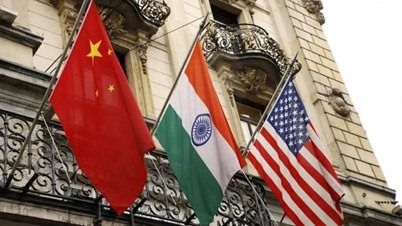
- Trade with the United States: Growing Surplus
- Exports to the US:Reached $86.5 billion, marking an 59% increase from $77.5 billion in FY2023–24.
- Imports from the US:Rose to $45.3 billion, a 44% rise from $42.19 billion the previous year.
- Trade Surplus:Expanded to $41.2 billion, up from $35.4 billion in FY2023–24, further cementing the US as India’s largest export market.
- Trade with China: Widening Deficit
- Exports to China:Declined sharply to $14.25 billion, registering a 49% fall from $16.66 billion in FY2023–24.
- Imports from China:Rose significantly to $113.45 billion, up 52% from $101.7 billion in the previous fiscal year.
- Trade Deficit:Ballooned to $99.2 billion, compared to $85.1 billion in FY2023–24.
- Major Import Drivers:Electronics, solar cells, electric vehicle (EV) batteries, and critical industrial components continue to dominate the import basket from China.
- Policy Implications and Trends
- The sharp rise in imports from China is partly attributed to the Production-Linked Incentive (PLI) schemes, which are driving domestic manufacturing and, paradoxically, increasing short-term demand for imported components.
- While the United States strengthens its position as India’s top export destination, the dependence on Chinese industrial inputs highlights
Consider the following statements regarding India’s bilateral trade with the United States and China in FY2024–25:
- India’s trade surplus with the United States increased primarily due to a fall in US exports to India.
- The widening trade deficit with China can partly be attributed to the import of intermediate goods linked to India’s PLI-driven manufacturing push.
- China retained its position as India’s top export destination and import source in FY2024–25.
- Despite higher trade with China, India’s export growth to the US outpaced its import growth from the US.
Which of the above statements is/are correct?
A) 2 and 4 only
B) 1 and 3 only
C) 1, 2 and 4 only
D) 2 only
Correct Answer: A) 2 and 4 only
Explanation:
- Statement 1 — Incorrect:The increase in India’s trade surplus with the US was driven by higher exports to the US (↑11.59%), not a fall in imports. In fact, imports from the US also increased (↑7.44%).
- Statement 2 — Correct:Imports from China rose due to rising demand for electronic components, EV batteries, and solar cells, much of which are intermediate goods required under Production Linked Incentive (PLI) schemes. This highlights India’s import-intensive manufacturing base, especially in emerging tech.
- Statement 3 — Incorrect:China remained India’s top import source, but not the top export destination. That title belongs to the United States, with exports worth $86.5 billion compared to $14.25 billion to China.
- Statement 4 — Correct:India’s exports to the US grew by 11.59%, outpacing the 44% growth in imports from the US. This led to a widening trade surplus with the US.
India’s Exports Rise Marginally by 0.7% in March 2025
Syllabus: Economy
- India’s foreign trade data for March 2025 and the full fiscal year 2024–25 indicates a delicate balancing act between marginal export growth and a sharp uptick in imports, resulting in a widening trade deficit and potential pressure on the current account position.
March 2025 Snapshot
- Merchandise Exports: $41.97 billion↳ Year-on-Year (YoY) growth: 7%, reflecting subdued global demand.
- Merchandise Imports: $63.51 billion↳ YoY growth: 3%, driven by rising consumption of energy products, electronics, and intermediate industrial goods.
- Trade Deficit: $21.54 billion↳ Marked deterioration from previous months due to a sharper import surge.
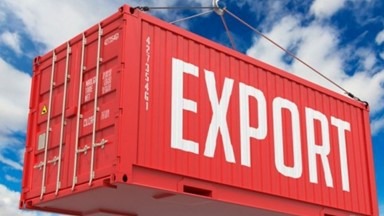
FY2024–25 Cumulative Trends (April 2024–March 2025)
- Total Goods Exports: $437.42 billion↳ Nominal YoY growth: 08%, signaling export stagnation despite global reopening.
- Total Goods Imports: $720.24 billion↳ YoY growth: 62%, reflecting resilient domestic demand and supply chain realignment.
- Overall Exports (Goods + Services): $820.93 billion↳ YoY growth: 5%, driven primarily by the services sector.
- Trade Deficit (Goods): Elevated due to strong import demand and weak manufacturing exports.
Drivers Behind the Trade Pattern
- Muted Global Demand: Particularly for labor-intensive and low-tech manufactured exports.
- High Base Effect: March 2024 exports were comparatively strong, muting YoY growth.
- Import Acceleration: Surge in crude oil, semiconductors, renewable energy components, and capital goods.
- Services Sector Resilience: IT, business process outsourcing, and financial services provided a buffer.
Macroeconomic Implications
- Current Account Pressure: Persistent trade deficits can widen the Current Account Deficit (CAD) and weaken external sector stability.
- Forex Implications: Rising import bills may lead to depletion of foreign exchange reserves if not offset by capital inflows.
- Policy Imperatives:
- Promote export diversification toward high-value and green technologies.
- Accelerate import substitution in electronics, energy components, and critical minerals.
- Strengthen logistics and trade facilitation to enhance cost competitiveness.
With reference to India’s trade performance in FY 2024–25, consider the following statements:
- India’s merchandise exports declined year-on-year compared to FY 2023–24.
- The services sector played a crucial role in sustaining overall export growth.
- The trade deficit in March 2025 narrowed due to reduced imports.
- Electronics and industrial inputs were key drivers of India’s import surge.
Which of the statements given above are correct?
A. 1 and 3 only
B. 2 and 4 only
C. 1, 2 and 4 only
D. 2, 3 and 4 only
Answer: B. 2 and 4 only
Statement 1 is incorrect (exports showed marginal growth of 0.08%).
Statement 3 is incorrect (trade deficit widened due to rising imports).
Explanation:
- According to official data, India’s merchandise exports in FY 2024–25 amounted to $437.42 billion, which reflects a marginal increase of 0.08% over the previous year.
- While this growth is minimal and signals stagnation, it is still a positive figure, not a decline.
- Despite slow growth in goods exports, India’s services exports remained strong, leading to a 5.5% rise in total exports (goods + services) in FY 2024–25.
- Sectors like IT, BPO, and financial services contributed significantly to maintaining export momentum.
- In March 2025, imports rose sharply by 11.3%, while exports increased only slightly (0.7%).
- This led to a widening of the trade deficit to $21.54 billion, up from earlier months.
- Therefore, the trade deficit did not narrow — it widened due to increased import demand.
NITI AAYOG Launched Unlocking $25+ Billion Export Potential Report
With reference to the recent NITI Aayog report “Unlocking $25+ Billion Export Potential – India’s Hand & Power Tools Sector”, consider the following statements:
- The report projects that achieving the $25 billion export target in hand and power tools could generate over 3 crore jobs, primarily in services and IT sectors.
- India currently holds a greater global market share in power tools exports than in hand tools exports.
- China accounts for nearly half of the global exports in both hand and power tools, significantly dominating the sector.
- The report recommends that any cost disadvantage faced by Indian manufacturers should be offset through increased direct fiscal subsidies over the long term, regardless of policy reforms.
Which of the above statements is/are correct?
- 1 and 2 only
B. 3 only
C. 2 and 4 only
D. 1, 3, and 4 only
Answer: B. 3 only
Explanation:
- Statement 1 – Incorrect: While the report does project the creation of 35 lakh (3.5 million) jobs, these are primarily in the manufacturing and export sectors, not services or IT.
- Statement 2 – Incorrect: India’s global market share in hand tools (1.8%) is currently higher than that in power tools (0.7%).
- Statement 3 – Correct: China is indeed the dominant global exporter, accounting for ~50% of hand tools and ~40% of power tools exports—an accurate representation of the competitive landscape.
- Statement 4 – Incorrect: The report states that direct fiscal subsidies are not required if structural reforms are implemented. Bridge cost support (₹8,000 crore) is only a contingency plan if reforms are delayed, not a long-term recommendation.
Which of the following is the primary religious significance of Thangjing Hills in Manipur?
- It is considered the sacred abode of the Meitei deity Eputhou Thangjing.
- The hills are considered a symbol of unity between the Meitei and Kuki-Zo communities.
- The pilgrimage to Thangjing Hills is a part of the Kuki-Zo religious tradition.
- The site is linked to the Khamba-Thoibi legend, central to Meitei mythology.
Select the correct answer using the code below:
A) 1 and 4 only
B) 2 and 3 only
C) 1, 3, and 4 only
D) 1, 2, and 4 only
Answer: A) 1 and 4 only
Explanation:
- Thangjing Hills is regarded as the sacred abode of Eputhou Thangjing, a central Meitei deity.
- It is also linked to the Khamba-Thoibi myth, which is integral to Meitei folklore.
- The opposition from the Kuki-Zo community is rooted in ethnic tensions rather than religious unity, hence the other options are incorrect.
National Critical Mineral Mission (NCMM)
Syllabus:Budget
- Driving India’s Strategic Mineral Security & Sustainability
- Launched in: Union Budget 2024–25
- Nodal Ministry: Ministry of Mines, Government of India
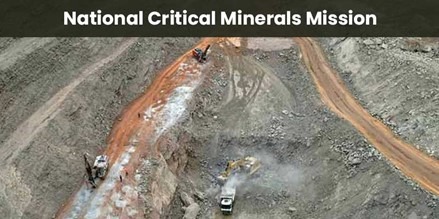
Objective: To ensure a secure, resilient, and sustainable supply of critical minerals vital for:
- Clean energy transition
- Technological innovation
- Defence and strategic sectors
- Achieving Net Zero 2070 and Atmanirbhar Bharat goals
Key Focus Areas:
Exploration and Mining
- Over 1200 mineral exploration projects
- Auction of more than 100 mineral blocks for commercial mining
Overseas Asset Acquisition
- Facilitates Indian entities in acquiring mineral assets in countries such as Argentina, Australia, and Chile
Recycling and Circular Economy
- Development of Standard Operating Procedures (SOPs) and incentives for recycling
- Aims to reduce import dependency and minimize environmental impact
Research and Innovation
- Establishment of Centres of Excellence (CoEs)
- Promotes advanced research in extraction, beneficiation, and processing technologies
Skill Development
- Introduction of new academic programs, training modules, and scholarships
- Focus on building a skilled workforce for the critical minerals sector
Infrastructure Development
- Development of mineral processing parks
- Creation of national stockpiles for strategic storage and distribution
With reference to the National Critical Mineral Mission (NCMM), consider the following statements:
- The Mission mandates that all critical mineral block auctions be restricted to public sector undertakings to ensure strategic resource control.
- One of the objectives of the Mission is to reduce import dependence through both domestic exploration and incentivized recycling mechanisms.
- The establishment of Centres of Excellence (CoEs) under the Mission is aimed exclusively at promoting downstream manufacturing of critical mineral-based products.
Which of the statements given above is/are correct?
A. 2 only
B. 1 and 3 only
C. 2 and 3 only
D. 1, 2 and 3
Answer: A. 2 only
Explanation:
- Statement 1 is incorrect. The NCMM does not mandate that auctions be restricted to public sector undertakings. Instead, it promotes both public and private sector participation in exploration and commercial mining to boost the domestic supply of critical minerals.
- Statement 2 is correct. A key objective of NCMM is to reduce India’s import dependency. This is to be achieved through extensive mineral exploration and the promotion of recycling via SOPs and incentives—both of which form integral parts of the circular economy strategy.
- Statement 3 is incorrect. While CoEs are being established under the Mission, their focus is not limited to downstream manufacturing. They are primarily intended to drive advanced research and innovation in extraction, beneficiation, and processing technologies related to critical minerals.
Cap-and-Trade India
Syllabus:Economy
- Context: A recent study published in The Quarterly Journal of Economics confirmed that Surat’s Emissions Trading Scheme (ETS), the world’s first market for particulate emissions, successfully reduced pollution by 20–30% and lowered compliance costs by 11%.
What is Cap-and-Trade?
- Cap-and-Trade is a market-driven environmental policy in which the government sets a maximum limit (cap) on total pollution levels emitted by industries. The system works as follows:
- Pollution Permits: Companies are allocated pollution permits, each allowing them to emit a specific amount of pollutants. If a company emits less than its allotted share, it can sell the unused permits to other firms that are exceeding their limits.
- Financial Incentive: This system encourages companies to reduce emissions efficiently and invest in cleaner technologies, as reducing emissions can generate profit through the sale of unused permits.
How Cap-and-Trade Works:
- Regulatory Cap Setting: The government sets an emissions ceiling based on environmental goals, such as improving air quality or meeting climate targets.
- Permit Distribution: Emission permits are distributed through:
- Free allocation based on historical emissions (grandfathering).
- Auctioning a portion of permits, allowing the market to determine their price.
- Trading System Among Firms: Companies that can cut emissions cost-effectively will do so and sell their excess permits. Firms facing high abatement costs can purchase permits to comply instead of investing in costly technology upgrades.
- Penalties for Non-Compliance: Firms that fail to secure enough permits to match their emissions face financial penalties. This incentivizes compliance, making it cheaper to either reduce pollution or purchase additional permits than to pay fines.

Challenges to the Cap-and-Trade Model:
- Monitoring Gaps: Successful cap-and-trade relies on accurate, real-time emissions data, which requires continuous oversight and maintenance of monitoring systems. For instance, Surat’s success depended on the installation of Continuous Emissions Monitoring Systems (CEMS).
- High Initial Setup Cost: Implementing systems like CEMS can be expensive, especially for small industries. In Surat, 317 industries had to install CEMS.
- Market Manipulation Risks: Without stringent regulations, industries could manipulate permit prices by hoarding them. Surat addressed this issue by introducing weekly auctions to prevent hoarding.
- Sectoral Variations: Pollution abatement costs differ across industries, which may create uneven opportunities for firms to profit from permit trading.
- Policy Instability: Frequent changes in emission caps or trading rules can discourage long-term investments in clean technologies. Surat adjusted its emission cap from 280 to 170 tonnes/month after reviewing pilot phase data.
Way Ahead:
- Expand ETS to Other Cities: Scaling up ETS to other heavily polluted cities like Delhi and Ahmedabad can maximize the impact and establish a nationwide pollution control framework.
- Include More Pollutants: The ETS could be extended to cover other pollutants such as sulfur dioxide (SO₂) and nitrogen oxides (NOx) for a more comprehensive approach to industrial pollution.
- Invest in CEMS Technology: Further investment in tamper-proof and reliable CEMS technology will ensure greater transparency and regulatory efficiency.
- Set Dynamic Emission Caps: Emission caps should be adjusted to accommodate seasonal pollution variations and industrial production cycles for greater effectiveness.
- Enhance Stakeholder Engagement: Active collaboration between industries, local bodies, and citizens through awareness campaigns can ensure broader acceptance and success of the system.
Conclusion:
- Surat’s Emissions Trading Scheme showcases how market-based solutions can effectively balance industrial growth with environmental sustainability. Expanding and refining such initiatives across India could be pivotal in achieving national clean air targets while improving industrial efficiency.
With reference to the Cap-and-Trade model implemented in Surat’s Emissions Trading Scheme (ETS), consider the following statements:
- The government’s role in Cap-and-Trade involves setting a maximum pollution limit and ensuring continuous oversight of emissions data through systems like CEMS.
- The market for pollution permits under Cap-and-Trade is primarily driven by a free allocation method, without the involvement of auctions.
- Surat’s success in implementing the Cap-and-Trade model was dependent on the installation of Continuous Emissions Monitoring Systems (CEMS), which provided real-time data for regulatory enforcement.
Which of the statements given above is/are correct?
A. 1 and 3 only
B. 2 and 3 only
C. 1 and 2 only
D. 1, 2, and 3
Answer: A. 1 and 3 only
Explanation:
Statement 1 is correct: The government sets an emissions ceiling (cap) and plays an essential role in ensuring continuous oversight of emissions through monitoring systems like CEMS. This system is vital for accurate data collection, which underpins the Cap-and-Trade.
Statement 2 is incorrect: The Cap-and-Trade system also involves auctioning a portion of pollution permits, which allows the market to determine their price.
Statement 3 is correct: Surat’s successful implementation of the ETS is largely attributed to the installation of CEMS, which provided accurate, real-time emissions data crucial for monitoring and enforcement.
Ambedkar’s Contributions to Indian Economy
Syllabus:Economy
On the occasion of Ambedkar Jayanti 2025, renewed focus is being given to Dr. B.R. Ambedkar’s pivotal role in shaping India’s economic framework. His contributions in various domains laid the foundation for modern Indian economic policy, especially in the areas of monetary policy, labour rights, land reforms, and Dalit empowerment.
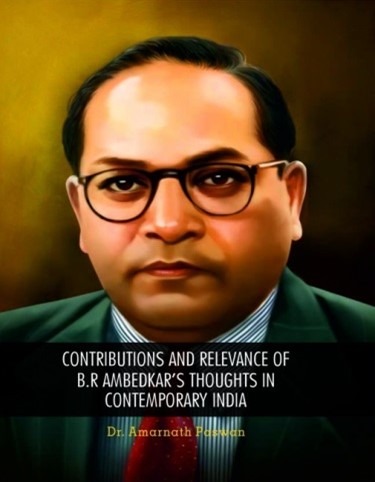
Key Contributions to India’s Economic Thought:
- Monetary Policy and the Reserve Bank of India: Ambedkar’s 1923 work The Problem of the Rupee: Its Origin and Its Solution proposed a gold exchange standard, which influenced the establishment of the Reserve Bank of India in 1934.
- Pioneering Fiscal Federalism:His thesis on Provincial Decentralisation of Imperial Finance in British India (1921) conceptualized financial decentralization, laying the groundwork for the creation of India’s Finance Commission.
- Labour Welfare Reforms:As a Labour Member in the Viceroy’s Executive Council, Ambedkar introduced major labour reforms, including the 8-hour workday, maternity benefits, and dispute resolution boards. He also set up employment exchanges across India to reduce unemployment.
- Water and Power Resource Development: Ambedkar’s vision extended to infrastructure, where he spearheaded projects like the Central Water Commission, the Damodar Valley Project, and the Hirakud Dam, linking water management to economic progress.
- Land Reforms and Dalit Empowerment: He advocated for land distribution among Dalits and the creation of separate settlements to ensure economic independence. His proposals included nationalization of land and collectivization of agriculture.
- Economic Justice and Social Democracy: Ambedkar strongly argued that economic empowerment is essential for social dignity, asserting that true social democracy cannot exist without economic justice.
- Industrialization and Modernization: Supporting state-led industrialization, Ambedkar saw it as a way to create employment opportunities and address caste-based occupational segregation.
- Anti-Inflationary Policies:He recognized inflation as a major issue that disproportionately impacts the poor, advocating for responsible monetary policies—a principle reflected in India’s modern inflation-targeting framework, such as the 2016 Monetary Policy Framework.
- Ambedkar’s economic vision laid the groundwork for a more inclusive, equitable economic structure, advocating policies that prioritized both social and economic justice.
Consider the following statements regarding Dr. B.R. Ambedkar’s contributions to India’s economic thought:
- Ambedkar’s work on monetary policy directly influenced the establishment of the Reserve Bank of India in 1934.
- He proposed the nationalization of agriculture to break caste-based occupational immobility.
- Ambedkar’s vision of fiscal federalism focused solely on centralized financial control to ensure efficient resource distribution.
Which of the statements given above is/are correct?
A. 1 and 2 only
B. 2 and 3 only
C. 1 only
D. 1, 2, and 3
Answer: A. 1 and 2 only
Explanation:
- Statement 1 is correct: Dr. Ambedkar’s The Problem of the Rupee (1923) advocated for a gold exchange standard, which directly influenced the establishment of the Reserve Bank of India in 1934.
- Statement 2 is correct: Dr. Ambedkar advocated for land reforms, including land redistribution and the collectivization of agriculture, to empower Dalits and ensure their economic independence.
- Statement 3 is incorrect: Ambedkar’s vision of fiscal federalism was focused on decentralization, and he conceptualized financial decentralization through the creation of the Finance Commission, not centralizing financial control.
India’s Global Pharmaceutical Footprint
Syllabus: GS3/ Economy
Context
- With the vision of establishing India as the world’s leading provider of affordable and high-quality medicines, the Department of Pharmaceuticals has catalyzed a remarkable transformation in India’s global pharmaceutical footprint.
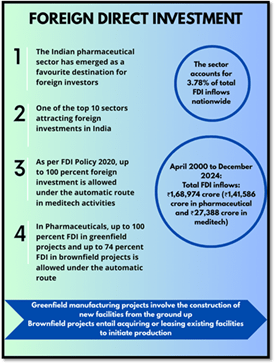
Current Status of the Pharmaceutical Sector
- Market Size (FY 2023–24): Valued at USD 50 billion, comprising:
- Domestic consumption: USD 23.5 billion
- Exports: USD 26.5 billion
Global Standing:
- India is the largest provider of generic medicines, accounting for 20% of global supply by volume.
- Ranked third globally in terms of Active Pharmaceutical Ingredient (API) production, holding an 8% share of the global API industry.
- Contribution to Economy: The pharmaceutical sector contributes approximately 72% of India’s GDP.
Key Segments: Generic drugs, over-the-counter (OTC) medicines, bulk drugs, vaccines, biosimilars, biologics, and contract research & manufacturing.
India: The ‘Pharmacy of the World’
India has earned this title owing to its low-cost, high-quality medicines.
A global leader in vaccine production, India is:
- UNICEF’s largest supplier, meeting 55–60% of its vaccine demand.
- Fulfilling 99% of WHO’s DPT, 52% of BCG, and 45% of measles vaccine
- Foreign Investment:
The sector attracted US$ 22.52 billion in FDI (2000–2024), highlighting investor confidence and global reliance.
Medical Devices Sector: An Emerging Engine of Healthcare
- An integral part of India’s healthcare system, covering:
- Electro-medical equipment, implants, diagnostics, disposables, and surgical instruments.
- FDI Inflows (April–December 2024):₹11,888 crore across pharmaceuticals and medical devices.
Government Interventions and Policy Support
Production Linked Incentive (PLI) Schemes:
- For Pharmaceuticals: To boost high-value products and innovation.
- For Medical Devices: To reduce import dependency and scale manufacturing.
- For Bulk Drugs (APIs/KSMs/DIs): To strengthen self-reliance in critical raw materials.
- Bulk Drug Parks Scheme (2020–26):Aims to develop common infrastructure to lower production costs and promote domestic API manufacturing.
- Pradhan Mantri Bhartiya Janaushadhi Pariyojana (PMBJP):Ensures the availability of affordable quality generic medicines through a network of dedicated retail outlets.
Conclusion and Outlook
- India’s pharmaceutical and medical devices sectors exemplify the country’s strengths in science, innovation, affordable healthcare, and manufacturing prowess. With supportive policies, growing FDI, and global recognition, the sector is poised to reach USD 130 billion by 2030.
- Ensuring robust regulatory frameworks, boosting R&D capabilities, and strengthening supply chains will be critical to sustaining this momentum and reinforcing India’s position as a global healthcare leader.
Consider the following statements regarding India’s pharmaceutical exports:
- India supplies more than 50% of global demand for vaccines through UNICEF.
- The majority of India’s pharma exports are patented drugs.
- India fulfills over 90% of WHO’s demand for DPT vaccines.
Which of the above statements is/are correct?
A. 1 and 2 only
B. 1 and 3 only
C. 2 and 3 only
D. 1, 2, and 3
Answer:B
Explanation:
- Statement 1 is correct: India supplies 55–60% of vaccines procured by UNICEF.
- Statement 2 is incorrect: India primarily exports generic, not patented, medicines.
- Statement 3 is correct: India supplies 99% of WHO’s DPT vaccine demand.
Delay in Reporting Births and Deaths Data
Syllabus: GS2/ Governance, Health
In News
- The Civil Registration System (CRS), responsible for recording births and deaths in India, is currently experiencing implementation issues, resulting in delays in issuing digital certificates.
About Civil Registration System (CRS) App
- Developed by the Registrar General and Census Commissioner of India (under the Ministry of Home Affairs), the CRS mobile application aims to streamline and accelerate the registration process for births and deaths across the country.
- Digital Mandate: As per the Registration of Births and Deaths (Amendment) Act, 2023, all births and deaths occurring from October 1, 2023, onwards must be digitally registered.
- Single Document Utility: Digital birth certificates will now serve as a unified proof of date of birth for key services, including:
- School and college admissions
- Government recruitment
- Marriage registration
- Voter list inclusion
- Centralized Database Integration: The digital records will feed into and help update several national databases such as:
- National Population Register (NPR)
- Ration card system
- Electoral rolls
- Property registration records
National Population Register (NPR)
- NPR is the precursor to the National Register of Citizens (NRC) under the Citizenship Act.
- Initially compiled in 2010 and updated in 2015, NPR currently holds data of over 119 crore residents.
Key Provisions of the Registration of Births and Deaths (Amendment) Act, 2023
- Amends: The Registration of Births and Deaths Act, 1969.
- National Database: The Registrar General of India is tasked with maintaining a centralized, national database of registered births and deaths.
- Data Sharing:
- Chief Registrars and local Registrars (appointed by states) must transmit their data to the central registry.
- The centralized data may be shared with other national databases such as NPR, electoral rolls, and any other database notified by the Central Government.
Expanded Utility of Digital Birth Certificates: These will serve as a standardized proof of age for:
- Admissions to educational institutions
- Voter registration
- Employment in government posts
- Any other official use as prescribed by the government
Mandatory Digital Records: All reported births and deaths across India must be recorded digitally.
Implementation Challenges
- Delayed Reporting by Institutions: Hospitals and healthcare providers are not uploading data in real time, creating processing backlogs.
- Technical and Systemic Glitches: Full-scale integration across state platforms and institutions is yet to be achieved.
Lack of Training and Infrastructure:
- Registration officials and hospital staff require better training on digital tools.
- Infrastructure deficits are hampering real-time data capture.
Way Forward
- Data Security & Privacy: Implement robust cybersecurity protocols to safeguard sensitive personal data.
- Institutional Accountability: Introduce monitoring mechanisms and penalties for non-compliance or delayed data reporting.
- Capacity Building: Launch targeted training programs for hospital administrators, local registrars, and government personnel to enhance digital registration efficiency.
With reference to the Registration of Births and Deaths (Amendment) Act, 2023, consider the following statements:
- The Chief Registrars and local Registrars are constitutionally obligated to share data with the national database.
- Digital birth certificates issued under the Act shall be considered valid proof for appointment to government posts.
- The Act mandates the establishment of separate databases for births and deaths at state and central levels.
Which of the statements given above is/are correct?
A. 2 only
B. 1 and 2 only
C. 1 and 3 only
D. 1, 2 and 3
Answer: B
Explanation:
- Statement 1 is correct: They are statutorily (not constitutionally) obligated, and the Act mandates data sharing with the national database.
- Statement 2 is correct: Digital birth certificates are valid for government appointments, among other uses.
- Statement 3 is incorrect: The Act mandates a single centralized national database, not separate ones.
rt-LAMP Assay
Syllabus:Science
Overview
- Researchers from the Sree Chitra Tirunal Institute for Medical Sciences and Technology (SCTIMST), Thiruvananthapuram, have developed a novel indigenous molecular diagnostic tool—the real-time Loop-Mediated Isothermal Amplification (rt-LAMP) assay—to enable early and accurate detection of Tuberculosis (TB).
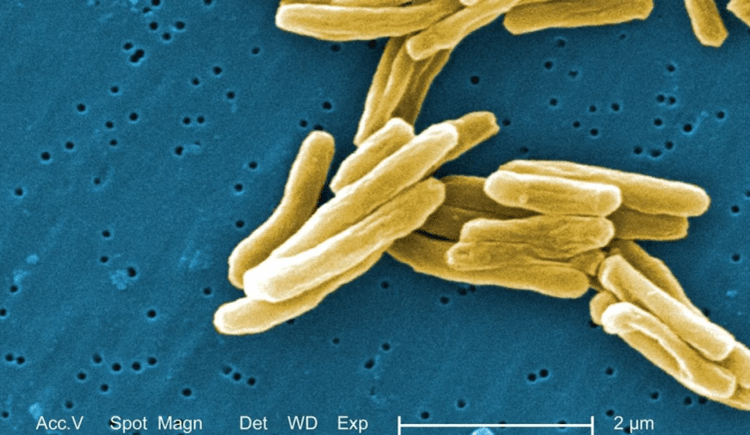
What is the rt-LAMP Assay?
- The rt-LAMP assay is a rapid, sensitive, and specific diagnostic technique, comparable to advanced platforms like GeneXpert and Truenat.
- It can detect as few as 10 DNA copies per microlitre, allowing for diagnosis even at early stages of infection.
- Unlike RT-PCR, which requires three thermal cycling steps, rt-LAMP functions at a constant temperature, making the process simpler and more cost-effective.
Key Features:
- Uses six primers for DNA amplification (RT-PCR uses only two), enhancing both speed and specificity.
- Employs the fluorescent dye Syto 16, which does not inhibit the reaction, overcoming the challenge of false negatives associated with older LAMP methods.
- Diagnostic results are available within 10–20 minutes, significantly faster than conventional methods.
Regulatory and Validation Status
- The assay has been licensed for industrial production.
- It has received approval from the Central Drugs Standard Control Organisation (CDSCO).
- Validation by the Indian Council of Medical Research (ICMR) is currently underway.
- The test is also under review by the WHO’s Health Technology Access Pool (HTAP).
Strategic Significance for TB Control in India
- Despite efforts to scale molecular diagnostics, India continues to rely heavily on sputum smear microscopy—used in 79% of presumptive TB cases as of 2023.
Although molecular testing labs increased from 5,090 in 2022 to 6,496 in 2023, progress remains below targets set under the National Strategic Plan (2017–2025). - The indigenous rt-LAMP assay offers a low-cost, rapid, scalable, and accurate alternative, well-suited for resource-limited settings.
Its implementation could:
- Accelerate TB case detection
- Reduce transmission rates
- Improve the efficacy of the National TB Elimination Programme (NTEP)
- Advance India’s goal of TB elimination by 2025
The rt-LAMP assay developed for TB detection holds which of the following advantages over conventional RT-PCR techniques?
- Capability to detect DNA at extremely low concentrations
- Requirement of isothermal (single-temperature) conditions
- Shorter diagnostic turnaround time
- Reduced dependence on expensive thermal cyclers
Select the correct answer using the code below:
(a) 1 and 2 only
(b) 2 and 3 only
(c) 1, 2, and 4 only
(d) 1, 2, 3, and 4
Answer: (d) 1, 2, 3, and 4
Explanation:.
Statement 1: Capability to detect DNA at extremely low concentrations
- The rt-LAMP assay developed by SCTIMST can detect TB DNA even at as low as 10 copies per microlitre, which makes it highly sensitive—often better than RT-PCR for early-stage detection
Statement 2: Requirement of isothermal (single-temperature) conditions
- Unlike RT-PCR, which requires thermal cycling (denaturation, annealing, and extension phases), rt-LAMP operates at a constant temperature, making it simpler and faster to perform.
Statement 3: Shorter diagnostic turnaround time
- The rt-LAMP assay delivers results in 10–20 minutes, whereas RT-PCR usually takes several hours due to its temperature cycling requirements.
Statement 4: Reduced dependence on expensive thermal cyclers
- Because it runs at a single temperature, the rt-LAMP assay does not require complex, costly thermal cyclers, making it ideal for low-resource or peripheral healthcare settings.
Space Tourism
Syllabus:Defence
- The recent sub-orbital flight of pop icon Katy Perry aboard Blue Origin’s New Shepard—manned entirely by an all-female crew—has reignited global debates around space tourism, particularly concerning its cost, environmental footprint, and ethical implications.
What is Space Tourism?
- Space tourism refers to commercial travel beyond Earth’s atmosphere, primarily for recreational or business purposes, facilitated by private aerospace firms such as Blue Origin, SpaceX, and Virgin Galactic.
- Unlike state-sponsored missions, these ventures cater to civilian space enthusiasts, albeit at prohibitive costs.
Types of Space Tourism
Sub-Orbital Tourism
- Altitude: Crosses the Kármán line (~100 km above Earth).
- Duration: Brief (~10–15 minutes); offers a few minutes of weightlessness.
- Example: Katy Perry’s 11-minute flight via New Shepard.
Orbital Tourism
- Scope: Involves multiple days in Earth’s orbit, often with ISS docking.
- Example: SpaceX’s Crew Dragon
- Lunar Tourism (Proposed)
- Future Prospects: Envisions circumnavigation or landing on the Moon.
- Example: SpaceX’s DearMoon project (target launch: 2025).
Key Concerns
Economic Exclusivity
- Ticket prices range from $450,000 to several million dollars, restricting access to ultra-wealthy individuals.
- Over 1,000 private bookings despite massive global wealth disparities.
Environmental Impact
- Rocket launches emit significant carbon dioxide and ozone-depleting substances.
- A single Blue Origin launch releases 300+ tons of CO₂—equivalent to emissions from 75 cars in a year.
Limited Scientific Output
- Tourist flights often lack meaningful contributions to science, unlike research-focused government missions.
- Comparatively, the ISS continues to yield groundbreaking data on microgravity and space biology.
Safety Concerns
- Private sector flights face heightened technical and safety risks.
- Example: A 2022 Virgin Galactic crash led to suspension of subsequent missions.
- Ethical Dilemmas
- The burgeoning $1.3 billion industry could potentially be redirected to address pressing global challenges like climate change and poverty.
Way Forward
- Regulate Rocket Emissions
- Promote adoption of carbon-neutral and ozone-friendly propulsion systems.
Example: ESA’s Prometheus engine cuts emissions by up to 90%.
- Democratize Space Access
- Subsidize public research seats or introduce lottery-based civilian selection models.
Example: NASA’s civilian astronaut program targets non-elite candidates.
- Mandate Scientific Payloads
- Enforce inclusion of research modules on commercial flights.
Example: Axiom Space’s collaboration with international research bodies for ISS missions.
- Tax Luxury Space Travel
- Implement “Space Taxes” to funnel revenues into climate resilience and space sustainability.
Example: European Union’s proposed tax on private launches.
- Promote Earth-Centric Policies
- Shift focus from space leisure to Earth-monitoring capabilities.
Example: ISRO’s EOS-6 aids in climate and ocean monitoring.
Conclusion
- Space tourism stands at the intersection of human aspiration and socio-environmental responsibility.
- While it exemplifies technological progress, unchecked growth may exacerbate inequality and ecological stress.
- A regulated, inclusive, and research-driven approach is essential to align private space ventures with the broader goals of scientific advancement and planetary stewardship.
Which of the following is a key distinguishing feature of Space Tourism compared to traditional space missions?
- Space tourism primarily focuses on government-funded research.
- Space tourism involves private companies offering recreational travel beyond Earth’s atmosphere.
- Space tourism is limited to orbital flights
- Space tourism is restricted to scientific astronauts.
Select the correct answer using the code below:
A) 1 and 3 only
B) 2 and 4 only
C) 2 only
D) 1, 3, and 4 only
Answer: C) 2 only
Explanation:
- Option 1: “Space tourism primarily focuses on government-funded research.”
This is incorrect. - Space tourism is not primarily focused on research; instead, it involves recreational, leisure, or business travel beyond Earth’s atmosphere, typically offered by private companies like Blue Origin, Virgin Galactic, and SpaceX.
- It contrasts with traditional space missions, which are generally government-funded and research-oriented (e.g., NASA, ISRO).
- Option 2: “Space tourism involves private companies offering recreational travel beyond Earth’s atmosphere.”
- This is correct. Space tourism is driven by private companies that provide commercial spaceflights to civilians, typically for recreational or business Unlike traditional space missions, which are government-led and typically focused on exploration or scientific research, space tourism is about giving civilians the experience of traveling into space.
- Option3:”Space tourism is limited to orbital flights only.”This is incorrect. Space tourism includes a range of flight types, including sub-orbital flights (e.g., Blue Origin’s New Shepard) where the spacecraft crosses the Kármán line (the boundary of space), but doesn’t stay in orbit.
- Orbital tourism (e.g., SpaceX’s Crew Dragon) is one part of space tourism, but it is not the only type. Option 4: “Space tourism is restricted to scientific astronauts.”This is incorrect.
- Unlike traditional space missions where astronauts are trained for research or scientific purposes, space tourism is open to civilian passengers who are not necessarily scientific astronauts.
- The passengers typically pay for the experience and do not require the extensive training or professional expertise that traditional astronauts do.
Governmentality and Stubble Burning
Syllabus:Ecology
- A 2025 study by IIM Amritsar presents a critical examination of stubble burning in Punjab, linking it to deeper structural issues of governmentality and market distortions, rather than mere farmer negligence.
- The research underscores how state policies—especially those around Minimum Support Prices (MSP)—inadvertently incentivize unsustainable agricultural practices.
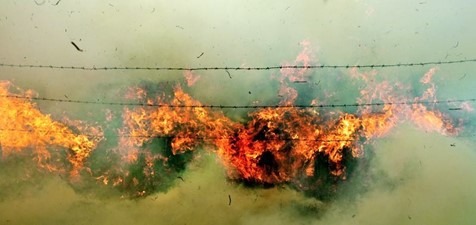
Understanding Governmentality in the Agricultural Context
Coined by Michel Foucault, governmentality refers to the art of governing not just through laws and coercion but by shaping the behavior and rationality of citizens. In agriculture, it manifests in multiple forms:
- Neoliberal Governmentality
- State uses market instruments like MSPs to steer farmer decisions indirectly.
Example: MSP disproportionately favors paddy and wheat, leading to entrenched monoculture and discouraging crop diversification.
- Disciplinary Governmentality
- Enforcement-based approach with penalties for non-compliance but few incentives or alternatives.
Example: Punjab imposes fines of up to ₹2.5 lakh for stubble burning without adequate access to sustainable residue management.
- Pastoral Governmentality
- The state projects itself as a caretaker but prioritizes urban-industrial concerns over rural livelihoods.Example: While farm fires are blamed for Delhi’s pollution, industrial PM2.5 emissions remain under-regulated.
- Security-Oriented Governmentality
- Focus on food security leads to overemphasis on paddy and wheat, sidelining environmental sustainability.Example: Punjab produces 35 million tonnes of paddy residue annually with inadequate disposal alternatives.
- Market-Driven Governmentality
- Dominance of arhatias (middlemen) distorts market pricing and access to credit, locking farmers in debt cycles.Example: Farmers receive ₹1,900/quintal for paddy despite open market rates exceeding ₹2,500.
How Governmentality Exacerbates Environmental Degradation
- MSP-Induced Monoculture: 85% of Punjab’s paddy cultivation is linked to MSP, leaving little scope for ecological farming.
- Technology Gap: Only 15% of farmers access machines like happy seeders or bio-decomposers, due to inadequate subsidy penetration.
- Urban Bias in Enforcement: Despite contributing 30% of Delhi’s PM2.5, industries face less scrutiny than farmers.
- Credit Exploitation: With 60% of farmers in debt (NABARD 2022), burning becomes a cost-effective, though harmful, practice.
- Token Incentives: Schemes like ₹100/quintal for non-burning behavior reach only 20% of farmers, failing to tackle root causes.
Conclusion
- Stubble burning is less an act of defiance and more a symptom of policy-induced environmental degradation.
- Rectifying the crisis demands structural reforms—from revisiting MSP frameworks to establishing stubble-based value chains and eliminating middlemen distortions.
- A just, inclusive, and ecological agricultural policy is essential to safeguard both rural livelihoods and environmental sustainability.
With reference to stubble burning and the theory of governmentality, consider the following statements:
- Neoliberal governmentality in Indian agriculture manifests through market-based tools like the Minimum Support Price (MSP), which indirectly encourage ecologically harmful cropping patterns.
- Disciplinary governmentality is exemplified by penal provisions against stubble burning without sufficient institutional or financial support for sustainable alternatives.
- Pastoral governmentality reflects the state’s preference for farmers’ welfare over urban environmental concerns by heavily subsidizing residue management machinery.
- Security-oriented governmentality prioritizes food security goals but often overlooks long-term ecological consequences of monoculture practices.
Which of the statements given above are correct?
A) 1 and 2 only
B) 1, 2, and 4 only
C) 2, 3, and 4 only
D) 1, 3, and 4 only
Correct Answer: B) 1, 2, and 4 only
Explanation:
- Statement 1 –Correct: MSP acts as a market signal that incentivizes rice-wheat monoculture, particularly in Punjab, contributing to environmental degradation like stubble burning. This aligns with neoliberal governmentality, where the state influences behavior through economic incentives rather than direct orders.
- Statement 2 – Correct:Fines for stubble burning without providing viable alternatives like Happy Seeders or bio-decomposers is a classic example of disciplinary governmentality, which focuses on compliance rather than empowerment.
- Statement 3 – Incorrect:Pastoral governmentality critiques how the state appears to act in the farmers’ interest, while in reality prioritizing urban-industrial interests, such as Delhi’s air quality, often ignoring the socio-economic conditions of rural communities. There is no evidence of heavy subsidies in this domain; in fact, only a fraction of farmers access such benefits.
- Statement 4 – Correct:Security-oriented governmentality emphasizes national food security (e.g., through paddy procurement), but neglects the environmental costs of monoculture and residue burning.
Indian Navy Hosted 3rd Edition Of Meghayan-25
Syllabus:Defence
- The Indian Navy hosted the 3rd edition of its prestigious Meteorological and Oceanological Symposium – Meghayan-25 on April 14, 2025, at Nausena Bhawan, New Delhi.
- This event, which coincided with the World Meteorological Day 2025, aimed to foster awareness and collaboration in Marine Meteorology and Oceanology.
- The symposium featured participation from key scientific and defense institutions, and its theme highlighted efforts towards closing gaps in early warning systems.
Key Highlights
- Event Name: Meghayan-25
- Organized By: Indian Navy
- Edition: 3rd
- Date: April 14, 2025
- Venue: Nausena Bhawan, New Delhi
- Occasion: World Meteorological Organization (WMO) Day 2025
- WMO Day Theme: “Closing the Early Warning Gap Together”
Inauguration and Dignitaries
- Virtual Inauguration: Admiral Dinesh K Tripathi, Chief of the Naval Staff
- Presided Over By: Vice Admiral Krishna Swaminathan, Vice Chief of Naval Staff
Key Attendees:
- VAdm Tarun Sobti – Deputy Chief of Naval Staff
- VAdm Lochan Singh Pathania – Chief Hydrographer to Government of India
- Nilesh Desai – Director, SAC Ahmedabad (Guest of Honour)
- Mrutyunjay Mohapatra – DG, IMD & Hony Vice President, WMO (Keynote Address)
Participating Institutions:
- India Meteorological Department (IMD)
- Indian Institute for Tropical Meteorology (IITM)
- Indian National Center for Ocean Information Services (INCOIS)
- National Institute of Ocean Technology (NIOT)
- Space Applications Centre (SAC), ISRO
- Indian Air Force
- National Maritime Foundation (NMF)
- IIT Madras
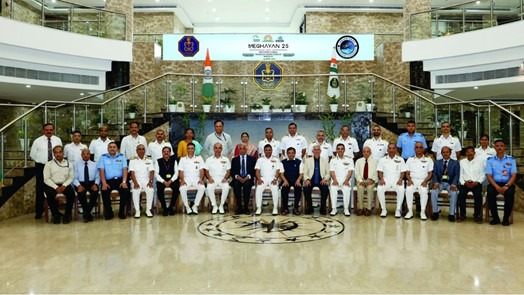
Technical Sessions
- Session I:
- Moderator: RAdm G Rambabu (Principal, INA)
- Focus: Developments in Marine Meteorology and Oceanology
- Format: Presentations and Q&A
- Session II:
- Moderator: Cmde SMU Athar
- Focus: Statistical Approaches in Weather Forecasting
- Format: Presentations and Audience Interaction
Panel Discussion:
- Theme: “Closing the Early Warning Gap Together: Enhancing Maritime Security and Coordination”
- Moderator: VAdm Pradeep Chauhan (Retd), Director General, NMF
- Objective: Strategies for Integrated Maritime Safety and Disaster Preparedness
Key Highlights and Launches:
- Felicitation of Cmde PI Oommen (Retd): Honored as the pioneer of the Navy’s Meteorological Specialisation.
Launch of MOSDAC-IN Web Services:
- Jointly developed by DNOM and SAC
- Offers customized satellite-based weather data with individual logins for Naval Met Offices.
Revival of the Sagarmanthan Journal:
- The 10th edition was launched after a decade-long gap.
- This symposium aimed to enhance collaboration between defense and scientific bodies to improve maritime safety and weather forecasting, with a focus on bridging gaps in early warning systems and disaster preparedness.
Consider the following statements regarding the Meghayan-25 symposium organized by the Indian Navy:
- The symposium was held to mark World Meteorological Day 2025 and focused on closing gaps in early warning systems.
- The theme for World Meteorological Day 2025 was “Enhancing Maritime Security and Coordination.”
- The symposium featured participation from key defense and scientific institutions, including the India Meteorological Department (IMD) and ISRO’s Space Applications Centre (SAC).
- The event included technical sessions focusing on developments in marine meteorology, statistical approaches in weather forecasting, and integrated maritime safety.
Which of the above statements are correct?
A. 1, 3, and 4 only
B. 2, 3, and 4 only
C. 1, 2, and 3 only
D. 1, 3, and 4 only
Answer: A. 1, 3, and 4 only
Explanation:
- Statement 1 is correct: The Meghayan-25 symposium was indeed held to mark World Meteorological Day 2025, with a focus on closing gaps in early warning systems.
- Statement 2 is incorrect: The theme for World Meteorological Day 2025 was “Closing the Early Warning Gap Together,” not “Enhancing Maritime Security and Coordination.”
- Statement 3 is correct: The symposium involved participation from important defense and scientific institutions like IMD, SAC, and others.
- Statement 4 is correct: The event had technical sessions focusing on developments in marine meteorology, weather forecasting, and integrated maritime safety.
Intermediate-Mass Black Hole (IMBH)
Syllabus:GS3/Space

In the News
- Indian astronomers have successfully detected and measured an Intermediate-Mass Black Hole (IMBH) in the dwarf spiral galaxy NGC 4395 using the 6-metre Devasthal Optical Telescope (DOT).
About NGC 4395
- A dwarf spiral galaxy located ~14 million light-years from Earth.
- It is one of the closest and faintest known Seyfert galaxies, characterized by a low surface brightness.
- Seyfert Galaxies possess active galactic nuclei (AGNs) powered by supermassive black holes, emitting radiation across the electromagnetic spectrum.
- The central black hole in NGC 4395 is around 10,000 solar masses.
- Intermediate-Mass Black Holes (IMBHs)
- Mass Range: Between stellar-mass and supermassive black holes (approx. 100–100,000 solar masses).
- Considered the “missing link” in black hole evolution.
- Serve as seeds for the growth of supermassive black holes, helping explain early universe galaxy formation.
Why Are IMBHs Hard to Detect?
- IMBHs emit faint radiation and are often located in small or dim galaxies.
- Traditional detection methods (like X-ray or radio observation) are less effective.
- Require advanced instruments and high-precision spectroscopy like that of DOT.
Key Highlights of the Discovery
- Offers strong evidence for the size-luminosity relationship in low-luminosity AGNs.
- Provides one of the most accurate mass estimates of an IMBH to date.
- The black hole is accreting matter at 6% of its Eddington (theoretical maximum) rate.
- Marks a significant step forward in understanding black hole growth and galaxy evolution.
About Devasthal Optical Telescope (DOT)
- Commissioned: 2016
- Location: Nainital, Uttarakhand
- Operator: ARIES (Aryabhatta Research Institute of Observational Sciences)
- Significance: India’s largest optical telescope, equipped for visible and near-infrared imaging and spectroscopy.
- A national facility aiding advanced astronomical research.
Understanding Black Holes
- A black hole is a space region with gravitational force so intense that not even light can escape.
- Predicted by Einstein’s General Theory of Relativity (1915).
- The term “black hole” was coined by John Archibald Wheeler in the 1960s.
- Typically formed when massive stars collapse post-supernova.
Types of Black Holes
- Stellar-Mass Black Holes
- Mass: Few to tens of solar masses
- Formation: Collapse of massive stars post-supernova
- Intermediate-Mass Black Holes (IMBHs)
- Mass: 100 to ~100,000 solar masses
- Significance: Bridge between stellar and supermassive types
- Supermassive Black Holes
- Mass: Hundreds of thousands to billions of solar masses
- Location: Cores of most galaxies (e.g., Milky Way)
Consider the following statements about the Devasthal Optical Telescope (DOT):
- It is India’s largest radio telescope located in Ladakh.
- It is operated by ARIES and specializes in optical and near-infrared observations.
- It was instrumental in detecting an intermediate-mass black hole in the galaxy NGC 4395.
Which of the statements given above is/are correct?
A. 1 and 2 only
B. 2 and 3 only
C. 1 and 3 only
D. 1, 2, and 3
Answer: B
Explanation:
- Statement 1 is incorrect (DOT is an optical, not a radio telescope, and it’s in Nainital, not Ladakh).
- Statements 2 and 3 are correct
Ministry of Ayush Organized Rashtriya Karmayogi Jan Seva Programme
Syllabus:Health
- The Ministry of Ayush organized a special session of the Rashtriya Karmayogi Jan Seva Programme at Ayush Bhawan in New Delhi on April 16, 2025.
- This initiative is part of the Mission Karmayogi framework and was conducted in collaboration with the Capacity Building Commission (CBC).
- The programme focuses on improving service orientation, enhancing professional capacity, and boosting public service efficiency among the personnel of the Ministry.
Key Highlights
- Organizing Ministry: Ministry of Ayush
- Programme Name: Rashtriya Karmayogi Jan Seva Programme
- Date of Event: April 16, 2025
- Venue: Ayush Bhawan, New Delhi
- Under Mission: Mission Karmayogi
- Collaboration: Capacity Building Commission (CBC)
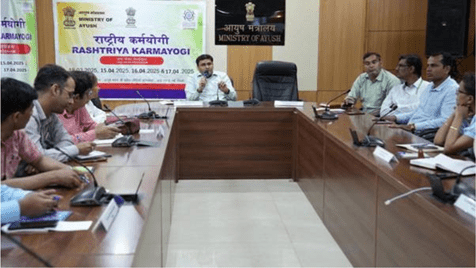
Phase-wise Programme Overview
- First Phase:
- Inaugurated by: Vaidya Rajesh Kotecha, Secretary, Ministry of Ayush
- Focus on cultivating a responsive and efficient workforce.
- Emphasis on the practical application of training in daily official duties.
- Second Phase:
- Led by: Dr. Subodh Kumar (Programme Director)
- Facilitated by: Ms. Shipra Singh
- Focused on interactive, activity-based learning.
- Included group discussions, team exercises, and problem-solving activities.
Core Themes of the Training Sessions
- Self-awareness
- Motivation
- Leadership
- Public Service Contribution
- The training utilized case studies from Ayurveda, Yoga, and traditional medicine as tools for learning, incorporating real-life examples to ensure contextual relevance for the participants.
Participation and Impact:
- Ministry officials actively participated, gaining a deeper understanding of their roles in public service.
- The programme strengthened their awareness of organizational goals and the importance of citizen-centric service delivery.
Consider the following statements regarding the Rashtriya Karmayogi Jan Seva Programme conducted in April 2025:
- The programme was held under the framework of Mission Karmayogi in partnership with the NITI Aayog.
- It was designed to enhance service delivery efficiency, leadership skills, and self-awareness among officials of the Ministry of Ayush.
- Real-life case studies from traditional Indian systems like Ayurveda and Yoga were integrated into the training modules.
- The programme was entirely lecture-based with minimal emphasis on group interaction or practical exercises.
Which of the statements given above are correct?
A. 1 and 2 only
B. 2 and 3 only
C. 1, 2 and 4 only
D. 2, 3 and 4 only
Answer: B. 2 and 3 only
Explanation:
- Statement 1 is incorrect: The programme was organized in collaboration with the Capacity Building Commission (CBC), not NITI Aayog.
- Statement 2 is correct: One of the key goals was to improve public service efficiency, motivation, leadership, and self-awareness among Ayush Ministry personnel.
- Statement 3 is correct: Training sessions incorporated case studies from Ayurveda, Yoga, and traditional systems to enhance contextual relevance.
- Statement 4 is incorrect: The programme emphasized interactive and activity-based learning, including team exercises and group discussions, rather than being purely lecture-based.
WHO Pandemic Treaty Proposal Finalised
Syllabus:Health
- The World Health Organization (WHO) has finalized a groundbreaking proposal for a Pandemic Treaty, a global agreement aimed at enhancing pandemic prevention, preparedness, and response.
- This proposal, developed by the Intergovernmental Negotiating Body (INB), will be presented at the 78th World Health Assembly (WHA) on May 19, 2025.
- The treaty emerges after extensive negotiations and is designed to foster international cooperation while respecting national sovereignty, ensuring a fair and swift response to future global health crises.
Key Highlights
Formation & Purpose:
- The proposal was finalized by the INB, which was created in December 2021.
- Its primary goal is to establish a binding international instrument under the WHO Constitution to improve pandemic prevention, preparedness, and response (PPR).
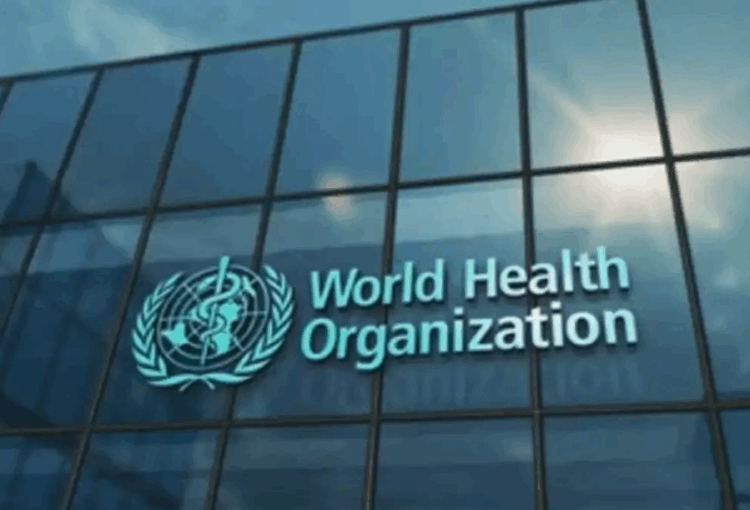
Timeline of Negotiations:
- The INB held 13 formal negotiation rounds, with 9 extended sessions, alongside several informal and intersessional discussions.
- The final text will be reviewed at the 78th WHA in May 2025.
Major Provisions in the Draft Text:
- Pathogen Access and Benefit-Sharing System (PABS): Establishes mechanisms for equitable sharing of pathogens and benefits.
- One Health Approach: A holistic strategy linking human, animal, and environmental health.
- Equitable R&D and Technology Transfer: Focuses on promoting diverse R&D capacities and ensuring technology, skills, and knowledge-sharing globally.
- Global Health Emergency Workforce: Creation of a skilled, multidisciplinary workforce for pandemic responses.
- Global Supply Chain: Establishment of a coordinated network for distributing health products.
- Financial Mechanism: A global fund to support pandemic preparedness and response.
Safeguarding National Sovereignty:
- The treaty respects national sovereignty in public health matters and does not grant WHO the authority to:
- Impose national laws or policies.
- Mandate travel bans, lockdowns, vaccinations, or therapeutics.
- Ensure voluntary compliance while respecting national jurisdiction.
Statements from WHO:
- Tedros Adhanom Ghebreyesus, WHO Director-General, described the agreement as a “generational accord” that demonstrates the continued relevance of multilateralism in addressing global health challenges.
Consider the following statements regarding the WHO Pandemic Treaty:
- The Intergovernmental Negotiating Body (INB), established in 2021, finalized the draft text for the Pandemic Treaty to be presented at the 78th World Health Assembly (WHA) in May 2025.
- The proposed treaty aims to establish a Pathogen Access and Benefit-Sharing System (PABS) to ensure equitable access to pandemic-related technologies, including vaccines.
- The One Health Approach, integral to the treaty, emphasizes only the health of humans, disregarding the interconnections between environmental and animal health.
- The treaty allows the World Health Organization (WHO) to impose mandatory travel bans, lockdowns, and vaccinations during future pandemics, overriding national sovereignty.
Which of the above statements are correct?
A. 1 and 2 only
B. 1, 2, and 3 only
C. 2 and 4 only
D. 1, 3, and 4 only
Answer: A. 1 and 2 only
Explanation:
- Statement 1 is correct: The INB, established in December 2021, has finalized the draft text of the Pandemic Treaty, which will be presented at the 78th World Health Assembly (WHA) in May 2025.
- Statement 2 is correct: The treaty proposes the creation of a Pathogen Access and Benefit-Sharing System (PABS), which aims to ensure equitable access to pandemic-related technologies, including vaccines and treatments.
- Statement 3 is incorrect: The One Health Approach is designed to recognize and address the interconnections between human, animal, and environmental health, contrary to what is suggested in the statement.
- Statement 4 is incorrect: The treaty does not grant the World Health Organization (WHO) the authority to impose mandatory travel bans, lockdowns, or vaccinations. Instead, it emphasizes voluntary implementation respecting national sovereignty, ensuring that these measures remain within the jurisdiction of individual nations.
Making Primary Health Care Visible, Accessible, and Affordable
Syllabus: GS2/Health
Context
India has been actively reforming its primary healthcare system through progressive policies and programs aimed at overcoming key challenges such as accessibility, affordability, and visibility.
What is Primary Healthcare (PHC)?
- According to the World Health Organization (WHO), Primary Health Care is a comprehensive, society-wide approach to health systems that brings essential health and well-being services closer to communities.
- PHC is designed to be accessible, affordable, and inclusive, covering the full spectrum of care—promotive, preventive, curative, rehabilitative, and palliative.
- This approach was first globally recognized in the Alma-Ata Declaration of 1978, which emphasized health care based on scientifically sound and socially acceptable practices as the cornerstone of universal health access.

Key Issues in India’s Primary Healthcare System
Urban vs. Rural Divide:
- Despite proximity to advanced facilities, urban slums face overcrowding and affordability challenges.
- Meanwhile, rural areas—home to over 65% of the population—struggle with a lack of healthcare centers, trained personnel, and poor transport infrastructure.
Human Resource Shortages (2023–24):
- 77% shortfall in surgeons
- 69% shortfall in obstetricians
- 70% shortfall in physicians at Community Health Centres (CHCs)
- 10–25% vacancy in nursing staff across various states
Rising Burden of Non-Communicable Diseases (NCDs) and Mental Health:
- PHCs now face the added responsibility of addressing lifestyle-related diseases and mental health concerns.
- However, gaps in infrastructure and training often limit their effectiveness.
Key Government Initiatives
National Health Mission (NHM):
India operates an extensive network of healthcare facilities, including:
- 6 lakh Sub-Centres (SCs)
- 26,636 Primary Health Centres (PHCs)
- 6,155 Community Health Centres (CHCs):These act as the first point of contact for most healthcare seekers.
Ayushman Bharat Program (2018):
- Aims to transform the PHC landscape through the creation of Health and Wellness Centres (HWCs), offering expanded services like maternal and child care, mental health, NCD management, and geriatric services.
- Comprehensive Primary Health Care (CPHC):As outlined in the National Health Policy 2017, this initiative promotes universal health coverage by integrating traditional medicine systems (AYUSH) with modern healthcare delivery.
- Focus on Underserved Areas: Programs such as the Aspirational District Program (ADP) and Aspirational Block Program (ABP) target healthcare improvements in the most backward regions.
- PM Ayushman Bharat Health Infrastructure Mission (PM-ABHIM): With an investment of ₹64,180 crore, this mission strengthens healthcare infrastructure and builds resilience against future health emergencies.
- Women-Led Initiatives: Over 1.9 crore women are involved in Self Help Groups (SHGs), playing a key role in spreading awareness about primary healthcare services and promoting community health participation.
Global Support and Collaborations
- Universal Health Coverage (UHC):A global commitment to ensuring equitable access to quality health services without financial hardship. Scaling up PHC in developing nations could save 60 million lives and extend average life expectancy by 3.7 years by 2030.
- Global Health Programs: Initiatives like the Global Fund to Fight AIDS, Tuberculosis, and Malaria and the Gavi Alliance help integrate PHC with disease-specific strategies and immunization efforts.
Way Forward
- Infrastructure DevelopmentExpanding the reach and functionality of HWCs, especially in remote areas, and investing in telemedicine to bridge the urban-rural healthcare divide.
- Increasing Awareness:Strengthening community outreach and health education to improve service visibility and community participation.
- Enhancing Affordability:Continued focus on reducing out-of-pocket expenses through schemes like PM-JAY to ensure financial protection for all.
With reference to India’s efforts in integrating traditional medicine systems in primary healthcare, consider the following statements:
- AYUSH services are being incorporated under the Comprehensive Primary Health Care model.
- The National Health Policy 2017 explicitly mentions the role of traditional systems in achieving Universal Health Coverage (UHC).
- Ayurveda and Yoga are restricted to wellness centres and not used in curative services.
Which of the statements given above is/are correct?
- 1 and 2 only
B. 2 and 3 only
C. 1 and 3 only
D. 1, 2, and 3
Answer:A
Explanation:
- Statement 1 is correct: AYUSH is a core part of the Comprehensive Primary Health Care model.
- Statement 2 is correct: The National Health Policy 2017 promotes integrating AYUSH into the mainstream for achieving UHC.
- Statement 3 is incorrect: AYUSH is used in both preventive and curative aspects, not restricted to wellness.
Vehicle-to-Grid (V2G) Technology
Syllabus :GS 3/Science and Technology
- The Kerala State Electricity Board (KSEB), in collaboration with IIT Bombay, has launched a pilot project to explore the feasibility and implementation of Vehicle-to-Grid (V2G) technology in Kerala.
- While this technology remains in a nascent stage in India, it holds transformative potential for the country’s energy landscape.
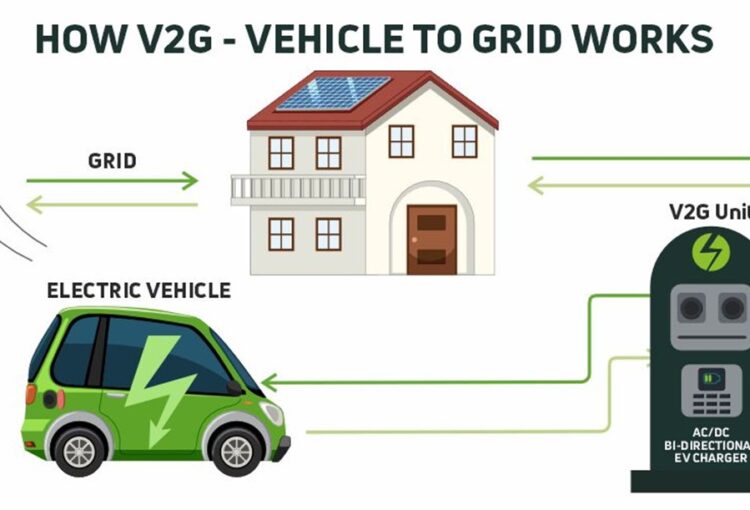
Understanding Vehicle-to-Grid (V2G) Technology
- Vehicle-to-Grid (V2G) is an emerging energy solution that facilitates two-way energy flow between electric vehicles (EVs) and the power grid.
- This innovation allows EVs to function as decentralized mobile energy storage units, thereby enhancing the sustainability, flexibility, and resilience of grid infrastructure.
- G2V (Grid-to-Vehicle): EVs are charged from the electricity grid.
- V2G (Vehicle-to-Grid): EVs discharge stored electricity back into the grid.
- By enabling energy transfer in both directions, V2G technology contributes to load balancing, demand-side management, and renewable energy integration.
Key Benefits of V2G Technology
- Peak Load Management:Helps prevent grid overload during peak demand hours by supplying energy from EV batteries.
- Renewable Energy Storage:Enables the storage of surplus solar or wind energy generated during off-peak hours and its redistribution during demand peaks.
- Enhanced Grid Stability:EVs can act as spinning reserves, adjusting their power supply to stabilize voltage and frequency fluctuations, especially from intermittent renewable sources.
- Policy Levers:Adoption can be incentivized through smart charging systems, Time-of-Use (ToU) tariffs, and financial rewards for EV owners participating in V2G services.
Challenges to V2G Integration
- Regulatory Hurdles:Implementation is constrained by fragmented, evolving, and often region-specific regulatory frameworks, which lack standardization.
- Technical Constraints:Unpredictable EV usage patterns, non-uniform charging behaviors, and the current lack of bi-directional charging infrastructure limit practical deployment.
- Cybersecurity Risks:With real-time data exchange and grid connectivity, V2G systems are vulnerable to data breaches, hacking, and system disruption, necessitating robust cybersecurity protocols.
Global Adoption and Applications
- Europe, the U.S., and the U.K. have already adopted V2G solutions at scale.
- EV owners receive monetary compensation for feeding energy back into the grid during peak periods.
- In California, V2G technology supports emergency grid stabilization, offering power during outages and crises.
Conclusion and Way Forward
- V2G technology presents a paradigm shift in energy and transport convergence. It holds immense potential to:
- Provide ancillary grid services such as frequency regulation and spinning reserves
- Act as a buffer for renewable energy, facilitating the transition toward a decarbonized energy economy
- Enhance grid resilience and reliability, especially as EV adoption surges and distributed energy resources proliferate
Future Outlook:
- India must prioritize pilot projects, infrastructure development, and regulatory harmonization.
- A data-driven approach to optimize EV charging behavior will be critical in ensuring grid reliability and long-term sustainability.
With reference to Vehicle-to-Grid (V2G) technology, consider the following statements:
- It allows bidirectional flow of electricity between the power grid and electric vehicles.
- It is limited to charging EVs from the grid during off-peak hours.
- V2G supports grid resilience and renewable energy integration.
Which of the statements given above is/are correct?
A. 1 and 2 only
B. 1 and 3 only
C. 2 and 3 only
D. 1, 2 and 3
Answer:B
Explanation:
- Statement 1 is correct: V2G allows two-way energy flow between EVs and the grid.
- Statement 2 is incorrect: That describes only Grid-to-Vehicle (G2V), not the full V2G capability.
- Statement 3 is correct: V2G helps balance loads, stabilize voltage, and support renewables.
Plastic Parks in India
Syllabus: GS 3/Environment
- The Plastic Parks Scheme is gaining prominence as a strategic initiative to promote industrial development and environmental sustainability within India’s plastics sector.
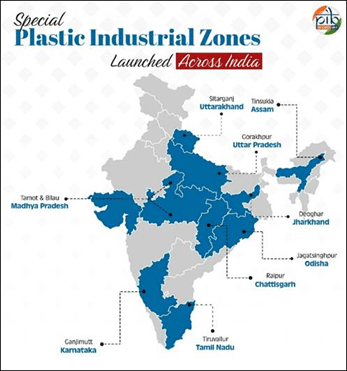
What are Plastic Parks?
- Plastic Parks are dedicated industrial zones developed specifically for plastic processing and allied industries. These parks aim to:
- Consolidate and synergize the fragmented plastic processing sector.
- Attract investments and boost production and exports.
- Generate employment and enhance technological innovation.
- Promote environmentally sustainable practices through integrated waste management and recycling systems.
Significance and Progress:
- Plastic Parks form a critical component of India’s broader strategy for plastic waste management and circular economy.
- India is now 12th globally in plastic exports, with figures rising from $8.2 billion in 2014 to $27 billion in 2022, largely due to proactive policy measures like this scheme.
- So far, 10 Plastic Parks have been approved across various states.
Challenges in the Sector:
- The Indian plastics industry, though substantial, is highly fragmented, dominated by micro, small, and medium enterprises (MSMEs).
- These units often lack the infrastructure and scale to compete globally or implement sustainable practices effectively.
Government Interventions:
- The Department of Chemicals and Petrochemicals is implementing the scheme to establish state-of-the-art infrastructure for plastic parks.
- A cluster development approach is used to enable shared common facilities, including recycling and innovation hubs.
- The Government of India provides financial assistance up to 50% of the project cost, subject to a maximum of ₹40 crore per park.
Conclusion:
The Plastic Parks Scheme represents a transformative initiative to bolster India’s plastic processing industry by promoting scale, sustainability, and competitiveness. As India’s share in global plastic trade expands, these parks will be pivotal in ensuring inclusive, innovative, and eco-conscious growth, aligning with national objectives of ‘Make in India’ and sustainable development.
Consider the following statements regarding the Plastic Parks Scheme:
- It is implemented by the Ministry of Chemicals and Fertilizers.
- The scheme provides 100% central assistance for the development of parks.
- It aims to promote cluster development and common infrastructure.
Which of the statements given above is/are correct?
A. 1 and 2 only
B. 1 and 3 only
C. 2 and 3 only
D. 1, 2 and 3
Answer: B. 1 and 3 only
Explanation:
- Statement 1 is correct: The scheme is indeed implemented by the Department of Chemicals and Petrochemicals, under the Ministry of Chemicals and Fertilizers.
- Statement 2 is incorrect: The GoI provides financial assistance up to 50%, not 100%, with a cap of ₹40 crore per park.
- Statement 3 is correct: It adopts a cluster development approach to build shared infrastructure and common facilities.
Six New Scarab Beetles Discovered in India
Syllabus:Environment
- India’s remarkable biodiversity continues to unfold as scientists report the discovery of six new species of scarab beetles from two of the country’s premier ecological regions—Northeast India and the Western Ghats.
- The findings, recently published in the peer-reviewed journal Zootaxa, emphasize the critical need for sustained conservation, research, and biodiversity mapping.
New Species Identified (Subfamily: Sericinae)
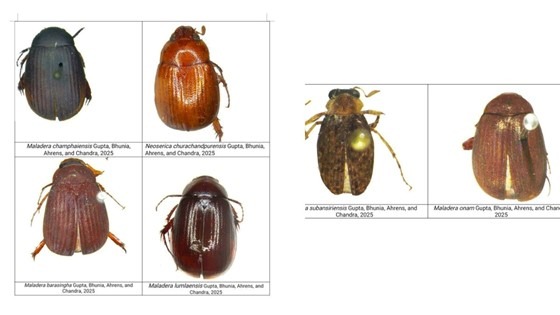
The newly documented beetles belong to the subfamily Sericinae, known for their roles in ecosystem functioning. The six species are:
- Maladera champhaiensis – Discovered in Champhai, Mizoram
- Maladera barasingha – Named after the swamp deer (barasingha) due to its antler-like structure
- Maladera lumlaensis – Found in Lumla, Arunachal Pradesh
- Maladera onam – Located in Kerala; named after the Onam festival
- Neoserica churachandpurensis – Identified in Churachandpur, Manipur
- Serica subansiriensis – From Subansiri, Arunachal Pradesh
Research Team & Collaborative Effort
The species were described by:
- Devanshu Gupta
- Debika Bhunia
- Dirk Ahrens
- Kailash Chandra
This research represents a collaborative endeavor between the Zoological Survey of India (ZSI) and Germany’s Museum Alexander Koenig, highlighting the importance of international cooperation in taxonomy and conservation science.
Regions of Discovery
- Five species were discovered in Northeast India, a region falling within the Eastern Himalayas—an area celebrated for its endemic diversity and evolutionary significance.
- One species was found in Kerala, part of the Western Ghats, a UNESCO World Heritage Site known for its exceptional biodiversity.
Methodology & Additional Findings
The discoveries were based on the examination of specimens housed in the National Zoological Collection maintained by the ZSI. As a result of this detailed survey, 28 new state-level distribution records were also established. Notable examples include:
- Maladera bengalensis recorded for the first time in Goa
- Maladera seriatoguttata in Maharashtra
Ecological Significance of Sericinae Beetles
Beetles of the Sericinae subfamily are ecologically important, playing key roles in:
- Soil aeration
- Nutrient cycling
- Natural pest regulation
While some species are agricultural pests, many contribute significantly to maintaining soil health and ecosystem stability.
Why It Matters
- This discovery not only enriches the understanding of India’s insect biodiversity but also:
- Reinforces the ecological significance of India’s biodiversity hotspots
- Urges the need for deeper scientific exploration and documentation
- Emphasizes the importance of preserving fragile ecosystems amid growing environmental threats.
Which of the following biodiversity hotspots are associated with the recent discovery of six new Sericinae scarab beetle species in India?
- Eastern Himalayas
- Sundarbans
- Western Ghats
- Indo-Gangetic Plains
Select the correct answer using the code below:
A) 1 and 2 only
B) 1 and 3 only
C) 2 and 4 only
D) 1, 3, and 4 only
Answer: B) 1 and 3 only
Explanation: India is home to four biodiversity hotspots as recognized globally:
Eastern Himalayas
- Indo-Burma (includes parts of Northeast India)
- Western Ghats and Sri Lanka
- Sundaland (includes Nicobar Islands)
In the recent discovery published in Zootaxa, six new Sericinae scarab beetle species were identified. Their locations are:
Five species were discovered in Northeast India, which falls within the Eastern Himalayas hotspot. These include:
- Maladera champhaiensis (Mizoram)
- Maladera barasingha
- Maladera lumlaensis (Arunachal Pradesh)
- Neoserica churachandpurensis (Manipur)
- Serica subansiriensis (Arunachal Pradesh)
One species, Maladera onam, was found in Kerala, part of the Western Ghats, another biodiversity hotspot.
Six New Scarab Beetles Discovered in India
Syllabus:Environment
- India’s remarkable biodiversity continues to unfold as scientists report the discovery of six new species of scarab beetles from two of the country’s premier ecological regions—Northeast India and the Western Ghats.
- The findings, recently published in the peer-reviewed journal Zootaxa, emphasize the critical need for sustained conservation, research, and biodiversity mapping.
New Species Identified (Subfamily: Sericinae)

The newly documented beetles belong to the subfamily Sericinae, known for their roles in ecosystem functioning. The six species are:
- Maladera champhaiensis – Discovered in Champhai, Mizoram
- Maladera barasingha – Named after the swamp deer (barasingha) due to its antler-like structure
- Maladera lumlaensis – Found in Lumla, Arunachal Pradesh
- Maladera onam – Located in Kerala; named after the Onam festival
- Neoserica churachandpurensis – Identified in Churachandpur, Manipur
- Serica subansiriensis – From Subansiri, Arunachal Pradesh
Research Team & Collaborative Effort
The species were described by:
- Devanshu Gupta
- Debika Bhunia
- Dirk Ahrens
- Kailash Chandra
This research represents a collaborative endeavor between the Zoological Survey of India (ZSI) and Germany’s Museum Alexander Koenig, highlighting the importance of international cooperation in taxonomy and conservation science.
Regions of Discovery
- Five species were discovered in Northeast India, a region falling within the Eastern Himalayas—an area celebrated for its endemic diversity and evolutionary significance.
- One species was found in Kerala, part of the Western Ghats, a UNESCO World Heritage Site known for its exceptional biodiversity.
Methodology & Additional Findings
The discoveries were based on the examination of specimens housed in the National Zoological Collection maintained by the ZSI. As a result of this detailed survey, 28 new state-level distribution records were also established. Notable examples include:
- Maladera bengalensis recorded for the first time in Goa
- Maladera seriatoguttata in Maharashtra
Ecological Significance of Sericinae Beetles
Beetles of the Sericinae subfamily are ecologically important, playing key roles in:
- Soil aeration
- Nutrient cycling
- Natural pest regulation
While some species are agricultural pests, many contribute significantly to maintaining soil health and ecosystem stability.
Why It Matters
- This discovery not only enriches the understanding of India’s insect biodiversity but also:
- Reinforces the ecological significance of India’s biodiversity hotspots
- Urges the need for deeper scientific exploration and documentation
- Emphasizes the importance of preserving fragile ecosystems amid growing environmental threats.
Which of the following biodiversity hotspots are associated with the recent discovery of six new Sericinae scarab beetle species in India?
- Eastern Himalayas
- Sundarbans
- Western Ghats
- Indo-Gangetic Plains
Select the correct answer using the code below:
A) 1 and 2 only
B) 1 and 3 only
C) 2 and 4 only
D) 1, 3, and 4 only
Answer: B) 1 and 3 only
Explanation: India is home to four biodiversity hotspots as recognized globally:
Eastern Himalayas
- Indo-Burma (includes parts of Northeast India)
- Western Ghats and Sri Lanka
- Sundaland (includes Nicobar Islands)
In the recent discovery published in Zootaxa, six new Sericinae scarab beetle species were identified. Their locations are:
Five species were discovered in Northeast India, which falls within the Eastern Himalayas hotspot. These include:
- Maladera champhaiensis (Mizoram)
- Maladera barasingha
- Maladera lumlaensis (Arunachal Pradesh)
- Neoserica churachandpurensis (Manipur)
- Serica subansiriensis (Arunachal Pradesh)
One species, Maladera onam, was found in Kerala, part of the Western Ghats, another biodiversity hotspot.
Shifting Cheetahs From Kuno Park to Gandhi Sagar
Syllabus :GS 3/ Environment
- The Cheetah Project Steering Committee has approved the relocation of cheetahs from Kuno National Park to Gandhi Sagar Wildlife Sanctuary in Madhya Pradesh, ~300 km away.
- Aim: To establish a metapopulation of 60–70 cheetahs across the Kuno-Gandhi Sagar landscape, covering parts of Madhya Pradesh and Rajasthan.
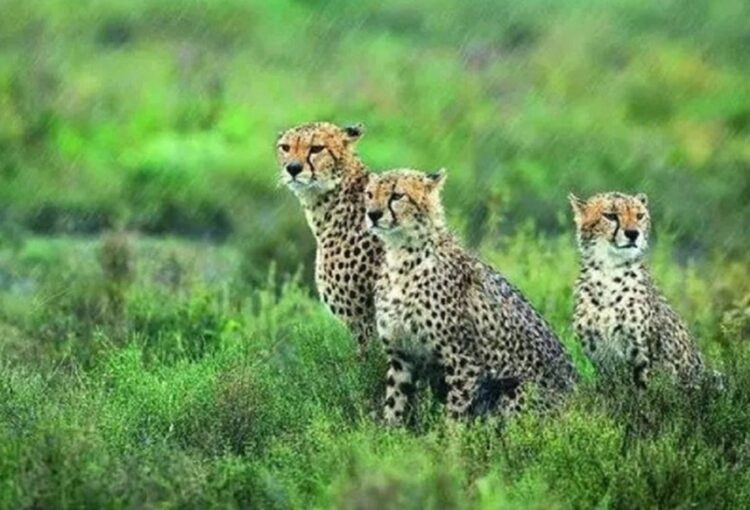
Project Cheetah – Overview
- Launched in 2022 with 8 cheetahs from Namibia and 12 from South Africa
- Since then, 8 adult cheetahs and 5 cubs have died
Implemented by the National Tiger Conservation Authority (NTCA) under MoEF&CC, in partnership with:
- Madhya Pradesh Forest Department
- Wildlife Institute of India (WII)
- Cheetah experts from Namibia & South Africa
Did You Know?
- Cheetahs are the world’s fastest land animals (60–70 mph)
- Adapted with a slender build, long limbs, and semi-retractable claws
- Once widespread in Africa and Asia, now found in only 10% of their original range
- A critically endangered population exists in Iran
- Declared extinct in India in 1952
Cheetah Status at Kuno (2025):
- 26 cheetahs total
- 17 in the wild, 9 in enclosures
- Relocation group yet to be decided
About Gandhi Sagar Wildlife Sanctuary
- Located in eastern Madhya Pradesh, along the Chambal River, near Gandhi Sagar Dam
- Part of the Khathiar-Gir Dry Deciduous Forests eco-region
- Features mixed dry deciduous vegetation
- Houses the Chaturbhuj Nala rock shelters with prehistoric cave paintings
With reference to cheetah conservation efforts in India, consider the following statements:
- The relocation of cheetahs from Kuno National Park to Gandhi Sagar Wildlife Sanctuary is aimed at enhancing genetic diversity within a confined breeding population.
- Gandhi Sagar Wildlife Sanctuary lies within the Central Indian Highlands and belongs to the Northern Tropical Moist Deciduous Forests eco-region.
- Project Cheetah is implemented solely by the National Tiger Conservation Authority without international collaboration.
- Cheetahs have been reintroduced into India despite being globally classified as extinct in the wild.
Which of the statements given above is/are correct?
A. 1 and 2 only
B. 1 and 4 only
C. 3 and 4 only
D. None of the above
Answer: D. None of the above
Explanation:
- Statement 1 is incorrect because the relocation aims to establish a metapopulation across a landscape to ensure population stability and resilience, not merely to enhance genetic diversity within a confined group.
- Statement 2 is incorrect as Gandhi Sagar Wildlife Sanctuary falls under the Khathiar-Gir Dry Deciduous Forests eco-region, not the Northern Tropical Moist Deciduous type.
- Statement 3 is incorrect because Project Cheetah is being implemented by the NTCA in collaboration with the Madhya Pradesh Forest Department, Wildlife Institute of India, and international experts from Namibia and South Africa.
- Statement 4 is incorrect as cheetahs are not globally extinct in the wild; they are present in parts of Africa and Iran. They were declared extinct in India in 1952, not globally.
Karad Sanitary Waste Management Model
Syllabus:Environment
What is it?:
- Karad city in Maharashtra’s Satara district has pioneered a comprehensive system for the safe segregation, collection, and disposal of sanitary and biomedical waste.
- This model sets a national benchmark for waste management.
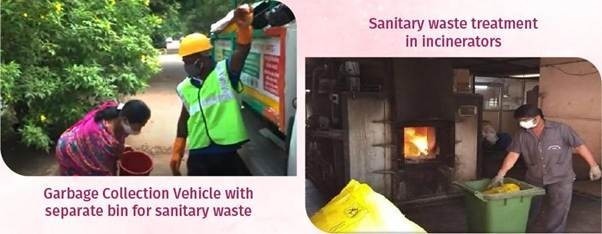
How it Works:
- Collection: Red bins are strategically placed at public toilets, and garbage vehicles are equipped with dedicated bins specifically for sanitary waste.
- Processing: The collected waste is transported to a Common Biomedical Waste Treatment Facility (CBWTF) managed by the Karad Hospital Association. The waste is incinerated at temperatures of up to 1200°C to ensure safe disposal.
- Monitoring: The State Pollution Control Board ensures real-time oversight, guaranteeing compliance with environmental standards.
- Community Engagement: The model promotes women’s health through awareness campaigns led by women. Schools are equipped with sanitary facilities, such as vending machines and incinerators.
- PPP Model: The municipal council handles waste collection, while the hospital association is responsible for the incineration process, which is offered free of cost to citizens.
Significance: The Karad model promotes hygiene, enhances women’s health, and ensures environmental safety. It serves as a scalable solution for smaller and medium-sized cities looking to improve sanitary waste management efficiently.
Consider the following statements regarding Karad city’s sanitary waste management model:
- The model is based on a public-private partnership (PPP) framework where the municipal council handles the waste collection and the hospital association is responsible for incineration.
- The sanitary waste is incinerated at temperatures of up to 500°C in the Common Biomedical Waste Treatment Facility (CBWTF).
- The initiative has led to significant improvements in hygiene, women’s health, and environmental safety, serving as a scalable model for small and medium cities.
Which of the statements given above is/are correct?
A. 1 and 2 only
B. 1 and 3 only
C. 2 and 3 only
D. 1, 2, and 3
Answer: B. 1 and 3 only
Explanation:
- Statement 1 is correct. The model operates on a public-private partnership (PPP) structure, where the municipal council handles the collection of sanitary waste, while the hospital association is responsible for the incineration
- Statement 2 is incorrect. The waste is incinerated at temperatures up to 1200°C, not 500°C, to ensure safe and complete disposal.
- Statement 3 is correct. The model promotes hygiene, improves women’s health, and ensures environmental safety. It has also proven to be a scalable model for other small and medium cities to adopt for efficient sanitary waste management.
Delhi Airport Ranked 9th Busiest in the World As ACI World Report 2024
Syllabus: Indices and Reports
- In a significant milestone for India’s civil aviation sector, Indira Gandhi International (IGI) Airport, Delhi, has been ranked the 9th busiest airport in the world for the year 2024, according to preliminary rankings released by the Airports Council International (ACI) World.
Key Details:
- Rank Achieved: 9th globally in terms of total passenger traffic.
- Passenger Volume (2024): 77 million passengers handled.
- Ranking Authority: Airports Council International (ACI) World.
- Operated by: Delhi International Airport Limited (DIAL), led by the GMR Group.
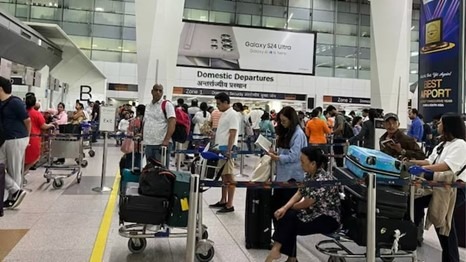
Ranking Progression (Year-wise):
- 2019: 17th
- 2021: 13th
- 2023: 10th
- 2024: 9th
This consistent climb in global rankings underscores IGI Airport’s expanding international connectivity, robust infrastructure upgrades, and sustained growth in passenger traffic.
Global Aviation Context (2024):
- Total Global Traffic:5 billion passengers
- Growth: 9% increase over 2023 and 3.8% above pre-COVID levels (2019)
- Top 10 Airports: Handled 855 million passengers (~9% of global traffic)
Top Airports:
- 1st: Atlanta Hartsfield–Jackson (USA) – 108 million+ passengers
- 2nd: Dubai International (UAE)
Delhi IGI Airport Highlights:
- Only Indian airport in the global top 10 list.
- Connects to: Over 150 domestic and international destinations.
- Awards: Winner of the ACI Airport Service Quality (ASQ) Award for “Best Airport in Asia-Pacific” for the 7th consecutive year (2024).
CEO’s Statement: Videh Kumar Jaipuriar, CEO of DIAL, emphasized that the improved ranking reflects ongoing efforts to enhance passenger experience, infrastructure, and global connectivity.
With reference to the Airports Council International (ACI) World Rankings 2024, which of the following are correct?
- IGI Airport saw a rise in global ranking consistently since 2019.
- The total global air traffic in 2024 was higher than pre-pandemic levels.
- The top 10 airports accounted for over one-fourth of the global passenger volume.
- IGI is the only Indian airport to be featured in the global top 10 list.
Select the correct answer using the code below:
A) 1 and 2 only
B) 1, 2 and 4 only
C) 2, 3 and 4 only
D) 1, 2, 3 and 4
Answer: B) 1, 2 and 4 only
Explanation:
- Statement 1: Correct – IGI rose from 17th in 2019 to 9th in 2024.
- Statement 2: Correct – 2024 traffic exceeded pre-COVID levels by 3.8%.
- Statement 3: Incorrect – Top 10 airports handled 855 million passengers, ~9% of global traffic, not over 25%.
- Statement 4: Correct – IGI is the only Indian airport in the top 10.
Delhi Airport Ranked 9th Busiest in the World As ACI World Report 2024
Syllabus: Indices and Reports
- In a significant milestone for India’s civil aviation sector, Indira Gandhi International (IGI) Airport, Delhi, has been ranked the 9th busiest airport in the world for the year 2024, according to preliminary rankings released by the Airports Council International (ACI) World.
Key Details:
- Rank Achieved: 9th globally in terms of total passenger traffic.
- Passenger Volume (2024): 77 million passengers handled.
- Ranking Authority: Airports Council International (ACI) World.
- Operated by: Delhi International Airport Limited (DIAL), led by the GMR Group.

Ranking Progression (Year-wise):
- 2019: 17th
- 2021: 13th
- 2023: 10th
- 2024: 9th
This consistent climb in global rankings underscores IGI Airport’s expanding international connectivity, robust infrastructure upgrades, and sustained growth in passenger traffic.
Global Aviation Context (2024):
- Total Global Traffic:5 billion passengers
- Growth: 9% increase over 2023 and 3.8% above pre-COVID levels (2019)
- Top 10 Airports: Handled 855 million passengers (~9% of global traffic)
Top Airports:
- 1st: Atlanta Hartsfield–Jackson (USA) – 108 million+ passengers
- 2nd: Dubai International (UAE)
Delhi IGI Airport Highlights:
- Only Indian airport in the global top 10 list.
- Connects to: Over 150 domestic and international destinations.
- Awards: Winner of the ACI Airport Service Quality (ASQ) Award for “Best Airport in Asia-Pacific” for the 7th consecutive year (2024).
CEO’s Statement: Videh Kumar Jaipuriar, CEO of DIAL, emphasized that the improved ranking reflects ongoing efforts to enhance passenger experience, infrastructure, and global connectivity.
With reference to the Airports Council International (ACI) World Rankings 2024, which of the following are correct?
- IGI Airport saw a rise in global ranking consistently since 2019.
- The total global air traffic in 2024 was higher than pre-pandemic levels.
- The top 10 airports accounted for over one-fourth of the global passenger volume.
- IGI is the only Indian airport to be featured in the global top 10 list.
Select the correct answer using the code below:
A) 1 and 2 only
B) 1, 2 and 4 only
C) 2, 3 and 4 only
D) 1, 2, 3 and 4
Answer: B) 1, 2 and 4 only
Explanation:
- Statement 1: Correct – IGI rose from 17th in 2019 to 9th in 2024.
- Statement 2: Correct – 2024 traffic exceeded pre-COVID levels by 3.8%.
- Statement 3: Incorrect – Top 10 airports handled 855 million passengers, ~9% of global traffic, not over 25%.
- Statement 4: Correct – IGI is the only Indian airport in the top 10.
Index Numbers of Wholesale Price in India Of March 2025
Syllabus:Indices
- The Department for Promotion of Industry and Internal Trade (DPIIT) released the Wholesale Price Index (WPI) data for March 2025 on April 15, 2025.
- The provisional data reveals that annual WPI inflation stood at 2.05%, compared to the same month in 2024.
- The upward trend was primarily driven by price increases in the manufacture of food products, textiles, electricity, and other manufactured goods.
- As an important macroeconomic indicator, WPI reflects price movements at the wholesale level, serving as a crucial tool for policymakers, analysts, and competitive exam aspirants alike
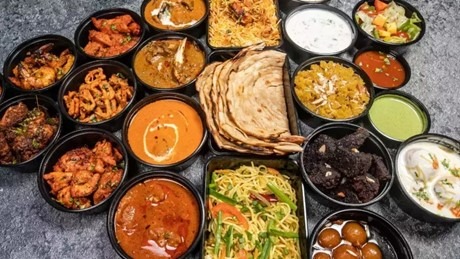
At a Glance: WPI – March 2025
Released By: DPIIT, Ministry of Commerce and Industry
Published By: Press Information Bureau (PIB), New Delhi
Date of Release: April 15, 2025
Reference Period: March 2025
Base Year: 2011–12
WPI Inflation Trends by Major Components
- All Commodities (Weight: 100%)
- Index: 154.5
- Year-on-Year (Y-o-Y) Inflation: 05%
- Shows a moderating trend from 38% in February and 2.51% in January 2025
- Primary Articles (Weight: 22.62%)
- Index: 184.6
- Inflation Rate: 76% (sharp decline from 2.81% in February)
- Month-on-Month (M-o-M) Change: -1.07%
- Sub-categories:
- Crude Petroleum & Natural Gas: -2.42%
- Non-food Articles: -2.40%
- Food Articles: -0.72%
- Minerals: +0.31%
- Fuel & Power (Weight: 13.15%)
- Index: 152.4
- Inflation Rate: 20% (turned positive after months of contraction)
- M-o-M Change: -0.91%
- Sub-categories:
- Electricity: -2.31%
- Mineral Oils: -0.70%
- Coal: No change
- Manufactured Products (Weight: 64.23%)
- Index: 144.4
- Inflation Rate: 07% (highest among all categories)
- M-o-M Change: +0.42%
- Key driver behind overall WPI inflation in March 2025.
- WPI Food Index (Weight: 24.38%)
- Index: 188.8 (slight dip from 189.0 in February)
- Inflation Rate: 66%, continuing a downward trend from 5.94% in February and 7.52% in January
- Comprises food prices from both Primary Articles and Manufactured Products.
Conclusion
- The WPI data for March 2025 reflects moderating inflation, especially in primary articles and food, while manufactured goods continue to exert upward pressure.
- The positive but tempered inflation figure of 2.05% provides a signal of stability in wholesale prices, though vigilance is needed in the face of sectoral fluctuations, especially in fuel and electricity.
With reference to the Wholesale Price Index (WPI) data released for March 2025, consider the following statements:
- The inflation rate for manufactured products was the highest among all major WPI groups.
- Primary articles showed positive month-on-month growth in March 2025.
- The WPI Food Index includes only food articles under the “Primary Articles” category.
- The Fuel & Power group recorded a negative year-on-year inflation in March 2025.
Which of the statements given above is/are correct?
A) 1 only
B) 1 and 4 only
C) 1 and 2 only
D) 2, 3, and 4 only
Answer: A) 1 only
Explanation:
- Statement 1 – Correct: Manufactured Products recorded an inflation of 07%, the highest among major categories.
- Statement 2 – Incorrect: Primary Articles saw a negative month-on-month change (-1.07%), not positive.
- Statement 3 – Incorrect: The WPI Food Index includes food items from both Primary Articles and Manufactured Products, not just Primary Articles.
- Statement 4 – Incorrect: Fuel & Power inflation turned positive at 0.20% in March 2025; it was negative in earlier months.
Ancient Jawbone Discovery Expands Insights into Denisovan Migration and Evolution
Syllabus: GS1/Geography; GS3/Science
Denisovan Jawbone Discovery Sheds Light on Archaic Human Migration
- A remarkable fossil discovery off the coast of Taiwan is reshaping our understanding of Denisovan migration and habitat.
- The fossilized jawbone, known as Penghu 1, was recovered from the Penghu Channel near Taiwan during a commercial fishing operation and offers new insights into the geographic range of these mysterious archaic humans.
Who Were the Denisovans?
- Denisovans are an extinct group of archaic humans, known largely through limited fossil remains—including a jawbone, teeth, and a finger bone.
- First Discovery: They were first identified in 2010 through DNA analysis of a finger bone found in the Denisova Cave in Siberia.
- Genetic Lineage: Studies revealed that Denisovans were a distinct branch of the human family tree, closely related to Neanderthals and Homo sapiens.
- Physical Features: Based on DNA methylation patterns, Denisovans likely had a broader skull and a longer dental arch than both Neanderthals and modern humans.
Significance of the Penghu 1 Discovery
Expanding Geographic Range: The Penghu 1 jawbone suggests Denisovans were more adaptable than previously thought, capable of surviving in diverse climates—from Siberia’s cold mountains to Taiwan’s subtropical coasts.
Key Denisovan Fossil Sites:
- Taiwan (Penghu Channel): Jawbone (Penghu 1)
- Russia (Denisova Cave): Teeth and a finger bone
- China (Baishiya Karst Cave, Tibetan Plateau): Mandible and rib fragment
- Laos (Cobra Cave): A molar likely belonging to a Denisovan based on shape
- Genetic Legacy: Denisovans interbred with both Neanderthals and modern humans. Their DNA lives on in present-day populations, particularly in Asia and Oceania.
- Notably, a gene variant from Denisovans helps modern Tibetans thrive at high altitudes.
Challenges and Future Directions
Dating Difficulties: The precise age of Penghu 1 is unclear, as it was found without surrounding sediments or datable materials. Estimates based on associated animal fossils range from 10,000 to 190,000 years old.
Need for Further Exploration: The discovery underscores the importance of investigating submerged landmasses and lesser-known regions for Denisovan remains.
Innovative Research Methods: New tools like paleoproteomics (the study of ancient proteins) may help identify additional Denisovan fossils and refine our understanding of their evolutionary story.
Recognition in Science
- In 2022, the Nobel Prize in Physiology or Medicine was awarded to Swedish geneticist Svante Pääbo for his groundbreaking work on the genomes of extinct hominins, including the Denisovans, and their role in human evolution.
Consider the following statements regarding Denisovans:
- The presence of Denisovan fossils exclusively in high-altitude regions suggests limited adaptability to environmental diversity.
- Genetic studies have confirmed Denisovan contributions to the adaptation of certain modern human populations to extreme altitudes.
- The Penghu 1 fossil is considered the earliest known Denisovan fossil found in a marine environment.
Which of the statements given above is/are correct?
A. 1 only
B. 2 only
C. 2 and 3 only
D. 1 and 3 only
Answer: B. 2 only
Explanation:
- Statement 1 is incorrect: The discovery of the Penghu 1 jawbone off the coast of Taiwan, a subtropical region, contradicts the idea that Denisovans were confined to high-altitude or cold regions. This fossil, along with others found in diverse habitats, indicates they were highly adaptable.
- Statement 2 is correct: Genetic evidence has shown that modern populations such as Tibetans possess genes inherited from Denisovans that assist with high-altitude adaptation—specifically for efficient oxygen usage.
- Statement 3 is incorrect: Although the Penghu 1 jawbone was found in a marine context (from the seabed), it is not necessarily the earliest known Denisovan fossil. Furthermore, the fossil’s precise age remains debated due to lack of datable material at the recovery site.
Neutral Conditions to Prevail in Pacific Ocean: US Weather Monitor
Syllabus: GS1/Geography
- The National Oceanic and Atmospheric Administration (NOAA) has forecasted that ENSO-neutral conditions will continue to dominate the Pacific Ocean through October 2025. This indicates the absence of El Niño or La Niña phenomena, collectively referred to as the El Niño–Southern Oscillation (ENSO).
What is ENSO?
- The El Niño–Southern Oscillation (ENSO) is a natural climate pattern resulting from interactions between the ocean and atmosphere in the equatorial Pacific Ocean, and it influences global weather.
ENSO has three phases:
El Niño:
- Warming of central and eastern Pacific Ocean waters.
- Weakens monsoons in India and Australia.
- Brings heavy rains to South America and floods in the southern U.S.

La Niña:
- Cooling of ocean surface temperatures in the same region.
- Strengthens monsoons in South Asia.
- Triggers droughts in the U.S. Southwest and enhances Atlantic hurricane activity.

Neutral:
- Sea surface temperatures remain near the long-term average.
- No dominant El Niño or La Niña conditions.
- Southern Oscillation:
- The atmospheric component of ENSO, measured by the Southern Oscillation Index (SOI), tracks pressure differences between Tahiti and Darwin.
Recent Trends
- A short and weak La Niña earlier in 2025 has transitioned into neutral conditions.
- Sub-surface ocean temperatures have normalized, confirming the end of La Niña.
India’s Monsoon Outlook
- ENSO-neutral conditions are usually associated with normal or above-normal monsoon rainfall in India.
- This is encouraging for Indian agriculture, as nearly 70% of annual rainfall occurs during the June–September monsoon season.
Future Outlook
- NOAA estimates a 50% chance that ENSO-neutral conditions will continue through August–October 2025.
- The India Meteorological Department (IMD) will soon release its Long-Range Monsoon Forecast, factoring in these conditions.
- Ongoing monitoring of sea surface temperatures and atmospheric changes is essential for timely detection of El Niño or La Niña developments.
With reference to the El Niño–Southern Oscillation (ENSO), consider the following statements:
- El Niño events are generally associated with suppressed Atlantic hurricane activity.
- La Niña strengthens the Walker circulation, leading to intensified trade winds.
- ENSO-neutral conditions always imply the absence of extreme weather events globally.
Which of the above statements is/are correct?
A. 1 and 2 only
B. 2 only
C. 1 and 3 only
D. 1, 2 and 3
Answer: A. 1 and 2 only
Explanation:
- Statement 1 is correct. El Niño suppresses Atlantic hurricane activity by increasing wind shear in the region.
- Statement 2 is correct. La Niña enhances the Walker circulation and strengthens trade winds, pushing warm water westward.
- Statement 3 is incorrect. ENSO-neutral conditions reduce the probability of ENSO-linked extreme events, but do not eliminate the occurrence of other extreme weather events caused by unrelated climatic factors.
Siachen Day: Honouring the Bravehearts of the World’s Highest Battlefield
Syllabus:Geography
- Every year, on April 13, Siachen Day is observed to honor the courage, determination, and sacrifices of the Indian soldiers stationed at the Siachen Glacier, the highest and most challenging battlefield on earth.
- The day commemorates the launch of Operation Meghdoot in 1984, when the Indian Army successfully secured the glacier to thwart Pakistan’s efforts to capture strategic positions.
- This operation not only solidified India’s control over the Siachen region but also demonstrated remarkable cooperation between the Indian Army and the Indian Air Force (IAF).
- As the 41st anniversary of this monumental mission is observed in 2025, the valor and sacrifices of the Siachen Warriors continue to inspire and motivate generations of Indians.
Key Highlights
- Observed annually on April 13
- Commemorates the launch of Operation Meghdoot in 1984
- Pays tribute to the soldiers deployed at the Siachen Glacier
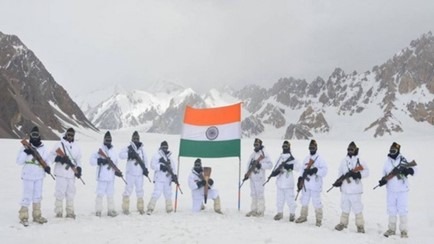
Significance of the Day
- Marks India’s occupation of key passes—Bilafond La and Sia La
- Demonstrates India’s strategic control over the Siachen Glacier
- Highlights the unyielding resolve of soldiers in extreme conditions
- Background of Operation Meghdoot
- Initiated to counter Pakistan’s cartographic aggression and its plans to capture strategic passes in the region
- Based on intelligence inputs that suggested Pakistan’s plan to seize the passes
- The Indian Army launched a pre-emptive strike on April 13, 1984
Key Leaders of the Operation
- Lieutenant General Manohar Lal Chibber
- Lieutenant General P.N. Hoon
- Major General Shiv Sharma
Role of the Indian Air Force (IAF)
- The IAF began operations in the Siachen region as early as 1978
- The Chetak helicopter was the first to land on the glacier in October 1978
- The IAF played a pivotal role in airlifting troops, supplies, and logistics
- Aircrafts used: An-12, An-32, IL-76, Mi-8, Mi-17, Chetak, Cheetah
Geopolitical Importance of Siachen
- Located at an altitude of 20,000 feet in the Karakoram Range
- Controls the Shaksgam Valley to the north, and key routes from Gilgit Baltistan to Leh (west)
- Also guards the Ancient Karakoram Pass (east)
- Borders Gilgit Baltistan, Shaksgam, and Ladakh
- Strategic Outcome of Operation Meghdoot
- India gained full control over the entire Siachen Glacier
- Prevented Pakistani intrusion in the uncharted territory beyond NJ9842
- Established a permanent Indian presence on the Frozen Frontier
Cultural & Emotional Resonance:
- The Indian Army continues to guard the glacier under extreme conditions, including sub-zero temperatures, avalanche risks, and isolated living conditions.
- Siachen Day stands as a reminder of the unparalleled bravery and commitment of Indian soldiers who defend the nation’s strategic interests in one of the harshest terrains on the planet.
Which of the following statements is/are correct regarding Siachen Day and Operation Meghdoot?
- Siachen Day is observed annually on April 13 to commemorate the launch of Operation Meghdoot in 1984.
- The operation was initiated by India in response to Pakistan’s plans to capture the Shaksgam Valley and key passes.
- The Indian Air Force played a critical role in airlifting troops and supplies during Operation Meghdoot, with the Chetak helicopter being the first to land on the Siachen Glacier in 1978.
- Operation Meghdoot resulted in India gaining control over the Siachen Glacier and preventing Pakistani intrusion in the uncharted region beyond NJ9842.]
A. 1, 2, and 3 only
B. 1, 3, and 4 only
C. 2 and 4 only
D. 1, 2, 3, and 4
Answer: D. 1, 2, 3, and 4
Explanation:
- Statement 1 is correct as Siachen Day is indeed observed on April 13 annually to honor the launch of Operation Meghdoot in 1984.
- Statement 2 is also correct. The operation was initiated to counter Pakistan’s strategic plans to capture key passes in the region, including the Shaksgam Valley.
- Statement 3 is correct. The Indian Air Force had already started operations in the Siachen region in 1978, with the Chetak helicopter being the first to land on the glacier in that year.
- Statement 4 is correct as the operation resulted in India establishing control over the entire Siachen Glacier and effectively blocking Pakistan’s access to the uncharted territory beyond NJ9842.
Siachen Day: Honouring the Bravehearts of the World’s Highest Battlefield
Syllabus:Geography
- Every year, on April 13, Siachen Day is observed to honor the courage, determination, and sacrifices of the Indian soldiers stationed at the Siachen Glacier, the highest and most challenging battlefield on earth.
- The day commemorates the launch of Operation Meghdoot in 1984, when the Indian Army successfully secured the glacier to thwart Pakistan’s efforts to capture strategic positions.
- This operation not only solidified India’s control over the Siachen region but also demonstrated remarkable cooperation between the Indian Army and the Indian Air Force (IAF).
- As the 41st anniversary of this monumental mission is observed in 2025, the valor and sacrifices of the Siachen Warriors continue to inspire and motivate generations of Indians.
Key Highlights
- Observed annually on April 13
- Commemorates the launch of Operation Meghdoot in 1984
- Pays tribute to the soldiers deployed at the Siachen Glacier

Significance of the Day
- Marks India’s occupation of key passes—Bilafond La and Sia La
- Demonstrates India’s strategic control over the Siachen Glacier
- Highlights the unyielding resolve of soldiers in extreme conditions
- Background of Operation Meghdoot
- Initiated to counter Pakistan’s cartographic aggression and its plans to capture strategic passes in the region
- Based on intelligence inputs that suggested Pakistan’s plan to seize the passes
- The Indian Army launched a pre-emptive strike on April 13, 1984
Key Leaders of the Operation
- Lieutenant General Manohar Lal Chibber
- Lieutenant General P.N. Hoon
- Major General Shiv Sharma
Role of the Indian Air Force (IAF)
- The IAF began operations in the Siachen region as early as 1978
- The Chetak helicopter was the first to land on the glacier in October 1978
- The IAF played a pivotal role in airlifting troops, supplies, and logistics
- Aircrafts used: An-12, An-32, IL-76, Mi-8, Mi-17, Chetak, Cheetah
Geopolitical Importance of Siachen
- Located at an altitude of 20,000 feet in the Karakoram Range
- Controls the Shaksgam Valley to the north, and key routes from Gilgit Baltistan to Leh (west)
- Also guards the Ancient Karakoram Pass (east)
- Borders Gilgit Baltistan, Shaksgam, and Ladakh
- Strategic Outcome of Operation Meghdoot
- India gained full control over the entire Siachen Glacier
- Prevented Pakistani intrusion in the uncharted territory beyond NJ9842
- Established a permanent Indian presence on the Frozen Frontier
Cultural & Emotional Resonance:
- The Indian Army continues to guard the glacier under extreme conditions, including sub-zero temperatures, avalanche risks, and isolated living conditions.
- Siachen Day stands as a reminder of the unparalleled bravery and commitment of Indian soldiers who defend the nation’s strategic interests in one of the harshest terrains on the planet.
Which of the following statements is/are correct regarding Siachen Day and Operation Meghdoot?
- Siachen Day is observed annually on April 13 to commemorate the launch of Operation Meghdoot in 1984.
- The operation was initiated by India in response to Pakistan’s plans to capture the Shaksgam Valley and key passes.
- The Indian Air Force played a critical role in airlifting troops and supplies during Operation Meghdoot, with the Chetak helicopter being the first to land on the Siachen Glacier in 1978.
- Operation Meghdoot resulted in India gaining control over the Siachen Glacier and preventing Pakistani intrusion in the uncharted region beyond NJ9842.]
A. 1, 2, and 3 only
B. 1, 3, and 4 only
C. 2 and 4 only
D. 1, 2, 3, and 4
Answer: D. 1, 2, 3, and 4
Explanation:
- Statement 1 is correct as Siachen Day is indeed observed on April 13 annually to honor the launch of Operation Meghdoot in 1984.
- Statement 2 is also correct. The operation was initiated to counter Pakistan’s strategic plans to capture key passes in the region, including the Shaksgam Valley.
- Statement 3 is correct. The Indian Air Force had already started operations in the Siachen region in 1978, with the Chetak helicopter being the first to land on the glacier in that year.
- Statement 4 is correct as the operation resulted in India establishing control over the entire Siachen Glacier and effectively blocking Pakistan’s access to the uncharted territory beyond NJ9842.
WAVES 2025 - Anti-Piracy Challenge
Syllabus:Geography
Context: The Anti-Piracy Challenge, a flagship programme under the Create in India Challenge, has been launched as part of WAVES 2025 (World Audio Visual and Entertainment Summit). Organised by the Ministry of Information and Broadcasting, the summit will be held in Mumbai, Maharashtra, from May 1 to 4, 2025. The initiative seeks to promote the development of advanced indigenous technologies to tackle digital piracy.

Objective of the Challenge:
The Anti-Piracy Challenge is specifically designed to encourage innovation in digital content protection, focusing on technologies such as digital fingerprinting, watermarking, and other mechanisms to counteract the increasing threat of piracy in India’s growing digital entertainment ecosystem.
About WAVES 2025:
WAVES is a premier global platform initiated by the Government of India to position the country as a leader in media innovation, intellectual property (IP) creation, and digital content development. The event showcases India’s capabilities across a wide array of sectors, including:
- Traditional Media: Broadcasting, Television, Radio, Films
- Digital and Creative Arts: Animation, Gaming, Comics, Advertising
- Emerging Technologies: Generative AI, Augmented/Virtual/Extended Reality (AR/VR/XR), Digital Platforms
Significance of the Initiative:
- The initiative aligns with India’s broader vision to harness the creative economy, currently valued at USD 30 billion, which supports nearly 8% of the national workforce.
- It reinforces India’s strategic push toward self-reliance in the Media and Entertainment (M&E) sector, which is projected to grow to USD 44.2 billion by 2028, already ranking as the 5th largest globally.
- Through initiatives like the Anti-Piracy Challenge and WAVES 2025, the Government seeks to foster a robust framework for content innovation, employment generation, and technological leadership in digital media.
With reference to the “Anti-Piracy Challenge” under the Create in India initiative, consider the following statements:
- The Anti-Piracy Challenge is a key component of the WAVES 2025 summit aimed at promoting indigenous innovation in digital content security.
- The challenge is primarily focused on advancing technologies like fingerprinting and watermarking to combat the rise of digital piracy in India’s entertainment sector.
- WAVES 2025 will be held in New Delhi, and it covers only the sectors of broadcasting and television.
- The initiative aims to position India as a global leader in the creative economy, which is expected to contribute significantly to the Media and Entertainment sector.
Which of the statements given above is/are correct?
A. 1, 2, and 4 only
B. 1 and 3 only
C. 2 and 4 only
D. 1, 2, 3, and 4
Answer: A. 1, 2, and 4 only
Explanation:
- Statement 1 is correct. The Anti-Piracy Challenge is indeed a flagship initiative under the Create in India programme, which will be highlighted during the WAVES 2025
- Statement 2 is correct. The initiative aims to enhance fingerprinting and watermarking technologies to address digital piracy in India’s entertainment sector.
- Statement 3 is incorrect. WAVES 2025 is to be held in Mumbai, not New Delhi, and it encompasses a wide array of sectors, not just broadcasting and television.
- Statement 4 is correct. The initiative aligns with India’s broader goal of becoming a global leader in the creative economy, which plays a pivotal role in the growing Media and Entertainment sector.
Dr. D. Nageshwar Reddy Honoured with ‘Legends of Endoscopy’ Award in Tokyo
Syllabus: Awards
- In a moment of international recognition for Indian medical excellence, D. Nageshwar Reddy, Chairman of AIG Hospitals, Hyderabad, has been conferred with the prestigious ‘Legends of Endoscopy’ award.
- The honor was bestowed upon him by a distinguished community of Japanese gastroenterologists at the Tokyo Live Global Endoscopy 2025 event, held at SHOWA Medical University Koto Toyosu Hospital in Tokyo, Japan.
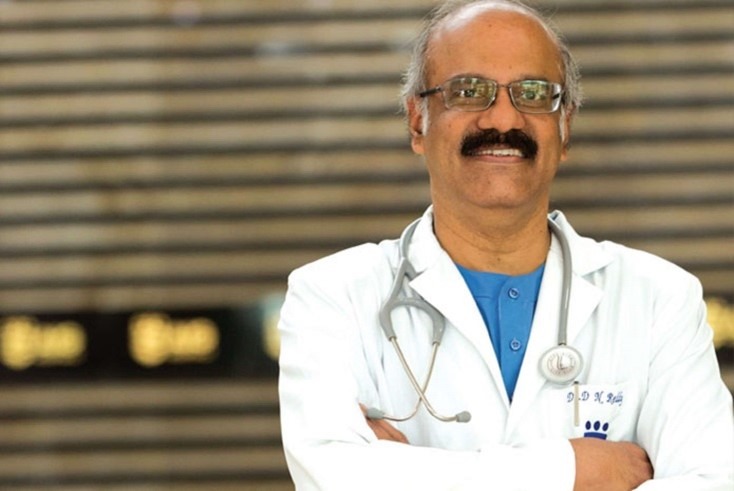
Key Highlights
Award Recognition
- Title: Legends of Endoscopy
- Recipient: D. Nageshwar Reddy
- Institution: AIG Hospitals, Hyderabad
- Awarding Body: Japanese gastroenterology community
- Event: Tokyo Live Global Endoscopy 2025
- Venue: SHOWA Medical University, Tokyo
Contributions Recognized
- Renowned for his pioneering advancements in Gastrointestinal (GI) Endoscopy
- Demonstrated live complex endoscopic procedures, showcasing cutting-edge minimally invasive techniques
- Advocated for innovation and precision in endoscopic diagnostics and therapies
Global Significance
- Reinforces India’s leadership in advanced GI treatments and minimally invasive medical technologies
- Highlights Dr. Reddy’s influence as a global thought leader in therapeutic and diagnostic endoscopy
About AIG Hospitals
- AIG (Asian Institute of Gastroenterology) Hospitals, based in Hyderabad, is a leading super-specialty institution specializing in gastroenterology
- Known for its high-end clinical research, innovation, and world-class treatment protocols.
Consider the following statements regarding the recent international recognition received by Dr. D. Nageshwar Reddy:
- The award was conferred by a Japanese governmental medical body.
- It highlights India’s advancements in minimally invasive gastroenterological techniques.
- The venue of the award event is located in Tokyo’s leading endoscopy-specific institution.
- AIG Hospitals, under Dr. Reddy’s leadership, is primarily focused on general medicine and surgical oncology.
Which of the above statements is/are correct?
A) 2 only
B) 2 and 3 only
C) 1, 2 and 4 only
D) 2, 3 and 4 only
Answer: B) 2 and 3 only
Explanation:
- Statement 1 is incorrect: The award was given by a professional gastroenterology community, not a government body.
- Statement 2 is correct: His work is in minimally invasive GI endoscopy.
- Statement 3 is correct: The SHOWA Medical University Koto Toyosu Hospital is a prominent center for live endoscopy events.
- Statement 4 is incorrect: AIG Hospitals focuses on gastroenterology, not general medicine or oncology.
Dr. D. Nageshwar Reddy Honoured with ‘Legends of Endoscopy’ Award in Tokyo
Syllabus: Awards
- In a moment of international recognition for Indian medical excellence, D. Nageshwar Reddy, Chairman of AIG Hospitals, Hyderabad, has been conferred with the prestigious ‘Legends of Endoscopy’ award.
- The honor was bestowed upon him by a distinguished community of Japanese gastroenterologists at the Tokyo Live Global Endoscopy 2025 event, held at SHOWA Medical University Koto Toyosu Hospital in Tokyo, Japan.

Key Highlights
Award Recognition
- Title: Legends of Endoscopy
- Recipient: D. Nageshwar Reddy
- Institution: AIG Hospitals, Hyderabad
- Awarding Body: Japanese gastroenterology community
- Event: Tokyo Live Global Endoscopy 2025
- Venue: SHOWA Medical University, Tokyo
Contributions Recognized
- Renowned for his pioneering advancements in Gastrointestinal (GI) Endoscopy
- Demonstrated live complex endoscopic procedures, showcasing cutting-edge minimally invasive techniques
- Advocated for innovation and precision in endoscopic diagnostics and therapies
Global Significance
- Reinforces India’s leadership in advanced GI treatments and minimally invasive medical technologies
- Highlights Dr. Reddy’s influence as a global thought leader in therapeutic and diagnostic endoscopy
About AIG Hospitals
- AIG (Asian Institute of Gastroenterology) Hospitals, based in Hyderabad, is a leading super-specialty institution specializing in gastroenterology
- Known for its high-end clinical research, innovation, and world-class treatment protocols.
Consider the following statements regarding the recent international recognition received by Dr. D. Nageshwar Reddy:
- The award was conferred by a Japanese governmental medical body.
- It highlights India’s advancements in minimally invasive gastroenterological techniques.
- The venue of the award event is located in Tokyo’s leading endoscopy-specific institution.
- AIG Hospitals, under Dr. Reddy’s leadership, is primarily focused on general medicine and surgical oncology.
Which of the above statements is/are correct?
A) 2 only
B) 2 and 3 only
C) 1, 2 and 4 only
D) 2, 3 and 4 only
Answer: B) 2 and 3 only
Explanation:
- Statement 1 is incorrect: The award was given by a professional gastroenterology community, not a government body.
- Statement 2 is correct: His work is in minimally invasive GI endoscopy.
- Statement 3 is correct: The SHOWA Medical University Koto Toyosu Hospital is a prominent center for live endoscopy events.
- Statement 4 is incorrect: AIG Hospitals focuses on gastroenterology, not general medicine or oncology.
Military Personals Honored With Prestigious MacGregor Memorial Medal
Syllabus:Awards
- Five exceptional military personnel were conferred the prestigious MacGregor Memorial Medal for the years 2023 and 2024, recognising their outstanding contributions to military reconnaissance, adventure, and exploratory missions.
- The awards were presented by Chief of Defence Staff (CDS) General Anil Chauhan at a solemn ceremony hosted by the United Service Institution of India (USI) in New Delhi.
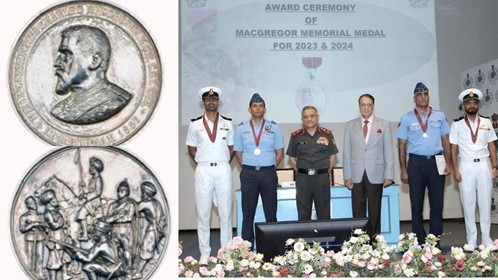
About the MacGregor Memorial Medal
- Established: July 3, 1888
- Named After: Major General Sir Charles Metcalfe MacGregor, founder of USI (established in 1870)
- Original Objective: To honour military officers who undertook significant exploratory and reconnaissance journeys.
- Expanded Scope (Post-1986): Includes military expeditions and adventure activities across terrains and environments.
- Eligibility: Open to all ranks (serving or retired) of the Armed Forces, Territorial Army, Reserve Forces, Rashtriya Rifles, and Assam Rifles.
- Total Medals Awarded: 127 (including 103 before Independence)
2023 Recipients
- Wing Commander D. Panda – Indian Air Force
- Electrical Artificer (Radio) Rahul Kumar Pandey – Indian Navy
2024 Recipients
- Chief Electrical Aircraft Artificer (Radio) Ram Ratan Jat – Indian Navy
- Sergeant Jhumar Ram Poonia – Indian Air Force
- Colonel Ranvir Singh Jamwal – Director, National Institute of Mountaineering and Adventure Sports (NIMAS), Arunachal Pradesh
- Note: Col. Jamwal is currently on an expedition to Kangchenjunga
Book Launch at the Ceremony
- Title: Bravest of the Brave
- Author: Gen. Satish Dua (Retd.)
- Subject: Chronicles the heroic life of Naib Subedar Chunni Lal, a Param Vir Chakra awardee, highlighting his valour and sacrifices.
With reference to the MacGregor Memorial Medal, consider the following statements:
- It was instituted by the Indian government post-Independence to recognise acts of gallantry in warfare.
- It is awarded to serving personnel only from the Indian Army.
- The medal also honours exploratory and adventure activities undertaken by military personnel.
- Colonel Ranvir Singh Jamwal, a 2024 recipient, is currently leading an expedition to Mt. Kangchenjunga.
Which of the statements given above are correct?
A) 1 and 2 only
B) 3 and 4 only
C) 2, 3 and 4 only
D) 1, 3 and 4 only
Answer: B) 3 and 4 only
Explanation:
- Statement 1 is incorrect – The medal was instituted in 1888 during British rule, not post-Independence.
- Statement 2 is incorrect – It is open to personnel from all branches: Army, Navy, Air Force, as well as Reserve and paramilitary forces.
- Statements 3 and 4 are correct – The scope was expanded post-1986 to include adventure/exploration; Col. Jamwal is currently on a Mt. Kangchenjunga expedition.
GPS Spoofing
Syllabus:Security
- Indian Air Force (IAF) aircraft delivering humanitarian aid to earthquake-hit Myanmar under Operation Brahma reportedly encountered GPS spoofing attacks, raising critical concerns over airspace cybersecurity and navigational safety.

What is GPS Spoofing?
- GPS spoofing is a form of cyberattack wherein deceptive GPS signals are broadcast to trick a receiver into computing a false position.
How It Works:
- GPS receivers determine location by triangulating signals from multiple satellites.
- Spoofers emit counterfeit signals that are stronger than authentic satellite signals.
- The receiver locks onto these fake signals, leading to mislocation or navigation errors.
Implications of GPS Spoofing:
- Aviation Safety:
- Aircraft may be misdirected, especially in foreign or conflict-prone airspaces.
- Risks include mid-air navigation errors, loss of situational awareness, and compromised emergency response.
- Strategic & Defense Threats:
- Military aircraft, UAVs, and reconnaissance missions can be diverted or deceived, undermining national security.
- Potential for hostile interventions or surveillance manipulation.
- Civilian Infrastructure Disruption:
- Rideshare apps, logistics networks, and delivery services may provide erroneous routing.
- Can result in economic losses, public inconvenience, and emergency response delays.
- Cybersecurity Concerns:
- Spoofing attacks can be a vector for larger breaches, including data theft, identity spoofing, and critical system interference.
With reference to GPS spoofing, consider the following statements:
- GPS spoofing attacks rely on sending encrypted signals that overpower legitimate satellite transmissions.
- Such attacks pose a higher threat to military operations than to civilian navigation systems.
- Multi-constellation GNSS receivers can help detect spoofing by cross-verifying signals from multiple satellite networks.
- The Indian Air Force (IAF) has demonstrated operational resilience against GPS spoofing during cross-border humanitarian missions.
Which of the above statements are correct?
A) 1, 2 and 3 only
B) 2, 3 and 4 only
C) 1, 3 and 4 only
D) 1, 2, 3 and 4
Correct Answer: B) 2, 3 and 4 only
Explanation:
- Statement 1 – Incorrect: GPS spoofing uses unencrypted false signals that mimic real GPS transmissions, not encrypted ones. The aim is to deceive the receiver, not decode or overpower secure signals.
- Statement 2 – Correct: Military and defense systems heavily depend on precise location data, often in contested environments. GPS spoofing can mislead operations, drones, or aircraft, posing greater strategic risks than in civilian systems.
- Statement 3 – Correct: GNSS receivers that use multiple satellite systems (GPS, GLONASS, Galileo, IRNSS) can compare inconsistencies and flag suspicious readings, helping detect spoofing.
- Statement 4 – Correct: As reported, IAF pilots successfully navigated GPS spoofing threats during Operation Brahma, showcasing preparedness and resilience in handling cyber-navigation warfare.
Jatra Utsav
Syllabus: GS1/ History and Culture
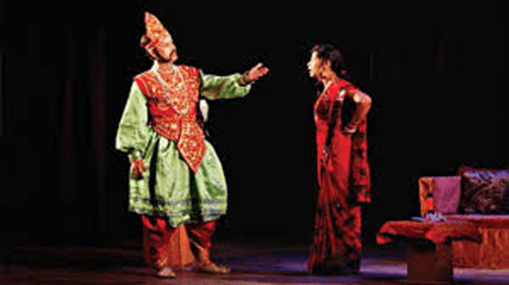
Context:
- Tripura is set to host a Jatra Utsav aimed at preserving its traditional art forms, culture, and heritage.
\
AboutJatra: Jatra, or Jatrapala, is a widely recognized traditional Bengali folk theatre form, typically performed in open-air settings, encouraging interaction with the audience.
The term “Jatra” means “journey,” which reflects its origins as a traveling theatrical performance.
Region: Jatrapala is most popular in the regions of West Bengal, Odisha, Assam, and Tripura, showcasing the rich cultural and linguistic heritage of these areas.
Features:Jatra combines dramatic storytelling with music, dance, and social commentary.
The performances are known for their vibrant costumes, expressive gestures, loud dialogues, and often convey moral lessons.
Themes:The performances typically focus on mythological tales, historical narratives, and contemporary social issues.
With reference to the traditional Bengali folk theatre form “Jatra” or “Jatrapala,” which of the following statements is/are correct?
- Jatra performances are primarily performed indoors, with limited interaction with the audience.
- The word “Jatra” refers to “journey,” indicating its origins as a traveling theatrical performance.
- The performances are known for their elaborate costumes, exaggerated gestures, and moral messaging.
- Jatra is only popular in West Bengal, with no significant presence in other states.
Select the correct answer using the code below:
A. 1 and 2 only
B. 2 and 3 only
C. 1, 2, and 3 only
D. 1, 2, 3, and 4
Answer: B
Explanation:
- Statement 1 is incorrect: Jatra is typically performed in open-air settings with audience interaction.
- Statement 2 is correct: The word “Jatra” means “journey,” which reflects its origins as a traveling theatrical performance.
- Statement 3 is correct: Jatra is characterized by elaborate costumes, dramatic gestures, and moral or social messaging.
- Statement 4 is incorrect: Jatra is popular in several states, including West Bengal, Odisha, Assam, and Tripura.
Mahavir Jayanti
Syllabus: GS 1/History, Famous Personalities
- Mahavir Jayanti is being celebrated with great devotion across India to commemorate the birth of Lord Mahavir, the 24th and last Tirthankara (teacher) of Jainism.
- This significant occasion serves as a reminder for followers of Jainism to reflect upon and embrace the core principles taught by Lord Mahavir.
- The celebration includes prayers, meditation, and compassionate acts, encouraging individuals to lead an ethical life and show kindness to all living beings.
- Mahavir Jayanti is primarily observed by Jains in India, Nepal, the United States, and the United Kingdom.
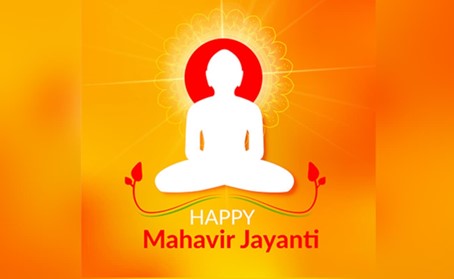
VardhamanMahavira:
- Lord Mahavir, also known as Vardhaman, is regarded as the founder of Jainism. He was born in 599 BC at Vaishali, the capital of the Vajji tribe.
- His father, Siddhartha, was the chief of a Kshatriya clan. Mahavir left his royal life at the age of thirty to pursue spiritual awakening, enduring a life of austerity to gain true knowledge.
- After achieving supreme wisdom, he came to be known as Mahavir.
- Mahavir was deeply committed to the practice of celibacy (brahmacharya) and believed strongly in the importance of living a disciplined and ethical life.
Philosophy and Teachings
- Lord Mahavir rejected the belief in a personal god, rituals, and the caste system, advocating for equality among all people.
- He taught four primary vows: non-violence (Ahimsa), truthfulness (Satya), non-attachment (Aparigraha), and non-stealing (Asteya).
- He emphasized the path of Right Belief, Right Knowledge, and Right Conduct as the key to attaining Moksha—liberation from the cycle of birth and rebirth.
- His central tenet, Ahimsa (non-violence), influenced practices like vegetarianism and extreme care in avoiding harm to even the smallest life forms.
- Mahavir spent much of his life preaching across regions like Anga, Mithila, Magadha, and Kosala. He passed away in 527 BC at Pawapuri.
Did You Know?
- The term Jaina comes from the Sanskrit word Jina, meaning “the conqueror”—one who has conquered passion and desire. Mahavir is called Jina after he attained supreme realization.
- Mahavir’s teachings gained widespread acceptance due to his use of the common language, Ardha Magadhi.
- Jainism eventually split into two main sects: Digambaras (sky-clad) and Swetambaras (white-clad).
- Notable kings like Bimbisara and Ajatsatru embraced Jainism, and under their patronage, Jain art, architecture, and literature flourished.
Which of the following statements regarding Lord Mahavir and Jainism is/are correct?
- Lord Mahavir was born in 599 BC at Vaishali, the capital of the Vajji tribe.
- Mahavir’s teachings rejected the belief in God, rituals, and the caste system, advocating equality among all people.
- Mahavir’s teachings were delivered in Sanskrit, the classical language of the Indian subcontinent.
- Jainism later split into two sects: Digambaras and Swetambaras.
Select the correct answer using the code below:
A) 1, 2, and 4 only
B) 1, 2, and 3 only
C) 2, 3, and 4 only
D) 1, 2, 3, and 4
Answer: A) 1, 2, and 4 only
Explanation:
- Statement 1 is correct: Lord Mahavir was born in 599 BC at Vaishali, the capital of the Vajji tribe.
- Statement 2 is correct: Mahavir rejected belief in God, rituals, and the caste system, advocating equality among all people.
- Statement 3 is incorrect: Mahavir’s teachings were delivered in Ardha Magadhi, not Sanskrit.
- Statement 4 is correct: Jainism split into two sects: Digambaras (sky-clad) and Swetambaras (white-clad).
Chittorgarh Fort
Syllabus: GS1/History
Context: The Rajasthan government has informed the Supreme Court that it is “actively considering” a complete ban on mining activities within 10 kilometers of the outer boundary of the historic Chittorgarh Fort.
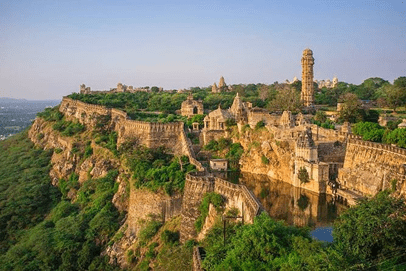
About Chittorgarh Fort:
- Chittorgarh Fort, one of the largest forts in India, was originally built in the 7th century AD by Chitrangada Mori, a ruler from the Maurya dynasty of Rajasthan.
Historical Significance:
- In 728 AD, the fort was captured by the rulers of Mewar, who made it their capital and transformed it into a symbol of Rajput power and resistance.
- The fort’s history is famously depicted in Malik Muhammad Jayasi’s epic Padmavat, which tells of the siege by Alauddin Khilji, who sought to capture Queen Padmini, wife of Rana Ratan Singh.
UNESCO Recognition:
- In 2013, the fort was designated as a UNESCO World Heritage Site under the “Hill Forts of Rajasthan” category due to its historical importance.
Architectural Features:
- The fort is accessed through seven massive gates (pols), surrounded by thick stone walls and strong ramparts for defense.
Notable structures inside the fort include:
- Vijay Stambh (Victory Tower): Built by Rana Kumbha to commemorate his victory over Malwa. It stands 9 stories tall, featuring intricate carvings.
- Kirti Stambh (Tower of Fame): Dedicated to Jain Tirthankaras and adorned with Jain sculptures.
With reference to Chittorgarh Fort, consider the following statements:
- It was originally built by a ruler of the Rajput Sisodia dynasty.
- The fort was designated a UNESCO World Heritage Site under the category of “Hill Forts of Rajasthan.”
- The Kirti Stambh inside the fort is dedicated to Jain Tirthankaras.
Which of the statements given above is/are correct?
A. 1 and 2 only
B. 2 and 3 only
C. 1 and 3 only
D. 1, 2 and 3
Answer:B
Explanation:
- Statement 1 is incorrect: The fort was originally built by Chitrangada Mori of the Maurya dynasty, not the Sisodia Rajputs.
- Statement 2 is correct: Chittorgarh Fort was declared a UNESCO World Heritage Site in 2013 under the “Hill Forts of Rajasthan”.
- Statement 3 is correct: Kirti Stambh is dedicated to Jain Tirthankaras.
Kathak
Syllabus: Art /Culture
- Renowned Kathak Dancer Kumudini Lakhia Passes Away at 94
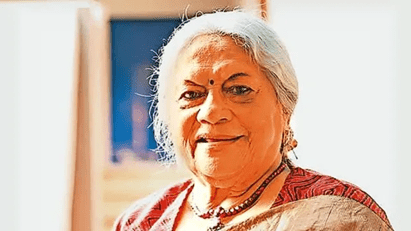
About Kathak
- Etymology: The term Kathak is derived from the Sanskrit word Katha, which means story.
- Nature of Performance: Initially performed as a temple dance, Kathak evolved into a court dance during the Mughal period, with stories from scriptures being portrayed through intricate movements.
- Major Gharanas: Prominent Kathak schools or gharanas include the Lucknow, Jaipur, and Benaras gharanas.
- Dance Style: The focus in Kathak lies on footwork (Tatkaar), pirouettes (Chakkars), mudras, and facial expressions. Dancers traditionally wear ankle bells (ghungroos) to accentuate their rhythmic footwork.
Musical Association
- Kathak is the only classical dance form directly associated with Hindustani (North Indian) music.
- Mughal Influence: Under the patronage of the Mughal court, Kathak transformed into a refined art form, focusing on grace and intricate rhythmic patterns.
Patronage
- The dance form received immense support from Wajid Ali Shah, the last Nawab of Awadh, who played a key role in its development.
- Prominent Exponents
- Birju Maharaj, Sitara Devi, Shovana Narayan, and Aditi Mangaldas are among the renowned exponents of Kathak.
Kumudini Lakhia’s Contributions to Kathak
- Kumudini Lakhia was a revolutionary figure in the world of Kathak. She defied traditional norms by moving away from the classical focus on mythological narratives like Radha-Krishna and Shiva-Parvati.
- She believed in “art for art’s sake,” emphasizing movement, rhythm, and form rather than relying on storytelling.
- Transformation of the Art: Over a distinguished career spanning seven decades, she played a crucial role in transforming Kathak from a solo, narrative-based performance to a group ensemble format, exploring contemporary and abstract themes.
- Awards and Recognition: Kumudini Lakhia’s exceptional contribution to the dance world earned her the Padma Shri in 1987, Padma Bhushan in 2010, and Padma Vibhushan in 2024, making her one of the most highly regarded figures in Indian classical dance.
Which of the following statements about Kathak dance and its evolution are correct?
- Kathak originated as a temple performance, depicting stories from scriptures, and later evolved into a court dance during the Mughal period.
- The dance form primarily focuses on storytelling through narrative content like Radha-Krishna or Shiva-Parvati.
- Kumudini Lakhia’s contribution to Kathak involved transforming the dance from a solo, narrative-based form to a group ensemble format.
- Kathak is exclusively associated with Hindustani (North Indian) music and has no ties to the Mughal courts.
Select the correct answer using the code below:
(a) 1 and 3 only
(b) 2 and 4 only
(c) 1, 3, and 4 only
(d) 1, 2, and 3 only
Answer: (a) 1 and 3 only
Explanation:
- Statement 1 is correct because Kathak originated as a temple performance and evolved under the Mughal influence into a court dance.
- Statement 2 is incorrect because Kumudini Lakhia challenged the classical focus on narrative themes and emphasized movement, rhythm, and form.
- Statement 3 is correct as Kumudini Lakhia revolutionized Kathak by transforming it into a group ensemble form.
- Statement 4 is incorrect as Kathak is deeply associated with both Hindustani music and Mughal influence, particularly during the Mughal court period.
West Bengal CM Mamata Banerjee Will Inaugurate Jagannath Temple in Digha
Syllabus: Art and Culture
- West Bengal is gearing up for a significant religious and cultural event—the inauguration of the Jagannath Dham Temple in Digha, one of the state’s most popular coastal towns.
- Scheduled for April 30, 2025, the event will be inaugurated by Chief Minister Mamata Banerjee and is expected to attract a massive turnout, including political dignitaries, industrialists, film personalities, and thousands of devotees.
Key Highlights
Event Details
- Occasion: Inauguration of Jagannath Dham Temple
- Date: April 30, 2025
- Location: Digha, Purba Medinipur district, West Bengal
- Chief Guest: Mamata Banerjee, Chief Minister of West Bengal
- Expected Attendance: 12,000–14,000 people
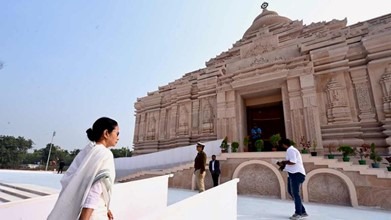
VIP and Dignitary Participation
- Participation of Chief Ministers from other states
- Top political and administrative leaders
- Leading industrialists and film celebrities
Accommodation and Hospitality
- Government guesthouses in Digha reserved exclusively for VIPs from April 27 to May 1
- General public barred from staying in government accommodations during this period
- Private hotels and lodges experiencing high demand
Logistics & Infrastructure Preparedness
- Two temporary helipads under construction in addition to the existing one
- Emphasis on stage design, lighting, sound, and transport
- Enhanced security, emergency medical teams, and traffic management plans in place
Administrative Coordination
- Continuous oversight by senior IAS officers and state officials
- Coordination by the Digha-Shankarpur Development Corporation for accommodation logistics
Cultural and Strategic Significance
- This event underscores West Bengal’s emphasis on cultural heritage and religious tourism, with the Jagannath Dham in Digha poised to become a major spiritual destination.
- It also reflects the state’s intent to position Digha as a hub for pilgrimage and leisure tourism, contributing to local economy and infrastructure development.
Which of the following statements about the newly inaugurated Jagannath Dham Temple in West Bengal are correct?
- It is located in the coastal town of Digha.
- The inauguration is scheduled for April 30, 2025.
- Prime Minister of India is the chief guest at the inauguration ceremony.
- Government guesthouses in Digha have been reserved exclusively for general public during the event.
Select the correct answer using the code below:
A) 1 and 2 only
B) 1, 2, and 3 only
C) 1, 2, and 4 only
D) 2 and 3 only
Answer: A) 1 and 2 only
Explanation:
- The temple is located in Digha and the inauguration is on April 30, 2025.
- The Chief Minister of West Bengal, not the Prime Minister, is the chief guest. Government guesthouses are reserved for dignitaries, not the general public.
West Bengal CM Mamata Banerjee Will Inaugurate Jagannath Temple in Digha
Syllabus: Art and Culture
- West Bengal is gearing up for a significant religious and cultural event—the inauguration of the Jagannath Dham Temple in Digha, one of the state’s most popular coastal towns.
- Scheduled for April 30, 2025, the event will be inaugurated by Chief Minister Mamata Banerjee and is expected to attract a massive turnout, including political dignitaries, industrialists, film personalities, and thousands of devotees.
Key Highlights
Event Details
- Occasion: Inauguration of Jagannath Dham Temple
- Date: April 30, 2025
- Location: Digha, Purba Medinipur district, West Bengal
- Chief Guest: Mamata Banerjee, Chief Minister of West Bengal
- Expected Attendance: 12,000–14,000 people

VIP and Dignitary Participation
- Participation of Chief Ministers from other states
- Top political and administrative leaders
- Leading industrialists and film celebrities
Accommodation and Hospitality
- Government guesthouses in Digha reserved exclusively for VIPs from April 27 to May 1
- General public barred from staying in government accommodations during this period
- Private hotels and lodges experiencing high demand
Logistics & Infrastructure Preparedness
- Two temporary helipads under construction in addition to the existing one
- Emphasis on stage design, lighting, sound, and transport
- Enhanced security, emergency medical teams, and traffic management plans in place
Administrative Coordination
- Continuous oversight by senior IAS officers and state officials
- Coordination by the Digha-Shankarpur Development Corporation for accommodation logistics
Cultural and Strategic Significance
- This event underscores West Bengal’s emphasis on cultural heritage and religious tourism, with the Jagannath Dham in Digha poised to become a major spiritual destination.
- It also reflects the state’s intent to position Digha as a hub for pilgrimage and leisure tourism, contributing to local economy and infrastructure development.
Which of the following statements about the newly inaugurated Jagannath Dham Temple in West Bengal are correct?
- It is located in the coastal town of Digha.
- The inauguration is scheduled for April 30, 2025.
- Prime Minister of India is the chief guest at the inauguration ceremony.
- Government guesthouses in Digha have been reserved exclusively for general public during the event.
Select the correct answer using the code below:
A) 1 and 2 only
B) 1, 2, and 3 only
C) 1, 2, and 4 only
D) 2 and 3 only
Answer: A) 1 and 2 only
Explanation:
- The temple is located in Digha and the inauguration is on April 30, 2025.
- The Chief Minister of West Bengal, not the Prime Minister, is the chief guest. Government guesthouses are reserved for dignitaries, not the general public.
World Heritage Day 2025
Syllabus: GS3/ History and Culture
- Theme 2024: “Heritage under Threat from Disasters and Conflicts: Preparedness and Learning from 60 years of ICOMOS Actions”

Background
- Proposed by the International Council on Monuments and Sites (ICOMOS) in 1982
- Officially approved by UNESCO in 1983
- Observed annually to raise awareness about preserving cultural heritage
World Heritage Sites
- Sites of outstanding universal value inscribed on the UNESCO World Heritage List
- Can be cultural, natural, or mixed
- Protected under the 1972 World Heritage Convention
- India became a signatory in 1977
India on the World Heritage Map
- Home to numerous UNESCO World Heritage Sites and Monuments of National Importance
- Monuments of National Importance (MNI):
- Protected under the AMASR Act, 2010
- Conserved by the Archaeological Survey of India (ASI)
- Total MNIs: 3,697
Key Government Initiatives
- Retrieval of Antiquities: 655 artefacts recovered from abroad (1976–2024)
- Adopt a Heritage Scheme: Launched in 2017; revamped in 2023 to involve private/public entities in monument upkeep
- Must-See Portal: Digital platform to promote iconic monuments
- Digitization: National Mission on Monuments and Antiquities (NMMA) is documenting and digitizing heritage assets
- 46th World Heritage Committee Session: Hosted by ASI in 2024, showcasing India’s global cultural leadership
Conclusion: World Heritage Day is a reminder of our collective duty to protect and cherish cultural treasures. Through national commitment and global cooperation, India continues to safeguard its rich heritage for future generations.
Which of the following statements regarding the World Heritage Convention, 1972 is/are correct?
- It is legally binding only on cultural sites and not natural sites.
- It obligates signatory States to report periodically on the conservation status of World Heritage Sites.
- India became a signatory to the Convention even before it was adopted by UNESCO.
Select the correct answer using the code below:
A. 1 only
B. 2 only
C. 1 and 3 only
D. 2 and 3 only
Answer: B. 2 only
Explanation:
- Statement 1 is incorrect: The Convention is applicable to cultural, natural, and mixed sites.
- Statement 2 is correct: Periodic reporting on the conservation status is a mandatory obligation under the convention.
- Statement 3 is incorrect: The convention was adopted in 1972 and India joined in 1977, after its adoption.
Guru Tegh Bahadur
Syllabus: GS1/History
- The Prime Minister paid tribute to Sri Guru Tegh Bahadur on the occasion of his Parkash Purab, honouring his legacy of sacrifice and spiritual leadership.
- Sri Guru Tegh Bahadur: A Life of Courage and Compassion
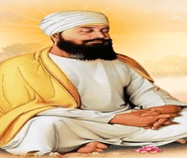
Early Life
- Born on 1 April 1621 in Amritsar, Guru Tegh Bahadur was the ninth Sikh Guru and the youngest son of Guru Hargobind Sahib.
- Originally named Tyag Mal, he earned the title “Tegh Bahadur” (Brave Wielder of the Sword) for his valour in battle.
- He married Mata Gujri and was the father of Guru Gobind Singh, the tenth Sikh Guru.
Spiritual Journey and Teachings
- Guru Tegh Bahadur led a life dedicated to meditation, spiritual wisdom, and selfless service.
- He travelled extensively across the Indian subcontinent, spreading the teachings of Sikhism, promoting social reform, and establishing preaching centres.
- Martyrdom and Sacrifice
- In 1675, Guru Tegh Bahadur was martyred in Delhi under the orders of Mughal Emperor Aurangzeb.
- He sacrificed his life to defend the religious freedom of Kashmiri Pandits and others, refusing to convert to Islam.
- His supreme sacrifice earned him the title “Hind di Chadar” – the Shield of India.
Legacy and Contribution
- A profound philosopher and poet, his hymns included in the Guru Granth Sahib emphasize fearlessness, devotion, compassion, and righteousness.
- His martyrdom became a powerful symbol of resistance to religious persecution and inspired the creation of the Khalsa by his son Guru Gobind Singh.
- Guru Tegh Bahadur’s legacy continues to inspire generations in the fight for justice and the upholding of human rights.
Consider the following statements about Guru Tegh Bahadur:
- He was the son of Guru Arjan Dev and the father of Guru Gobind Singh.
- He was martyred during the reign of Aurangzeb for opposing religious conversions.
- His teachings are not included in the Guru Granth Sahib.
Which of the statements given above is/are correct?
A. 1 and 2 only
B. 2 only
C. 2 and 3 only
D. 1, 2 and 3
Answer:B
Explanation:
- Statement 1 is incorrect: Guru Tegh Bahadur was the son of Guru Hargobind, not Guru Arjan Dev.
- Statement 2 is correct: He was executed by Aurangzeb for refusing to convert and defending the religious freedom of Hindus.
- Statement 3 is incorrect: His hymns are indeed included in the Guru Granth Sahib.
Bhagavad Gita and Natyashastra Added to UNESCO’s Memory of the World Register
Syllabus: GS1/ Art & Culture
- The Bhagavad Gita and Bharat Muni’s Natyashastra manuscripts have been inscribed in UNESCO’s Memory of the World Register.
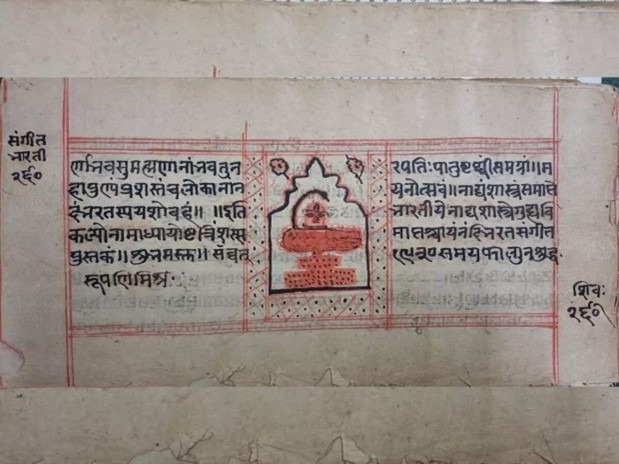
About UNESCO’s Memory of the World (MoW) Register
- Established: 1992 by UNESCO.
- Purpose: Safeguard rare manuscripts, archival records, and documentary heritage of universal significance from neglect, decay, and loss.
Criteria for Inclusion:
- Outstanding universal value
- Historical, cultural, or social significance
- Authenticity, integrity, and rarity
- As of 2025: The register includes 570 collections from 72 countries and 4 international organizations.
About the Newly Inscribed Indian Manuscripts
- Bhagavad Gita
- Meaning: “The Song of the Lord”
- Attributed to: Sage Vyasa
- Context: Part of the Mahabharata; a dialogue between Krishna and Arjuna on the battlefield of Kurukshetra.
Core Themes:
- Dharma (righteous duty)
- Karma (action)
- Bhakti (devotion)
- Jnana (knowledge)
Significance:
- Foundation of Indian philosophical thought.
- Influenced global thinkers such as Mahatma Gandhi, Albert Einstein, and Aldous Huxley.
- Natyashastra
- Author: Sage Bharat Muni
- Period: ~200 BCE to 200 CE
- Nature: Treatise on performing arts—drama, dance, music
Major Concepts:
- Rasa Theory: Describes 9 emotions (Shringara, Karuna, Veera, etc.) essential to artistic expression.
Technical details on:
- Stagecraft
- Acting & Gestures (Mudras)
- Costumes & Makeup
- Musical instruments
Impact:
- Blueprint for classical Indian dance forms like Bharatanatyam, Kathak, etc.
- Foundation for Indian theatre and performance traditions.
India’s Presence in the MoW Register
- With these inclusions, India now has 14 entries in the UNESCO Memory of the World Register.
- Recent Indian additions to the 2024 MOWCAP (Asia-Pacific Regional Register) include:
- Ramcharitmanas
- Panchatantra
- Sahrdayāloka-Locana
Which of the following statements about UNESCO’s Memory of the World Register is/are correct?
- It aims to protect documentary heritage of exceptional value from destruction and neglect.
- It includes only manuscripts from member states of UNESCO.
- The Bhagavad Gita and Natyashastra were added to the register in 2025.
Select the correct answer using the codes below:
A. 1 only
B. 1 and 3 only
C. 2 and 3 only
D. 1, 2 and 3
Answer: B. 1 and 3 only
Explanation:
- Statement 1 is correct: The register preserves heritage with universal significance.
- Statement 2 is incorrect: It is open to UNESCO and non-UNESCO members, as well as international organizations.
- Statement 3 is correct: Both manuscripts were inscribed in 2025
